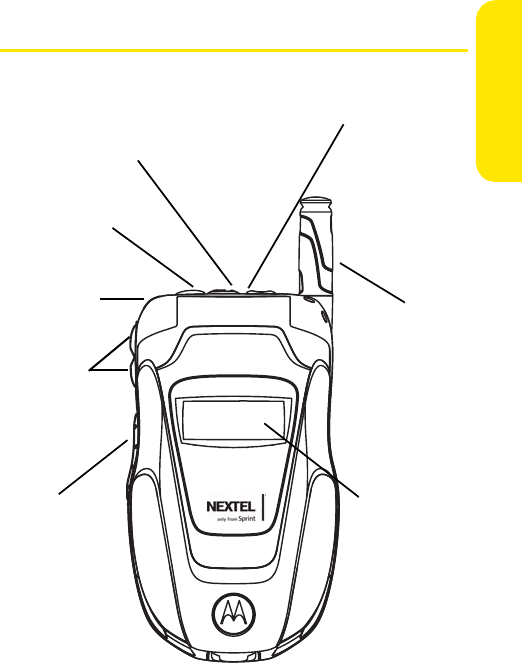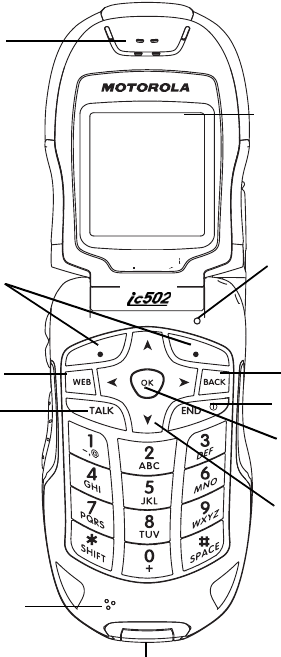Motorola Solutions 89FT7019 iDEN ic502 WITH CDMA 2000 User Manual Racer
Motorola Solutions, Inc. iDEN ic502 WITH CDMA 2000 Racer
Contents
- 1. USERS MANUAL
- 2. USERS MANUAL 1
- 3. USERS MANUAL 2
- 4. users manual
USERS MANUAL

Phone Guide
ic502 by Motorola®
www.sprint.com
© 2006 Sprint Nextel. All rights reserved. Sprint, the “Going Forward”
logo, the NEXTEL name and logo, “NEXTEL only from Sprint” and other
trademarks are trademarks of Sprint Nextel.
Printed in the U.S.A.

Motorola, Inc.
Consumer Advocacy Office
1307 East Algonquin Road
Schaumburg, IL 60196
www.hellomoto.com
1-800-331-6456 (United States)
1-888-390-6456 (TTY/TDD United States for hearing impaired)
1-800-461-4575 (Canada)
Certain mobile phone features are dependent on the capabilities and
settings of your service provider’s network. Additionally, certain features
may not be activated by your service provider, and/or the provider's
network settings may limit the feature’s functionality. Always contact your
service provider about feature availability and functionality. All features,
functionality, and other product specifications, as well as the information
contained in this user's guide are based upon the latest available
information and are believed to be accurate at the time of printing.
Motorola reserves the right to change or modify any information or
specifications without notice or obligation.
© Motorola, Inc., 2006. MOTOROLA and the Stylized M Logo are registered
in the US Patent & Trademark Office. All other product or service names are
the property of their respective owners.
This product is covered by U.S. Pat. 5,818,437, U.S. Pat. 5,953,541, U.S. Pat.
6,011,554 and other patents pending.
Java and all other Java-based marks are trademarks or registered
trademarks of Sun Microsystems, Inc. in the U.S. and other countries.
All other product names or services mentioned in this manual are the
property of their respective trademark owners.
Software Copyright Notice
The Motorola products described in this manual may include copyrighted
Motorola and third-party software stored in semiconductor memories or
other media. Laws in the United States and other countries preserve for
Motorola and third-party software providers certain exclusive rights for
copyrighted software, such as the exclusive rights to distribute or
reproduce the copyrighted software. Accordingly, any copyrighted software
contained in the Motorola products may not be modified, reverse-
engineered, distributed, or reproduced in any manner to the extent
allowed by law. Furthermore, the purchase of the Motorola products shall
not be deemed to grant either directly or by implication, estoppel, or
otherwise, any license under the copyrights, patents, or patent
applications of Motorola or any third-party software provider, except for
the normal, non-exclusive, royalty-free license to use that arises by
operation of law in the sale of a product.
Manual number: NNTN6811A

Table of Contents
Welcome to Sprint . . . . . . . . . . . . . . . . . . . . . . . . . . . . . . . . .i
Introduction . . . . . . . . . . . . . . . . . . . . . . . . . . . . . . . . . . . . . . ii
Your Phone’s Menu . . . . . . . . . . . . . . . . . . . . . . . . . . . . . . . .iii
Section 1: Getting Started . . . . . . . . . . . . . . . . . . . . . . . . . . 1
1A. Setting Up Service . . . . . . . . . . . . . . . . . . . . . . . . . . . . . . . 2
Getting Started . . . . . . . . . . . . . . . . . . . . . . . . . . . . . . . . . . . . . . . . . . . . . .3
Setting Up Your Voicemail . . . . . . . . . . . . . . . . . . . . . . . . . . . . . . . . . . . .5
Account Passwords . . . . . . . . . . . . . . . . . . . . . . . . . . . . . . . . . . . . . . . . . .6
Getting Help . . . . . . . . . . . . . . . . . . . . . . . . . . . . . . . . . . . . . . . . . . . . . . . . .7
1B. Your Phone: The Basics . . . . . . . . . . . . . . . . . . . . . . . . . . . 9
Your ic502 By Motorola . . . . . . . . . . . . . . . . . . . . . . . . . . . . . . . . . . . . 10
Getting Started With Your Phone . . . . . . . . . . . . . . . . . . . . . . . . . . . 16
Finding Your Phone Number and
Walkie-Talkie Number . . . . . . . . . . . . . . . . . . . . . . . . . . . . . . . . . . . . . 26
Basic Phone Features . . . . . . . . . . . . . . . . . . . . . . . . . . . . . . . . . . . . . . . 27
Accessories . . . . . . . . . . . . . . . . . . . . . . . . . . . . . . . . . . . . . . . . . . . . . . . . 32
Entering Text . . . . . . . . . . . . . . . . . . . . . . . . . . . . . . . . . . . . . . . . . . . . . . 33
Section 2: Using Your Phone . . . . . . . . . . . . . . . . . . . . . . .37
2A. Making and Answering Calls . . . . . . . . . . . . . . . . . . . . . 38
Types of Calls . . . . . . . . . . . . . . . . . . . . . . . . . . . . . . . . . . . . . . . . . . . . . . 39
Making and Answering Phone Calls . . . . . . . . . . . . . . . . . . . . . . . . . 40
Making and Answering Walkie-Talkie Calls . . . . . . . . . . . . . . . . . 49
Making and Answering Talkgroup Calls . . . . . . . . . . . . . . . . . . . . . 57
Making and Answering Direct Talk Calls . . . . . . . . . . . . . . . . . . . . 60
Using Call Alerts . . . . . . . . . . . . . . . . . . . . . . . . . . . . . . . . . . . . . . . . . . . 68
Missed Calls . . . . . . . . . . . . . . . . . . . . . . . . . . . . . . . . . . . . . . . . . . . . . . . 70
2B. Controlling Your Phone’s Settings . . . . . . . . . . . . . . . . 73
Sound Settings . . . . . . . . . . . . . . . . . . . . . . . . . . . . . . . . . . . . . . . . . . . . . 74
Display Settings . . . . . . . . . . . . . . . . . . . . . . . . . . . . . . . . . . . . . . . . . . . . 77
Location Settings . . . . . . . . . . . . . . . . . . . . . . . . . . . . . . . . . . . . . . . . . . 81
Messaging Settings . . . . . . . . . . . . . . . . . . . . . . . . . . . . . . . . . . . . . . . . 82
Airplane Mode . . . . . . . . . . . . . . . . . . . . . . . . . . . . . . . . . . . . . . . . . . . . . 84
TTY Use With Sprint Service . . . . . . . . . . . . . . . . . . . . . . . . . . . . . . . . 85
Phone Setup Options . . . . . . . . . . . . . . . . . . . . . . . . . . . . . . . . . . . . . . . 87
Walkie-Talkie Settings . . . . . . . . . . . . . . . . . . . . . . . . . . . . . . . . . . . . . 89
2C. Setting Your Phone’s Security . . . . . . . . . . . . . . . . . . . . 91
Accessing Your Security Menu . . . . . . . . . . . . . . . . . . . . . . . . . . . . . . 92
SIM Card Security . . . . . . . . . . . . . . . . . . . . . . . . . . . . . . . . . . . . . . . . . . 93
Using Your Phone’s Lock Feature . . . . . . . . . . . . . . . . . . . . . . . . . . . 96
Limiting Use of Your Phone . . . . . . . . . . . . . . . . . . . . . . . . . . . . . . . . . 98
Erasing Data . . . . . . . . . . . . . . . . . . . . . . . . . . . . . . . . . . . . . . . . . . . . . . 101
Resetting Your Phone . . . . . . . . . . . . . . . . . . . . . . . . . . . . . . . . . . . . . 101
Security Features for Sprint Data Services . . . . . . . . . . . . . . . . . . 102
2D. Controlling Your Roaming Experience . . . . . . . . . . . . 103
Understanding Roaming . . . . . . . . . . . . . . . . . . . . . . . . . . . . . . . . . . 104
Setting Your Phone’s Roam Mode . . . . . . . . . . . . . . . . . . . . . . . . . 106
Using Call Guard . . . . . . . . . . . . . . . . . . . . . . . . . . . . . . . . . . . . . . . . . . 107
Using Data Roam Guard . . . . . . . . . . . . . . . . . . . . . . . . . . . . . . . . . . . 108
2E. Managing Call History . . . . . . . . . . . . . . . . . . . . . . . . . . 109
Viewing Call History . . . . . . . . . . . . . . . . . . . . . . . . . . . . . . . . . . . . . . 110
Phone Call History Options . . . . . . . . . . . . . . . . . . . . . . . . . . . . . . . . 113
Walkie-Talkie Call History Options . . . . . . . . . . . . . . . . . . . . . . . . . 116
Erasing Call History . . . . . . . . . . . . . . . . . . . . . . . . . . . . . . . . . . . . . . . 118
2F. Using Contacts . . . . . . . . . . . . . . . . . . . . . . . . . . . . . . . . 119
About Contacts . . . . . . . . . . . . . . . . . . . . . . . . . . . . . . . . . . . . . . . . . . . 120
Finding Contacts Entries . . . . . . . . . . . . . . . . . . . . . . . . . . . . . . . . . . 122
Creating a Contacts Entry . . . . . . . . . . . . . . . . . . . . . . . . . . . . . . . . . 124
Contacts Entries for Walkie-Talkie Groups and Talkgroups . . 127
Managing Your Contacts . . . . . . . . . . . . . . . . . . . . . . . . . . . . . . . . . . 130
Using Your SIM Manager . . . . . . . . . . . . . . . . . . . . . . . . . . . . . . . . . . 131
Dialing Sprint Services . . . . . . . . . . . . . . . . . . . . . . . . . . . . . . . . . . . . 135
2G. Using the Phone’s Calendar and Tools . . . . . . . . . . . . 136
Using Your Phone’s Calendar . . . . . . . . . . . . . . . . . . . . . . . . . . . . . . 137
Using Your Phone’s Tools . . . . . . . . . . . . . . . . . . . . . . . . . . . . . . . . . . 141
2H. Managing Voice Records . . . . . . . . . . . . . . . . . . . . . . . 143
Voice Records . . . . . . . . . . . . . . . . . . . . . . . . . . . . . . . . . . . . . . . . . . . . . 144
Section 3: Service Features . . . . . . . . . . . . . . . . . . . . . . .147
3A. Service Features: The Basics . . . . . . . . . . . . . . . . . . . . . 148
Using Voicemail . . . . . . . . . . . . . . . . . . . . . . . . . . . . . . . . . . . . . . . . . . 149
Using SMS Text Messaging . . . . . . . . . . . . . . . . . . . . . . . . . . . . . . . . 156
Using Caller ID . . . . . . . . . . . . . . . . . . . . . . . . . . . . . . . . . . . . . . . . . . . . 159
Responding to Call Waiting . . . . . . . . . . . . . . . . . . . . . . . . . . . . . . . . 159
Making a Three-Way Call . . . . . . . . . . . . . . . . . . . . . . . . . . . . . . . . . . 160
Using Call Forwarding . . . . . . . . . . . . . . . . . . . . . . . . . . . . . . . . . . . . . 161
3B. Sprint Data Services . . . . . . . . . . . . . . . . . . . . . . . . . . . . 162
Sprint Data Services Applications . . . . . . . . . . . . . . . . . . . . . . . . . . 163
Getting Started . . . . . . . . . . . . . . . . . . . . . . . . . . . . . . . . . . . . . . . . . . . 164
Downloading Premium Services Content . . . . . . . . . . . . . . . . . . 169
Exploring the Web . . . . . . . . . . . . . . . . . . . . . . . . . . . . . . . . . . . . . . . . 173
Sprint Data Services FAQs . . . . . . . . . . . . . . . . . . . . . . . . . . . . . . . . . 178
Section 4: Safety and Warranty Information . . . . . . .180
4A. Important Safety Information . . . . . . . . . . . . . . . . . . . 181
General Precautions . . . . . . . . . . . . . . . . . . . . . . . . . . . . . . . . . . . . . . . 182
Safety and General Information . . . . . . . . . . . . . . . . . . . . . . . . . . . 183
Hearing Aid Compatibility with Mobile Phones . . . . . . . . . . . . 188
Battery Tips . . . . . . . . . . . . . . . . . . . . . . . . . . . . . . . . . . . . . . . . . . . . . . . 188
Specific Absorption Rate Data . . . . . . . . . . . . . . . . . . . . . . . . . . . . . 189
Information from the World Health Organization . . . . . . . . . . 191
Product Registration . . . . . . . . . . . . . . . . . . . . . . . . . . . . . . . . . . . . . . 191
Owner’s Record . . . . . . . . . . . . . . . . . . . . . . . . . . . . . . . . . . . . . . . . . . . 192
Phone Guide Proprietary Notice . . . . . . . . . . . . . . . . . . . . . . . . . . . 192
Export Law Assurances . . . . . . . . . . . . . . . . . . . . . . . . . . . . . . . . . . . . 192
Wireless: The New Recyclable . . . . . . . . . . . . . . . . . . . . . . . . . . . . . 192
Smart Practices While Driving . . . . . . . . . . . . . . . . . . . . . . . . . . . . . 194
4B. Manufacturer’s Warranty . . . . . . . . . . . . . . . . . . . . . . . 196
Motorola Limited Warranty
for the United States and Canada . . . . . . . . . . . . . . . . . . . . . . . . . . 197
Service and Repairs . . . . . . . . . . . . . . . . . . . . . . . . . . . . . . . . . . . . . . . 202
Index . . . . . . . . . . . . . . . . . . . . . . . . . . . . . . . . . . . . . . . . . . .203

i
Welcome to Sprint
Sprint and Nextel have come together offering you more choice
and flexibility to do whatever you want, whenever you want.
You can make both wireless phone calls and Walkie-Talkie
calls from the same phone, simplifying your calling
experience while expanding the number of persons you can
connect to. This combination gives you more of what you
need to do more of what you want.
Welcome to a future full of possibility. Welcome to the new
Sprint.
Welcome and thank you for choosing Sprint.

ii
Introduction
This Phone Guide introduces you to Sprint service and the
features of your new phone. It’s divided into four sections:
ࡗSection 1: Getting Started
ࡗSection 2: Using Your Phone
ࡗSection 3: Service Features
ࡗSection 4: Safety and Warranty Information
Throughout this guide, you'll find tips that highlight special
shortcuts and timely reminders to help you make the most of
your new phone and service. The Table of Contents and Index
also help you quickly locate specific information.
You'll get the most out of your phone if you read each section.
However, if you'd like to get right to a specific feature, simply
locate that section in the Table of Contents and go directly to
that page. Follow the instructions in that section, and you'll
be ready to use your phone in no time.
Phone
Guide
Note:
Due to updates in phone software, this printed guide
may not be the most current version for your phone.
Visit www.sprint.com and sign on to access the most
recent version of the phone guide.
WARNING Please refer to the Important Safety Information section
on page 181 to learn about information that helps you
safely use your phone. Failure to read and follow the
Important Safety Information in this phone guide may
result in serious bodily injury, death, or property
damage.

iii
Your Phone’s Menu
The following list outlines your phone’s menu structure. For
more information about navigating through the menus,
please see “Navigating Through Phone Menus” on page 30.
CALL HISTORY
1: ALL CALLS
2: MISSED CALLS
3: INCOMING CALLS
4: OUTGOING CALLS
5: WALKIE-TALKIE
6: ERASE CALL HISTORY
CONTACTS
1: FIND ALL NAMES
2: ADD NEW ENTRY
3: FILTER NAMES
4: SPEED DIAL #S
5: MY INFO
6: SERVICES
1: Customer Solutions 2: Dir. Assistance 3: Account Info.
4: Sprint Operator
7: SIM MANAGER
1: Copy to Contacts 2: Copy to SIM 3: Manage SIM
4: Help
8: MANAGE CONTACTS
1: Add Categories 2: View Categories 3: Delete All Contacts
4: Memory Status

iv
MESSAGING
1: SEND MESSAGE
2: TEXT MESSAGING
1: Inbox 2: Outbox 3: Sent Folder
4: Drafts Folder 5: Preset Messages 6: Send Message
3: VOICEMAIL
4: SETTINGS
1: Notification 2: Callback Number
MY CONTENT
1: GAMES
1: Get New 2: My Content Manager
2: RINGERS
1: Get New 2: My Content Manager
3: SCREEN SAVERS
1: Get New 2: My Content Manager
4: APPLICATIONS
1: Get New 2: My Content Manager
WALKIE-TALKIE
1: WALKIE-TALKIE CONTACTS
2: DIRECT TALK
WEB
VOICE RECORDS

v
TOOLS
1: ALARM CLOCK
1: Alarm 1 2: Alarm 2 3: Alarm 3
4: Alarm 4 5: Alarm 5
2: CALCULATOR
3: CALENDAR
4: SIM MANAGER
1: Copy to Contacts 2: Copy to SIM
3: Manage SIM 4: Help
5: PHONE UPDATE
SETTINGS
1: SOUNDS
1: Ringer Type
1: Call with ID 2: Call without ID 3: Text Message
4: Voicemail 5: Call Alert 6: Calendar
7: Alarm 8: Roam Ringer
2: Volume
1: Ringer 2: Messaging 3: Calendar
4: Alarm 5: Applications 6: Power On/Off
7: Key Beep 8: Voice Call 9: Speaker Phone
10: Call Alert 11: Incoming WLK-TLK 12: Reset Volumes
3: Indicators
1: Service 2: Minute Beep 3: Call Lost
4: Connect
2: DISPLAY
1: Screensaver 2: Standby Display 3: Light Control
4: Greeting Banner 5: Menu Style 6: Assign Keys
7: Set Time/Date 8: Incoming Calls
3: PCS VISION
1: PCS Vision
2: Net Guard
3: Update Vision Profile

vi
4: WALKIE-TALKIE
1: One Touch WLK-TLK
2: Talkgroup Silent
3: Talkgroup Area
5: ROAMING
1: Set Mode
2: Call Guard
3: Data Roam Guard
6: LOCATION
7: SECURITY
1: Lock Phone
2: Change Lock Code
3: SIM PIN (On / Off)
4: Change SIM PIN
5: Limit Use
1: Lock Contacts 2: Lock Vision
3: Restrict Outgoing Calls 4: Restrict Incoming Calls
5: Restrict Walkie-Talkie
6: Erase Contacts
7: Erase My Content
8: Reset Phone
9: Special Numbers
8: OTHERS
1: Language
2: Answer Options
1: Any Key 2: Auto 3: Open
4: [Talk] Key
3: Speed Dial
4: Abbreviated Dial
5: Auto Redial

vii
6: Airplane Mode
7: TTY
8: Text Input
1: Personal Dictionary 2: Word Pop-up List 3: Word Completion

1
Section 1
Getting Started

Section 1A: Setting Up Service 2
Setting Up Service
Section 1A
Setting Up Service
In This Section
ࡗGetting Started
ࡗSetting Up Your Voicemail
ࡗSprint PCS Account Passwords
ࡗGetting Help
Setting up service on your new phone is quick and easy. This
section walks you through the necessary steps to unlock your
phone, set up your voicemail, establish passwords, and
contact Sprint for assistance with your phone service.
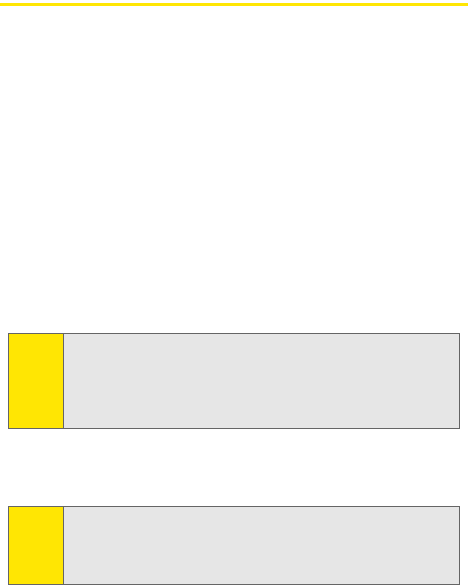
3 Section 1A: Setting Up Service
Getting Started
Determining If Your Phone Is Already Activated
If you purchased your phone at a Sprint Store, it is probably
activated, unlocked, and ready to use. If you received your
phone in the mail, it probably has been activated; all you
need to do is unlock it.
If your phone is not activated, please call Sprint Customer
Service at 1-888-211-4PCS (4727).
Unlocking Your Phone
To unlock your phone, follow these easy steps:
1. Press and hold e to turn the phone on.
2. Press Unlock (right softkey).
3. Enter your four-digit lock code. (For security purposes,
the code is not visible as you type.)
When you power up your phone for the first time, it performs
a series of security checks. For example, it verifies the phone
is Sprint-approved, and the correct SIM Card is installed. If you
don’t pass the security checks, follow the instructions on the
Note: To select a softkey, press the softkey button directly below the
softkey text that appears at the bottom left and bottom right
of your phone’s display screen. Softkey actions change
according to the screen you’re viewing and do not appear if
there is no corresponding action available.
Tip: If you can’t recall your lock code, try using the last four digits
of either your Social Security number or phone number or try
0000 or NATL (6285). If none of these work, call Sprint
Customer Service at 1-888-211-4PCS (4727).

Section 1A: Setting Up Service 4
Setting Up Service
display screen to clear them. If you still encounter security
messages, call Sprint Customer Service.
By default, your phone only requests a lock code before you
can start dialing. However, you can change your security
settings to limit or facilitate use of your phone. See “Setting
Your Phone’s Security” on page 91 for more options.
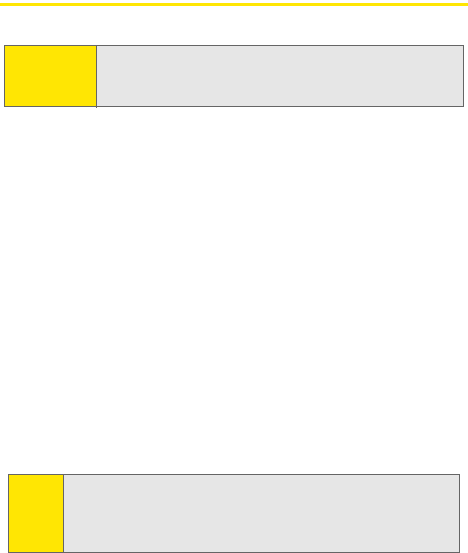
5 Section 1A: Setting Up Service
Setting Up Your Voicemail
Unanswered phone calls are automatically transferred to
your voicemail, even if your phone is in use or turned off.
Therefore, you may want to set up your voicemail and
personal greeting as soon as your phone is activated.
To set up your voicemail:
1. From standby mode, press and hold 1.
2. Follow the system prompts to:
ⅢCreate your passcode.
ⅢRecord your name announcement.
ⅢRecord your greeting.
ⅢChoose whether or not to activate One-Touch.
Message Access (a feature that lets you access
messages simply by pressing and holding 1,
bypassing the need for you to enter your passcode).
For more information about using your voicemail, see “Using
Voicemail” on page 149.
Important: Walkie-Talkie, Group Walkie-Talkie, Talkgroup and Direct
Talk calls are not forwarded to voicemail. Only incoming
standard wireless phone calls are forwarded.
Note: Voicemail Passcode
If you are concerned about unauthorized access to your
voicemail account, Sprint recommends that you enable your
voicemail passcode.

Section 1A: Setting Up Service 6
Setting Up Service
Account Passwords
As a Sprint customer, you enjoy unlimited access to your
personal account information, your voicemail account, and
your data services account. To ensure that no one else has
access to your information, you need to create passwords to
protect your privacy.
Account Password
If you are the account owner, you'll have an account password
to sign on to www.sprint.com and to use when calling Sprint
Customer Service. Your default account password is the last
four digits of your Social Security number. If you are not the
account owner (if someone else receives the invoice for your
Sprint service), you can get a sub-account password at
www.sprint.com.
Voicemail Password
You'll create your voicemail password (or passcode) when you
set up your voicemail. See “Setting Up Your Voicemail” on
page 149 for more information on your voicemail password.
Data Services Password
With your ic502 by Motorola®, you may elect to set up a data
services password. This optional password may be used to
authorize purchase of Premium Services content and to
protect personal information on multi-phone accounts.
For more information, or to change your passwords, sign on
to www.sprint.com or call Sprint Customer Service at
1-888-211-4PCS (4727).

7 Section 1A: Setting Up Service
Getting Help
Visit www.sprint.com
You can go online to:
ⅷAccess your account information.
ⅷCheck your minutes used (depending on your
service plan).
ⅷView and pay your bill.
ⅷMake your life easier by enrolling for online billing and
automatic payment.
ⅷPurchase accessories.
ⅷShop for the latest phones.
ⅷView available other service plans and options.
ⅷLearn more about data services and other great products
like games, ringers, screen savers, and more.
Reaching Sprint Customer Service
You can reach Sprint Customer Service many different ways:
ⅷDial * 2 s on your phone.
ⅷSign on to your account at www.sprint.com.
ⅷCall us toll-free at 1-888-211-4727 (Consumer customers)
or 1-888-788-4727 (Business customers).
ⅷWrite to us at Sprint Customer Service, P.O. Box 8077,
London, KY 40742.
Receiving Automated Invoicing Information
For your convenience, your phone gives you access to
invoicing information on your account. This information
includes balance due, payment received, invoicing cycle, and
an estimate of the number of minutes used since your last
invoicing cycle.

Section 1A: Setting Up Service 8
Setting Up Service
To access automated invoicing information:
ᮣPress * 4 s.
Sprint 411
You have access to a variety of services and information
through Sprint 411, including residential, business, and
government listings; movie listings or show times; driving
directions, restaurant reservations, and major local event
information. You can get up to three pieces of information
per call, and the operator can automatically connect your call
at no additional charge.
There is a per-call charge to use Sprint 411 and you are billed
for airtime.
To call Sprint 411:
ᮣPress 4 1 1 s.
Sprint Operator Services
Sprint Operator Services provides assistance when placing
collect calls or when placing calls billed to a local telephone
calling card or third party.
To access Sprint Operator Services:
ᮣPress 0 s.
For more information or to see the latest in products and
services, visit us online at www.sprint.com.
Note: This service may not be available in all Affiliate areas.

9 Section 1B: Your Phone: The Basics
Section 1B
Your Phone: The Basics
In This Section
ࡗYour ic502 By Motorola
ࡗGetting Started With Your Phone
ࡗFinding Your Phone Number and Walkie-Talkie Number
ࡗBasic Phone Features
ࡗAccessories
ࡗEntering Text
Your phone is packed with features that simplify your life and
expand your ability to stay connected to the people and
information that are important to you. This section gives you an
overview of your phone, describes its basic features, shows
you how to power it on and off, change your battery, and
insert your SIM card.

Section 1B: Your Phone: The Basics 12
Phone Basics
Key Functions
1. Audio Connector allows you to plug in an optional
headset for convenient, hands-free conversations. Your
Walkie-Talkie headset can only use this connector.
CAUTION! Inserting an accessory into the incorrect jack
may damage the phone.
2. Speaker Key turns the speakerphone on and off during
phone calls and Walkie-Talkie calls.
3. Indicator Light does the following –
ⅢFlashes green to indicate you have Sprint wireless
and Nextel Walkie-Talkie service or your battery is
charging.
ⅢFlashes orange to indicate you are roaming.
ⅢFlashes red to indicate you do not have service or
your battery is low.
ⅢFlashes red and green to indicate you have an
incoming call.
ⅢFlashes orange and green to indicate you have
received a message or Call Alert, or that an alarm
has expired.
4. Volume Controls allow you to adjust the ringer volume in
standby mode (with the phone open) or adjust the voice
volume during a call. To mute the ringer during an
incoming call, press the volume key up or down.
5. Walkie-Talkie button allows you to use your phone as a
long-range, digital Walkie-Talkie.
Note: The use of wireless phones while driving may cause
distraction. Discontinue a call if you can’t concentrate on
driving. Additionally, the use of wireless devices and their
accessories may be prohibited or restricted in certain areas.
Always obey the laws and regulations on the use of these
products.
13 Section 1B: Your Phone: The Basics
6. External Display shows information about incoming
calls, battery strength, signal coverage, today’s date and
time, and more.
7. Retractable Antenna can be extended to optimize your
phone’s performance during phone calls, Walkie-Talkie
calls, and data sessions.
8. Smart Key ends a phone call or Walkie-Talkie call,
forwards an incoming call to voicemail and dismisses a
Call Alert.
9. Earpiece lets you hear the caller and automated phone
prompts.
10. Softkeys let you select softkey actions or menu items
corresponding to the bottom left and right lines on the
display screen.
11. WEB Key allows you to access the Internet.
12. TALK Key allows you to place or receive phone calls,
answer Call Waiting, and use Three-Way Calling.
13. Microphone allows the other caller to hear you clearly
when you are speaking to them.
14. Connector allows you to attach the battery charger or
other accessories to your phone. You cannot use this
connector for Walkie-Talkie audio accessories.
15. Navigation Keys scroll through the phone’s menu options
and act as shortcut keys from standby mode. To assign
shortcuts to the navigation keys, see“Shortcuts” on
page 87.
16. OK Key selects the highlighted choice when navigating
through a menu. From standby mode, pressing O takes
you to the main menu.
17. END Key ends a call. Press and hold this key for two
seconds to turn your phone on or off. While in the main
menu, it returns the phone to standby mode and

Section 1B: Your Phone: The Basics 14
Phone Basics
cancels your input. When you receive an incoming call,
press it to enter silent mode and mute the ringer.
18. BACK Key deletes characters from the display screen in
text entry mode. When in a menu, press c to return to
the previous menu. This key also allows you to return to
the previous screen during a data session.
19. Photosensor detects ambient light. If Photosensor is set
to On, your phone measures the available light and
determines if the keypad backlight needs to be turned
on. If Photosensor is set to Off, the backlight turns on
whenever you open the phone. See “Controlling Your
Phone’s Settings” on page 73 for more information.
20. Display Screen demonstrates all the information needed
to operate your phone, such as call status, Contacts,
date and time, signal coverage, battery strength, and
much more.
Antenna
To optimize your phone’s performance, extend the antenna
during phone calls, Walkie-Talkie calls, and data sessions.
To extend the antenna, pull gently on the rounded tip until
the antenna is fully extended and clicks into position. When
finished with a call, retract the antenna by pushing gently on
the rounded tip until the antenna clicks into place.
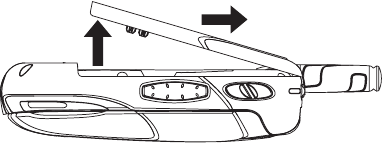
15 Section 1B: Your Phone: The Basics
Removing the Battery Door
The battery door must be removed to access the phone’s SIM
card and to insert, remove, and replace the battery.
To remove your battery door:
1. Make sure the phone is powered off.
2. Slide the release button back until the battery door
unlatches.
3. Allow the battery door to pop up, and remove it from
the back of your phone.
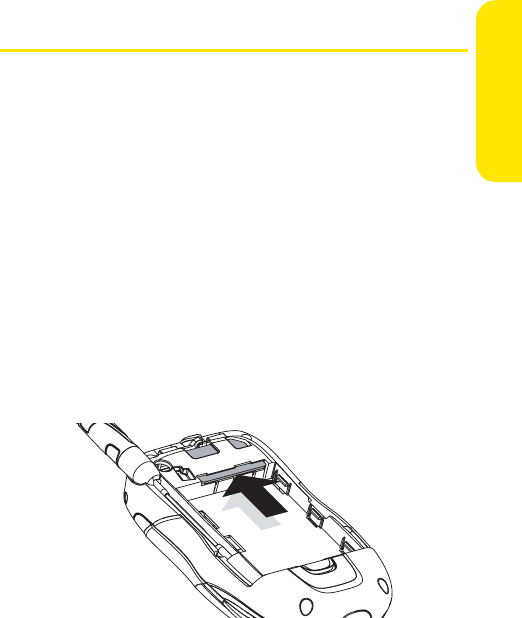
Section 1B: Your Phone: The Basics 16
Phone Basics
Getting Started With Your Phone
To start using your ic502 by Motorola phone:
ⅷMake sure your SIM card is in place.
ⅷCharge the battery.
ⅷTurn on your phone.
ⅷActivate your service.
ⅷEnable security.
ⅷComplete phone programming.
After you’ve completed these items, you are ready to begin
using your new phone.
Locating Your SIM Card
Your SIM (Subscriber Identity Module) card is a small piece of
plastic located inside, next to your battery. Your SIM card is
tucked in underneath an edge.
If there is no SIM card in your phone, contact Sprint Customer
Service at 1-888-211-4PCS (4727).
If you want to use a SIM card other than the one in your
phone, please contact Sprint Customer Service to verify it is
compatible with your phone.
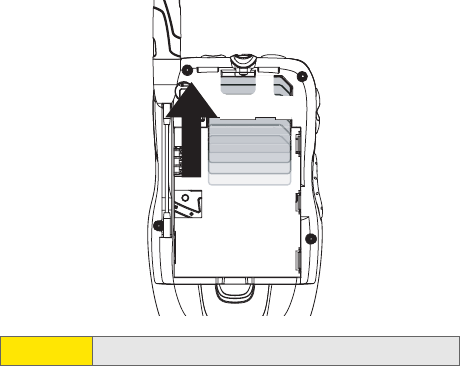
17 Section 1B: Your Phone: The Basics
Inserting Your SIM Card
To insert your SIM card:
1. With your phone powered off, remove the battery door
and battery.
2. With your fingers, carefully slide the SIM card in under
the edge and press it gently in place.
Important: Do not touch the gold colored areas of your SIM card.
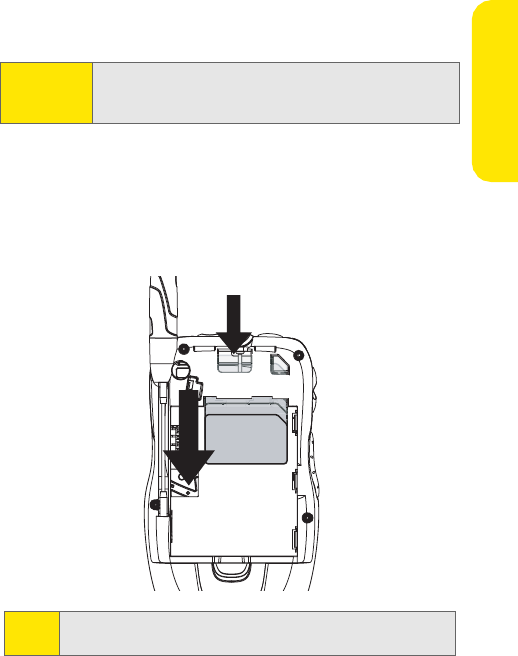
Section 1B: Your Phone: The Basics 18
Phone Basics
Removing Your SIM Card
To remove your SIM card:
1. With your phone powered off, remove the battery door
and battery.
2. With your fingernail, carefully slide the SIM card out
from under the edge.
See “Managing Your Contacts” on page 130 for more
information.
Important: To avoid losing information stored in your SIM card, do
not remove it from your phone unless absolutely
necessary.
Note: Protect your SIM card as you would any delicate object. Store
it carefully.

19 Section 1B: Your Phone: The Basics
Using Your Phone’s Battery and Charger
Sprint-approved and Motorola-approved batteries and
accessories can be found at Sprint Stores, through Motorola,
or by calling 1-866-343-1114 to order. They’re also available
at www.sprint.com – click the Wireless link under Personal, and
then click Accessories under Shop the Sprint PCS Store Online.
Battery Capacity
Your phone is equipped with a Lithium Ion (Li-Ion) battery. It
allows you to recharge your battery before it is fully drained.
The battery provides up to 170 minutes of continuous talk
time.
When the battery reaches 5% of its capacity, the battery icon
blinks. When there are approximately two minutes of talk
time left, the phone sounds an audible alert and then powers
down.
WARNING Use only Sprint-approved or Motorola-approved batteries
and chargers with your phone. The failure to use a Sprint-
approved or Motorola-approved battery and charger may
increase the risk that your phone overheats, catches fire,
or explodes, resulting in serious bodily injury, death, or
property damage.
Note: Long light settings, searching for service, vibrate mode,
browser use, and other variables may affect the battery’s talk
times.
Tip: Be sure to watch your phone’s battery level indicator and
charge the battery before it runs out of power.
You can purchase a larger battery with a longer battery life,
if needed.
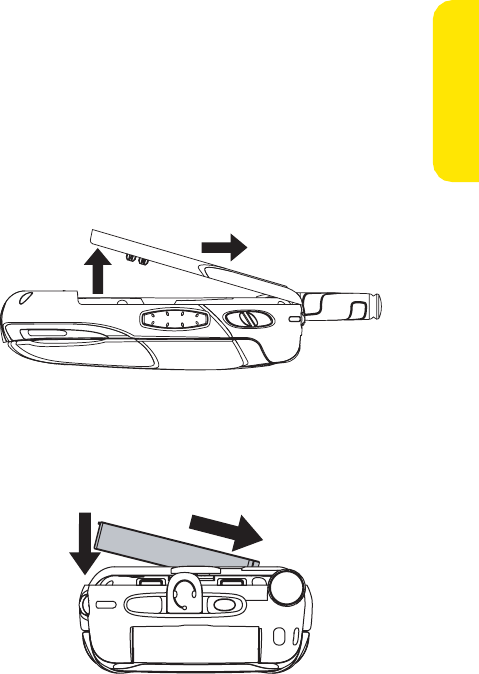
Section 1B: Your Phone: The Basics 20
Phone Basics
Installing the Battery
To install your battery:
1. Make sure the phone is powered off.
2. Slide the release button back until it releases the
battery door.
3. Allow the battery door to pop up, and remove it from
the back of your phone.
4. Insert the top of the battery into the battery area. Be
sure the metal areas on the battery and on the phone
are touching.
5. Press the battery down to secure it.
6. Replace the battery door and press it gently until you
hear a click.

21 Section 1B: Your Phone: The Basics
Removing the Battery
To remove your battery:
1. Make sure the power is off so that you don’t lose any
stored numbers or messages.
2. Open the battery door by sliding the release button
back until it releases the battery door. Then, allow the
battery door to pop up, and remove it from the back of
your phone.
3. Remove the battery by lifting it out from the side.
Charging the Battery
Your phone’s Li-Ion battery is rechargeable and should be
charged as soon as possible so you can begin using your
phone.
Keeping track of your battery’s charge is important. If your
battery level becomes too low, your phone automatically
turns off, and you lose all the information you were just
working on.
For a quick check of your phone’s battery level, glance at the
battery charge indicator located on your displays (both
internal and external). If the battery charge is getting too low,
the battery icon blinks and the phone sounds a warning
tone.
Always use a Sprint-approved or Motorola-approved charger,
or vehicle power adapter to charge your battery.
WARNING Do not handle a damaged or leaking Li-Ion battery as you
can be burned.
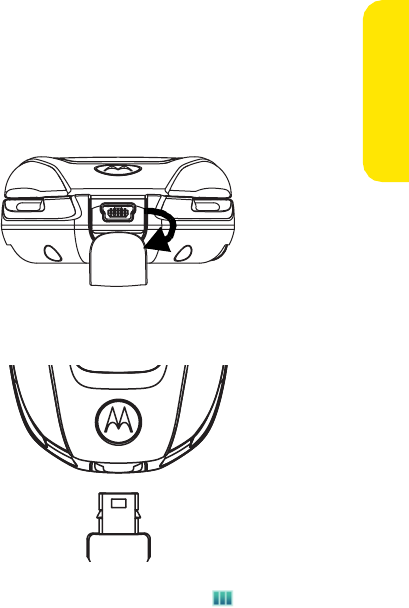
Section 1B: Your Phone: The Basics 22
Phone Basics
Using the Charger
To use the charger provided with your phone:
1. Plug the charger into an electrical outlet.
2. Pull and rotate the connector cover.
3. Plug the other end of the charger into the accessory
connector.
Your external and internal displays also let you know the
battery is charging. Both the battery icon and a text
message show the charging status.
Battery Use and Maintenance
ⅷSprint-approved Li-Ion chargers provide optimum
performance. Other chargers may not fully charge the
Li-Ion battery or may yield a reduced number of lifetime
charge cycles.
23 Section 1B: Your Phone: The Basics
ⅷExtreme temperatures degrade battery performance. Do
not store the battery where temperatures exceed 140°F
(60°C) or fall below -4°F (-20°C).
ⅷLi-Ion batteries have a self discharge rate and, without
use, lose about 1% of their charge per day.
Turning Your Phone On and Off
To turn your phone on:
1. Open the phone.
2. Press and hold e for approximately two seconds.
As your phone connects to the network, you see a connecting
message. Your phone may require you to enter identifying
information to use it or to access specific features. See
“Setting Your Phone’s Security” on page 91 for more
information.
To power your phone off:
1. Open the phone.
2. Press and hold e.
Activating Service
To activate your service:
ᮣThe first time you power your phone on, your service is
activated.
Your phone then prompts you to select OK to update your
browser information, which enables security. This screen only
appears during initial activation.
Enabling Security
You must enable security the first time you power on your
phone or within 10 days of first activation of your phone.

Section 1B: Your Phone: The Basics 24
Phone Basics
To enable your security:
1. After you are prompted to enable security, press OK
(right softkey).
2. Press Yes (right softkey). A series of screens are
displayed.
3. Press e to return to standby mode.
Phone Programming
Within 24 hours of enabling security, you will receive an alert
notification containing your phone number, your Walkie-
Talkie number, your Talkgroups (if applicable), and the
Sprint Customer Service number.
To complete your phone programming:
1. When you receive an alert notification saying New
Browser Message - Receive Programming Info, select Goto
(right softkey). You are prompted to accept changes to
your lists.
2. Press OK (right softkey). You are prompted again to
accept changes to your lists.
3. Press OK (right softkey). A confirmation is displayed.
4. Press OK (right softkey).
5. Press e to return to standby mode.
Standby and Power Save Modes
Once your phone is on, it may display “Searching for Service,”
which indicates that your phone is searching for a signal.
When your phone finds a signal, it automatically enters
standby mode – the phone’s idle state. At this point, you are
ready to begin making and receiving calls.
If your phone is unable to find a signal after 15 minutes of
searching, a Power Save feature is automatically activated.

25 Section 1B: Your Phone: The Basics
When a signal is found, your phone automatically returns to
standby mode.
In Power Save mode, your phone searches for a signal
periodically without your intervention. You can also initiate a
search for Sprint service by pressing any key (when your
phone is powered on).
Note: The Power Save feature helps to conserve your battery power
when you are in an area where there is no signal.

Section 1B: Your Phone: The Basics 26
Phone Basics
Finding Your Phone Number and
Walkie-Talkie Number
My Info lets you view your phone number, Walkie-Talkie
number, and other information.
To view information about your phone:
1. Press O > Contacts > My Info.
2. Scroll to see your information:
ⅢMobile lists your phone number.
ⅢWalkie-Talkie lists your Walkie-Talkie number.
These numbers appear when you receive incoming calls.
Press Options (right softkey) and select Edit. You can now
enter your name, home and work numbers, and email, if you
want. See “Entering Text” on page 33 for more instructions
on how to do this.

27 Section 1B: Your Phone: The Basics
Basic Phone Features
Congratulations on purchasing your new ic502 by Motorola.
Your phone is lightweight, easy-to-use, and rugged. It offers
many significant features and service options.
The following list previews some of those features and
provides page numbers where you can find out more:
ⅷDual-mode capability allows you to make both Walkie-
Talkie calls and traditional wireless phone calls. Walkie-
Talkie calls include Walkie-Talkie, Group Walkie-Talkie,
Talkgroup, and Direct Talk calls (page 39).
ⅷExternal display gives you quick and easy access to
information about incoming calls, battery strength, signal
coverage, and more. When in standby mode, it
conveniently displays today’s time and date (page 28).
ⅷWalkie-Talkie button lights up whenever you receive a
Walkie-Talkie call (page 51).
ⅷ1900 MHz CDMA capability allows you to make and
receive calls while on the Nationwide Sprint Network and
to roam on other networks where we’ve implemented
roaming agreements with other carriers (page 103).
ⅷNextel Walkie-Talkie service allows you to make Walkie-
Talkie calls on other networks where we’ve implemented
roaming agreements.
ⅷThe wireless browser provides access to the wireless
Internet (page 162).
ⅷGames, ringers, screen savers, and other applications can
be downloaded to make your phone as unique as you are
(page 169). Additional charges may apply.
ⅷSMS Text Messaging (page 156) provides quick and
convenient messaging capabilities.

Section 1B: Your Phone: The Basics 28
Phone Basics
ⅷThe Contacts list allows you to store up to 900 entries
(page 119). Contacts contains Walkie-Talkie numbers,
phone numbers, and other information in an easy-to-use,
integrated format.
ⅷThe built-in Calendar offers several personal information
management features to help you manage your busy
lifestyle (page 136).
ⅷYour phone is equipped with a Location feature for use in
connection with location-based services (page 81).
ⅷWord English Text Input lets you quickly type messages
with one keypress per letter (page 34).
Viewing Status Information
Your phone displays information in two ways:
ⅷWhen the phone is closed, you can view status
information on the external display.
ⅷWhen the phone is open, you can view status information
as well as the rest of your phone’s features and options on
the display screen.
The external display contain two lines of information – a
status line showing symbols referencing your phone’s status,
and a text line providing additional information. The status
line displays battery strength, speakerphone use, signal
coverage, alerts, alarm settings, roaming activity, and more.
The external display alerts you to and gives you basic
information about incoming calls. When in standby mode,
the external display shows the current time and date.
Here are some of your phone’s status indicators.
shows your current signal strength. (The more lines
you have, the stronger your signal.)
shows you have Walkie-Talkie coverage.

29 Section 1B: Your Phone: The Basics
indicates your phone is set to ring for incoming
calls.
indicates data service is available.
indicates a data cable is connected to your phone.
indicates an alarm is set.
tells you a Walkie-Talkie call is in progress.
tells you a Talkgroup call is in progress.
tells you a Group Walkie-Talkie call is in progress.
tells you a Direct Talk call is in progress.
tells you received a Call Alert.
indicates your phone is on an active circuit switch
data call.
indicates you are in Airplane mode.
indicates no service is available.
indicates the speakerphone is on.
indicates the speakerphone is off.
indicates you are “roaming” off the Nationwide
Sprint Network.
tells you a call is in progress.
indicates your phone is using SSL (Secure Sockets
Layer) protocol for client/server communication.
means you missed a phone call.

Section 1B: Your Phone: The Basics 30
Phone Basics
indicates your data connection is active (ready to
transfer data). When data is being transferred, the
icon blinks.
indicates you have voicemail messages. (Press and
hold 1 to call your voicemail box.) A purple
envelope means you also have a text message.
indicates you have new text messages (icon flashes
for urgent messages).
indicates your phone’s location feature is on.
indicates your phone’s location feature is off.
indicates Silence All mode is set.
indicates your phone is operating in TTY (Text
Telephon e) mode.
indicates battery charge level (icon shown is full).
Navigating Through Phone Menus
The navigation key on your phone allows you to scroll
through menus quickly and easily. The scroll bar at the right
of the menu keeps track of your position in the menu at all
times.
To navigate through a menu, simply press the navigation key
up or down. For a diagram of your phone’s menu, please see
“Your Phone’s Menu” on page iii.
Selecting Menu Items
As you navigate through the menu, menu options are
highlighted. Select an item by highlighting it and pressing O.

31 Section 1B: Your Phone: The Basics
For example, if you want to see your volume settings:
1. Press O to access the main menu.
2. Select Settings by pressing 9 or by highlighting it and
pressing O.
3. Select Sounds by pressing 1 or by highlighting it and
pressing O.
4. Select Volume by pressing 2 or by highlighting it and
pressing O.
Backing Up Within a Menu
ᮣTo go to the previous menu, press c.
ᮣTo return to standby mode, press e.
Help
Your phone contains an in-device help program to help you
understand complicated or seldom used features. When you
access a feature, Help sometimes appears as a menu item or
softkey. Select Help and read the text for quick overview of
the feature. For more information, refer to this guide.
Note: For the purposes of this guide, the above steps condense into
“Press O > Settings > Sounds > Volume.”

Section 1B: Your Phone: The Basics 32
Phone Basics
Accessories
Your phone comes with a Li-Ion Battery, charger, and holster.
Various accessories are available for use with your ic502
phone, including a higher capacity battery (with a larger
battery door), cases, vehicle power chargers, data cables,
hands-free accessories, and more.
To make communicating in Walkie-Talkie easier, the Motorola
Walkie-Talkie headset allows hands-free operation. It works
exclusively on these calls, and has its own Walkie-Talkie
button.
To order additional accessories, go to www.sprint.com or call
1-866-343-1114. You can also contact your Sprint Authorized
Representative or stop by any Sprint Store. For information on
Sprint Store locations, go to www.sprint.com.

33 Section 1B: Your Phone: The Basics
Entering Text
Selecting a Character Input Mode
Your phone provides convenient ways to enter words, letters,
punctuation, and numbers whenever you are prompted to
enter text (for example, when adding a Contacts entry or
when using Sprint Mail and SMS Text Messaging).
To change the character input mode:
1. When you display a screen where you can enter text,
press the right softkey to change the character input
mode.
2. Select one of the following options:
ⅢWord English to enter text using a predictive text
entering system that reduces the keys that need to
be pressed while entering a word (see page 34).
ⅢMulti-Tap to cycle through the alpha characters
associated with the letters on the keypad (see
page 35).
ⅢNumbers to enter numbers by pressing the numbers
on the keypad (see page 36).
ⅢSymbols to enter symbols (see page 36).
ⅢWord Spanish to enter Spanish text using predictive
text like Word English (see page 34).
Tip: When entering text, press * to change letter capitalization
(Abc > ABC > abc).

Section 1B: Your Phone: The Basics 34
Phone Basics
Entering Characters Using Word English Text Input
Word English Text Input lets you enter text into your phone
by pressing keys just once per letter. (To select the
Word English mode when entering text, see “Selecting a
Character Input Mode” on page 33.)
Word English Text Input analyzes the letters you enter using
an intuitive word database and creates a suitable word. (The
word may change as you type.)
To enter a word using Word English Text Input:
1. Select the Word English character input mode. (See
“Selecting a Character Input Mode” on page 33.)
2. Press the corresponding keys once per letter to enter a
word (for example, to enter the word “Bill,” press
2 4 5 5). (If you make a mistake, press c to erase a
single character. Press and hold c to delete an entire
entry.)
If the word you want is not displayed after you have
entered all the letters, press the navigation key down to
scroll through other word options. A pop-up list appears
with the word options.
To accept a word and insert a space, press #.
—or—
To accept a word completion (such as “Billion” when you
entered “Bill”), press the navigation key right.
Tip: To keep this pop-up list from appearing, press O> Settings
> Others > Text Input > Word Pop-up List > Manual (rather than
Automatic).
Tip: To turn word completion on or off, press O > Settings > Others
>TextInput >WordCompletion >OnorOff
.

35 Section 1B: Your Phone: The Basics
Adding a Word to the Word English Database
If a word you want to enter is not displayed as an option
when you are using Word English Text Input, you can add it to
the database.
To add a word to the Word English Text Input database:
1. Select the Multi-Tap character input mode. (See
“Selecting a Character Input Mode” on page 33.)
2. Enter the word using multi-tap text entry. (See
“Entering Characters Using Multi-Tap Mode” on
page 35.) The word appears as an option the next time
you scroll through options during Word English Text
Input.
Entering Characters Using Multi-Tap Mode
To enter characters by tapping the keypad:
1. Select the Multi-Tap mode. (See “Selecting a Character
Input Mode” on page 33.)
2. Press the corresponding keys repeatedly until the
desired letter appears. (For example, to enter the word
“Bill,” press 2 twice, 4 three times, 5 three times,
and 5 three times again). If you make a mistake, press
c to erase a single character. Press and hold c to erase
an entire word.
By default, the first letter of an entry is capitalized and the
following letters are lowercased. After a character is entered,
the cursor automatically advances to the next space after two
seconds or when you enter a character on a different key.
Tip: To turn the dictionary on or off, press O> Settings > Others
>TextInput >PersonalDictionary >OnorOff.
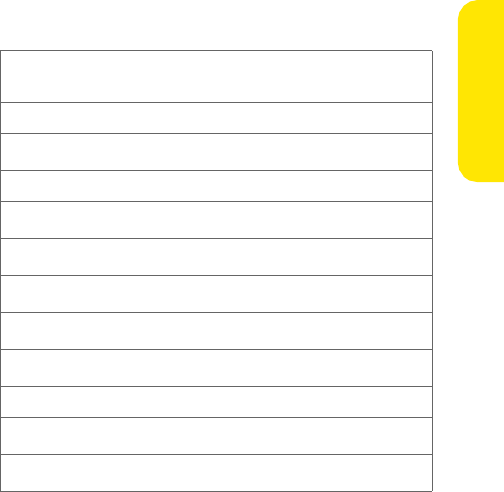
Section 1B: Your Phone: The Basics 36
Phone Basics
Characters scroll in the following order:
Entering Numbers, Symbols, and Preset Messages
To enter numbers:
ᮣSelect the Numbers mode and press the appropriate key.
(See “Selecting a Character Input Mode” on page 33.)
To enter symbols:
ᮣSelect the Symbols mode. (See “Selecting a Character
Input Mode” on page 33.) To enter a symbol, press the
appropriate key indicated on the display screen.
1. ? ! , @ ' - _ : ; ( ) & " 1 0 ^ ` % $ + * / \ | ~ [ ] = >
< #
2A B C 2
3D E F 3
4G H I 4
5J K L 5
6M N O 6
7P Q R S 7
8T U V 8
9W X Y Z 9
00 (no letters)
#Space
*Shift

37
Section 2
Using Your Phone

Section 2A: Making and Answering Calls 38
Making Calls
Section 2A
Making and Answering Calls
In This Section
ࡗTypes of Calls
ࡗMaking and Answering Phone Calls
ࡗMaking and Answering Walkie-Talkie Calls
ࡗMaking and Answering Talkgroup Calls
ࡗMaking and Answering Direct Talk Calls
ࡗUsing Call Alerts
ࡗMissed Calls
Your ic502 by Motorola offers many different ways to connect to
your family, friends, and associates. In addition to traditional
wireless phone calls, you can make Walkie-Talkie calls to both
individuals and groups, participate in Talkgroups, use Direct
Talk, and send Call Alerts.
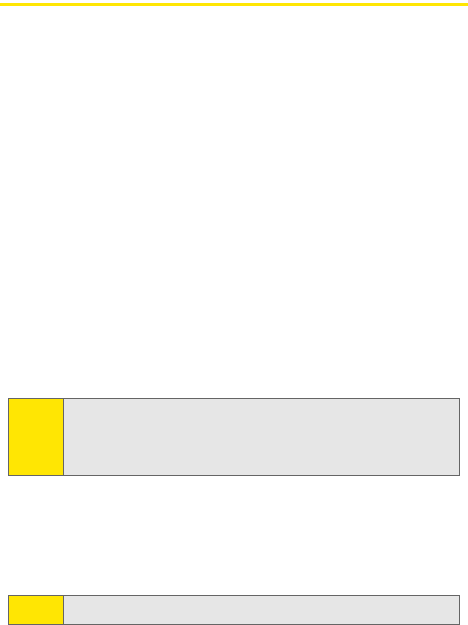
39 Section 2A: Making and Answering Calls
Types of Calls
With your Sprint Nationwide Network, Nextel Nationwide
Walkie-Talkie Network, and your ic502 by Motorola, you have
the following traditional wireless phone and Walkie-Talkie
services available to you:
ⅷDigital Wireless Phone Calls offer clear calls and many extra
services, including missed call notification, three-way
calling, speakerphone, and speed dialing (page 40).
ⅷDigital Walkie-Talkie Calls allow two-way radio
communication to other Nextel Walkie-Talkie users in
your local coverage areas, within the Nationwide Nextel
Network (page 49).
ⅷGroup Walkie-Talkie Calls allow coast-to-coast two-way
radio calling to up to 20 Nextel Walkie-Talkie customers
simultaneously (page 52).
ⅷTalkgroup Calls allow two-way radio calling to up to 100
Nextel Talkgroup customers simultaneously (page 57).
ⅷDirect Talk Calls allow two-way radio communication
between two or more Direct Talk-capable Nextel phones.
These calls can be made without using the network
(page 60).
Note: To learn more about the differences between
Group Walkie-Talkie calls and Talkgroup calls, please see
“Difference Between Group Walkie-Talkie and Talkgroup
Calls” on page 57.
Note: Please see your service plan for information on pricing.
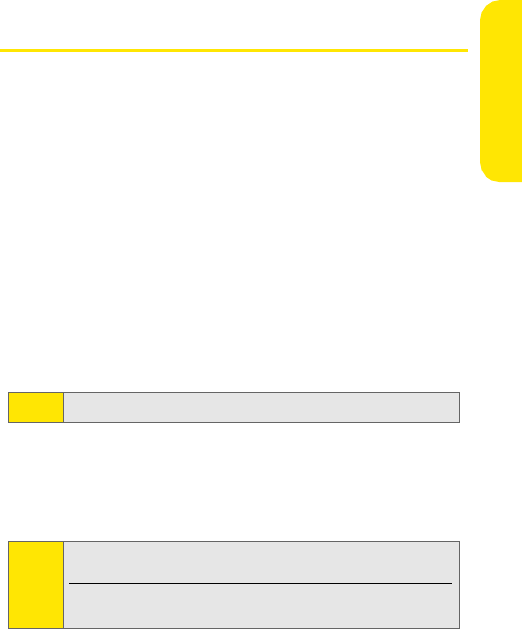
Section 2A: Making and Answering Calls 40
Making Calls
Making and Answering Phone Calls
Making Calls
Placing a traditional, wireless phone call from your phone is
as easy as making a call from any landline phone.
To make a phone call using your keypad:
1. Make sure your phone is on and open.
2. Enter a phone number from standby mode. (If you make
a mistake while dialing, press c to erase one digit at a
time. Press and hold c to erase the entire number.)
3. Press s. (To make a call when you are roaming and Call
Guard is enabled, highlight Roam Call and press s. See
“Using Call Guard” on page 107.)
4. Press e or close the phone when you are finished.
Answering Calls
To answer an incoming call:
1. Make sure your phone is on.
2. Press s to answer an incoming call.
– or –
Press Answer (left softkey).
Depending on your phone’s settings, you may also answer
incoming calls by opening the phone or by pressing any
Tip: To redial your last outgoing call, press s twice.
Note: When your phone is off, incoming phone calls go directly to
voicemail. Walkie-Talkie calls are not forwarded to voicemail.
If you are on another phone call or Walkie-Talkie call, or using
data services, please see “Missed Phone Calls” on page 41.

41 Section 2A: Making and Answering Calls
number key. See “Call Answer Mode” on page 87 for more
information.
Your phone notifies you of incoming calls in the following
ways:
ⅷThe phone rings or vibrates.
ⅷThe indicator light flashes green and red.
ⅷThe backlight illuminates.
ⅷThe external and internal displays show an incoming call
message. If the incoming call is from a number stored in
your Contacts, the entry’s name and/or number appears.
Answering a Roam Call With Call Guard Enabled
Call Guard is an option that helps you manage your roaming
charges when making or receiving calls while outside the
Nationwide Sprint Network. Please see “Controlling Your
Roaming Experience” on page 103 for more information
about roaming.
To answer a call when you are roaming and Call Guard is
enabled:
ᮣSelect Answer to answer the call. (See “Using Call
Guard” on page 107 for additional information.)
Ending a Call
To disconnect a call when you are finished:
ᮣClose the phone or press e.
Missed Phone Calls
Missed phone calls are always forwarded to voicemail. They
may also appear under Events, a list that notifies you of
missed alarms, messages, meetings on the calendar, and
Note: You can also end a call by pressing ..

Section 2A: Making and Answering Calls 42
Making Calls
more. The Events list must contain at least one item before it
displays on the phone.
See “Missed Calls” on page 70 for information on how your
phone manages incoming calls.
Calling Emergency Numbers
You can place calls to 911 (dial 9 1 1 and press s), even if
your phone is locked or your account is restricted.
During an emergency call, press Options (right softkey) to
display your options. To select an option, highlight it and
press O.
ⅷSpeaker On to activate speakerphone mode. (If you are in
speakerphone mode, the option appears as Speaker Off to
deactivate.)
ⅷUnlock Phone to unlock your phone (appears only if the
phone is locked).
ⅷClose Menu to close the pop-up menu (appears only if the
phone is unlocked).
Note: When you place an emergency call, your phone automatically
enters Emergency mode. Your phone exits Emergency mode
five minutes after you end the emergency call.
You cannot make any Walkie-Talkie calls when your phone is
in Emergency mode.
Tip: You can also turn speakerphone on and off by pressing t.
Tip: Press My Phone (left softkey) to display your phone number
during an emergency call.

43 Section 2A: Making and Answering Calls
To exit Emergency mode:
1. Press e to end a 911 call.
2. Press Options (right softkey) to display the options
menu.
3. Highlight Exit Emergency and press O.
To select Emergency mode options:
1. Press e to end a 911 call.
2. Press Options (right softkey).
ⅢCall 911 to call 911.
ⅢCall 911: Speaker to call 911 in speakerphone mode.
ⅢExit Emergency to exit Emergency mode.
3. Highlight an option and press O.
Emergency Mode With an Inactive SIM Card
You can still make emergency calls if your SIM card is not
working or if your SIM security code is not being accepted.
When making an emergency call in these circumstances, your
only in-call options are Speakerphone on or off.
In-Call Options
Pressing Options (right softkey) during a call displays a list of
features you may use during the course of a call. To select an
option, press the corresponding keypad number or highlight
the option and press O. The following options are available
through the Options menu:
ⅷSelect Speaker On to route the phone’s audio through the
speaker. You can adjust the speaker volume using the
volume keys on the side of the phone.
Note: When you are in Emergency mode, you can only exit from the
Options menu.
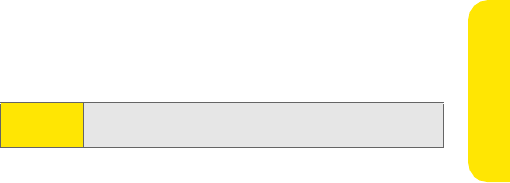
Section 2A: Making and Answering Calls 44
Making Calls
ⅷSelect Speaker Off to use the phone’s earpiece.
ⅷYou can also turn the speakerphone on or off by pressing
t during a phone call.
ⅷContacts opens your phone’s address book.
ⅷ3-Way Call lets you initiate a three-way call
(see page 160).
ⅷRecord Recipient creates a Voice Record of the call.
ⅷPhone Info. opens your Phone Info menu.
ⅷMessaging opens your Messaging menu.
ⅷCall History opens your Call History lists.
ⅷCalendar opens your appointment Calendar.
ⅷTools opens your Tools menu.
During a call, the left softkey button functions as the Mute
button. Press it to mute the phone’s microphone for privacy.
Press it again to Unmute the phone.
End-of-Call Options
After receiving a call from or making a call to a phone number
that is not in your Contacts, the phone number and the
duration of the call are displayed. The left softkey displays the
Save option. Select this option if you wish to add the new
number to your Contacts. (See “Saving a Phone Number”
below.)
If you have just finished a call with some one listed in your
Contacts, the entry’s name and phone number and the
duration of the call are displayed. Press Options (right softkey)
to view the Contacts entry.
WARNING Due to higher volume levels, do not place the phone
near your ear during speakerphone use.

45 Section 2A: Making and Answering Calls
Saving a Phone Number
Your phone can store up to eight phone numbers in each
Contacts entry. Each entry’s name can contain 24 characters.
Your phone automatically sorts the Contacts entries
alphabetically. (For more information, see “Using Contacts”
on page 119.)
To save a number from standby mode:
1. Enter a phone number.
2. Press Options (right softkey).
3. Select Save and press O.
4. Select New Entry and press O. Scroll to Name and use
the numeric keypad to enter the new contact name,
then press Save (left softkey).
– or –
Select To Existing Entry and press O. Scroll to the existing
entry where you want to save the number and press O,
then press Save (left softkey).
Dialing and Saving Phone Numbers With Pauses
You can dial or save phone numbers with pauses for use with
automated systems, such as voicemail or credit card billing
numbers.
There are two types of pauses available on your phone:
ⅷHard Pause sends the next set of numbers when you
press the left softkey.
ⅷ2Sec Pause automatically sends the next set of numbers
after two seconds.
Note: The End-of-Call options are not displayed for calls identified
as No ID or Restricted.
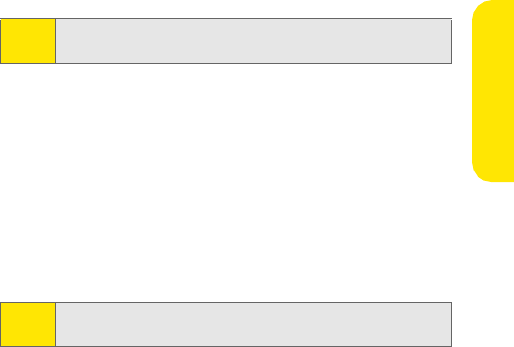
Section 2A: Making and Answering Calls 46
Making Calls
To dial or save phone numbers with pauses:
1. Enter the phone number.
2. Press Options (right softkey) and select either Hard Pause
or 2Sec Pause.
3. Enter additional numbers.
Press O to dial the number.
– or –
Press Options (right softkey) and select Save to save the
number in your Contacts.
Plus (+) Code Dialing
When placing international calls, you can use Plus Code
Dialing to automatically enter the international access code
for your location (for example, 011 for international calls
placed from the United States).
To make a call using Plus Code Dialing:
1. Press and hold 0 until a “+” appears on your display
screen.
2. Dial the country code and phone number you’re calling
and press s. (The access code for international dialing
is automatically dialed, followed by the country code
and phone number.)
Abbreviated Dialing
You can set up your phone to make calls using just the last
four digits of the number. Your phone automatically prepends
the first digits.
Note: You can have multiple pauses in a phone number and
combine two-second and hard pauses.
Note: When dialing a number with a hard pause, press OK (left
softkey) to send the next set of numbers.

47 Section 2A: Making and Answering Calls
For example, you may need to dial different numbers at a
business, where the numbers share the first six digits and the
extensions are identified by the last four digits.
To make a call using only the last four digits of the number:
1. Enter the last four digits of a phone number.
2. Press s.
Dialing From the Contacts List
To dial directly from a Contacts entry:
1. Press O > Contacts > Find All Names.
2. Scroll to the phone number you want to call and press
s.
– or –
To call another number from the entry, highlight the
name and press O, then scroll to the phone number you
wish to call and press s.
Using Speed Dialing
You can store up to 900 numbers in your phone’s speed dial
memory to make contacting friends and family easier. With
this feature, you can speed dial entries using one keypress for
locations 1-9, two key presses for locations
10-99, and three key presses for locations 100-900.
Note: You must enable Abbreviated Calling and define the first
digits before you can use this feature. To set up Abbreviated
Calling, see “Calling Options” on page 88.
Note: You must enable speed dialing before you can use it. See
“Calling Options” on page 88 for instructions.
Speed dialing is not available when you are roaming; when
you are roaming off the Nationwide Sprint Network, you
must always dial using 11 digits (1 + area code + number).

Section 2A: Making and Answering Calls 48
Making Calls
For Speed Dial locations 1-9 (One-Touch Dialing):
ᮣPress and hold the appropriate key for approximately
two seconds. The display screen confirms that the
number has been dialed when it shows “Calling...”.
For Speed Dial locations 10-99 (Two-Touch Dialing):
1. Press the first digit.
2. Press and hold the second digit for approximately two
seconds. The display screen confirms that the number
has been dialed when it shows “Calling...”.
For Speed Dial locations 100-900 (Three-Touch Dialing):
1. Press the first two digits.
2. Press and hold the third digit for approximately two
seconds. The display screen confirms that the number
has been dialed when it shows “Calling...”.
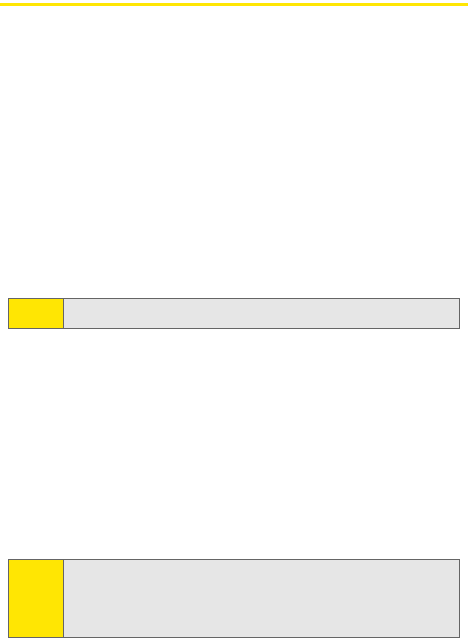
49 Section 2A: Making and Answering Calls
Making and Answering Walkie-Talkie Calls
Making Walkie-Talkie Calls
To make a Walkie-Talkie call:
1. Enter the Walkie-Talkie number you want to call. (See
“Dialing Walkie-Talkie Numbers” below.)
2. Press and hold the Walkie-Talkie button on the side of
your phone. Begin talking after your phone emits a
chirping sound.
3. Release the Walkie-Talkie button to listen.
A Walkie-Talkie call ends automatically after there is no
activity on the call for several seconds.
Dialing Walkie-Talkie Numbers
Every Walkie-Talkie number has three parts —
ⅷAn area ID.
ⅷA network ID.
ⅷA member ID.
An asterisk separates each part (for example: 999*999*9999).
When you place a Walkie-Talkie call, you must enter the
whole number including the asterisks.
Note: You can also end a call by pressing ..
Note: The number of digits in each part of a Walkie-Talkie number
may vary. For example, your Walkie-Talkie number may be
formatted as 999*999*9999, while another valid number
may appear as 555*555555*55.
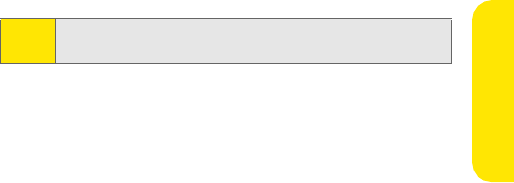
Section 2A: Making and Answering Calls 50
Making Calls
Using Walkie-Talkie Contacts
The Walkie-Talkie Contacts feature filters Contacts and Call
History to display only Walkie-Talkie numbers. This makes it
easy to dial frequently callers.
To make a Walkie-Talkie call from Walkie-Talkie Contacts:
1. Press O > Walkie-Talkie > Walkie-Talkie Contacts.
2. Use your left and right navigation keys to select Contacts
or Call History.
3. Highlight the Walkie-Talkie number you want to call.
4. Press and hold the Walkie-Talkie button on the side of
your phone. Begin talking after your phone emits a
chirping sound.
5. Release the Walkie-Talkie button to listen.
Using Just the Member ID
To make a Walkie-Talkie call using only the member ID:
1. Enter the last four digits of a Walkie-Talkie number.
2. Press and hold the Walkie-Talkie button on the side of
your phone. Begin talking after your phone emits a
chirping sound.
3. Release the Walkie-Talkie button to listen.
Your phone connects you to a number with your same area
and network IDs, and the member ID you just entered.
Answering Walkie-Talkie Calls
When you receive a Walkie-Talkie call, your phone emits a
chirping sound or vibrates, and the Walkie-Talkie button
flashes. You then hear the sound of your caller.
Tip: When you store a Walkie-Talkie number in Contacts, it is good
practice to include the whole number, including the asterisks.

51 Section 2A: Making and Answering Calls
To answer a Walkie-Talkie call:
1. Wait for the caller to finish speaking.
2. Press and hold the Walkie-Talkie button on the side of
your phone.
3. After your phone emits a chirping sound, talk.
4. Release the Walkie-Talkie button to listen.
5. Press e or select Exit (left softkey) to end the call.
A Walkie-Talkie call ends automatically after there is no
activity on the call for several seconds.
Sending Walkie-Talkie Contact Information
Use Send via WLK-TLK to send your own or another caller’s
Walkie-Talkie contact information to a person who wants to
use it.
To send Walkie-Talkie contact information using
Send via WLK-TLK:
1. Press O > Walkie-Talkie > Walkie-Talkie Contacts.
2. Use your left and right navigation keys to select Contacts
or Call History.
3. Scroll to the number you want to send the contact
information of and then press Options (left softkey).
4. Select Send via WLK-TLK.
Missed Walkie-Talkie Calls
Unlike phone calls, missed Walkie-Talkie calls are not
forwarded to voicemail. They may appear under Events, a list
that notifies you of missed alarms, messages, meetings on
the calendar, and more. The Events list must contain at least
one item before it displays on the phone.
Note: You can also end a call by pressing ..

Section 2A: Making and Answering Calls 52
Making Calls
See “Missed Calls” on page 70 for information on how your
phone manages missed Walkie-Talkie calls.
Using Speakerphone for Walkie-Talkie Calls
You can answer Walkie-Talkie calls directly on speakerphone
by using t and . — all without opening your phone.
To answer a Walkie-Talkie call using speakerphone:
ᮣPress t.
To end the Walkie-Talkie call:
ᮣPress ..
Group Walkie-Talkie Calls
A Group Walkie-Talkie call is made to multiple Walkie-Talkie
users at once. You can call up to 20 persons anywhere on the
Nationwide Sprint Network on their Group Walkie-Talkie
compatible phones.
These Groups do not have established memberships. They are
created by you or other Group Walkie-Talkie users. A Group
can be set up for one-time use or it can be stored in Contacts
for repeated use.
For information on creating Groups and storing them in
Contacts, see “Contacts Entries for Walkie-Talkie Groups and
Talkgroups” on page 127.
Making Group Walkie-Talkie Calls
To make a Group Walkie-Talkie call:
1. From Contacts or a Call History list, scroll to and select
the Group you want to call.
2. Press the Walkie-Talkie button and continue as if
making a regular Walkie-Talkie call.

53 Section 2A: Making and Answering Calls
Creating a Group During a Walkie-Talkie Call
You can create a Group during a call, adding members as you
need them. (You need to select Walkie-Talkie numbers
capable of participating in Group Walkie-Talkie calls.)
1. Enter the Walkie-Talkie number you want to use to
begin the Group Walkie-Talkie call.
2. Press O.
3. Select Call New Group.
4. Add more Group members. See “Adding Group
Members” on page 128
5. To make the call, press and hold the Walkie-Talkie
button.
Creating a Group Using Walkie-Talkie Contacts
You can create a Group using the Walkie-Talkie Contacts
menu. (You need to select a Walkie-Talkie numbers capable of
participating in Group Walkie-Talkie calls.)
To make a Group using Walkie-Talkie Contacts:
1. Press O > Contacts > Walkie-Talkie Contacts.
2. Use the left and right navigation keys to select Contacts
or Call History.
3. Highlight each entry you want to call and select Options
(right softkey) and then select Save Group.
Note: You can also highlight a call from Walkie-Talkie Contacts.
Press O > Walkie-Talkie > Walkie-Talkie Contacts > Contacts or
Call History.
Note: To save the Group you have created, press O and select Save
Group.

Section 2A: Making and Answering Calls 54
Making Calls
4. Enter the Group name, Category, add members, and
select Save (left softkey). See “Creating Group Walkie-
Talkie Entries” on page 127.
Answering Group Walkie-Talkie Calls
When you receive a Group Walkie-Talkie call, the name of the
Group appears on your internal and external displays.
To answer a Group Walkie-Talkie call:
1. Wait for the caller to finish speaking.
2. Press and hold the Walkie-Talkie button on the side of
your phone.
3. After your phone emits a chirping sound, talk.
4. Release the Walkie-Talkie button to listen.
5. Press e or select the Exit (left softkey) to leave the
Group call.
Only one person may speak on a Group call at a time.
Group Walkie-Talkie Call Information
While you are on a Group Walkie-Talkie call, the following
appears on the display screen:
ⅷThe name of the Group.
ⅷThe name or the Walkie-Talkie number of the person
speaking.
ⅷThe number of participants in the Group Walkie-Talkie
call.
Group Walkie-Talkie Call Details
During a Group Walkie-Talkie call, you can view details about
the other Group members, such as their name, Walkie-Talkie
number, and their status on the call.

55 Section 2A: Making and Answering Calls
To view call details while on a Group Walkie-Talkie call:
ᮣPress Details (right softkey).
Your display screen shows the names of the Group members
next to an icon identifying their status on the call.
Sharing Groups
You share Groups by saving Groups from calls you
participated in and by sending Groups to other callers.
To store Groups from Call History:
1. Press O > Call History > All Calls or Walkie-Talkie Calls.
2. From the list, select the Group you want.
3. Press Options (right softkey) and then select Save.
4. Press New Entry.
5. Enter the Group name, Category, and edit the
membership list, if necessary.
6. Press Save (left softkey).
To store a Group during an active Group Walkie-Talkie call:
1. During an active Group call, press O.
2. Select Store Group.
3. Enter the Group name, Category, and edit the
membership list, if necessary.
The Group member who is currently speaking.
A Group member who is active on the Group call,
but is not speaking.
A Group member who has exited the call.
A Group member who could not be reached on
the Group call.
A Group member whose status is unknown.

Section 2A: Making and Answering Calls 56
Making Calls
4. Press Save (right softkey).
Using Send via WLK-TLK
Use Send via WLK-TLK to forward an established Group to
another caller who wants to use it.
To forward a Group using Send via WLK-TLK:
1. Press O > Contacts.
2. Scroll to the Group you want to send and then press
Options (left softkey).
3. Select Send via WLK-TLK.
4. Select Yes or No to include or exclude yourself from the
Group.
5. Use the left and right navigation keys to select Contacts
or Call History.
6. Highlight the caller you want to forward the Group to
and press O.
7. Push the Walkie-Talkie button to send the Group.
Note: If you choose to include yourself and the list already contains
the maximum number of members, you will be prompted
that the list is full. You will then be excluded from the list.

57 Section 2A: Making and Answering Calls
Making and Answering Talkgroup Calls
A Talkgroup is a predetermined group that has been created
by Sprint or an account administrator. Talkgroups are limited
by network (fleet) and local markets. They can contain up to
100 members in the local market.
Difference Between Group Walkie-Talkie and
Talkgroup Calls
In a Group Walkie-Talkie call, you or another caller determines
who can participate in the call. By contrast, participation in a
Talkgroup is determined by an administrator. Here are the
ways Group Walkie-Talkie and Talkgroup calls differ.
Joining a Talkgroup
If you subscribe to this service, after enabling security, you
will receive a list of Talkgroups that have been set up for you.
The Talkgroup list is saved to Contacts. To receive Talkgroup
Group Talkgroup
Group Icons
Geography Nationwide. Limited to local
market and
network (fleet).
Maximum
Group Size
21 (including
originator).
100.
Set-up Dynamically, via
your phone.
Predefined, via
administrator using
Tal k g r ou p
Management.
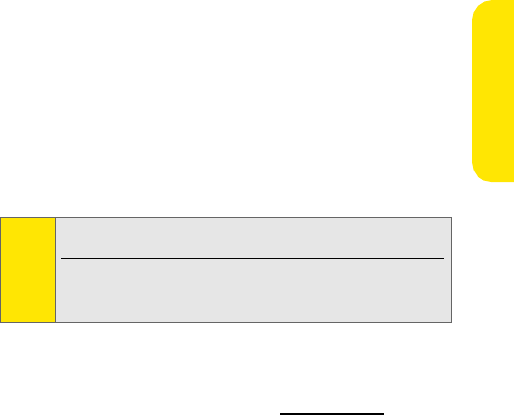
Section 2A: Making and Answering Calls 58
Making Calls
calls made to any of these Talkgroups, you must join the
Talkgroup.
To join a Talkgroup:
1. Press O > Contacts > Filter Names.
2. Highlight Talkgroup and then press O.
3. Scroll to the Talkgroup you want to join.
4. Press Join (right softkey).
Adding More Talkgroups
You can add more Talkgroups in three ways:
ⅷUsing Talkgroup Management at www.sprint.com You must
be an account administrator to use Talkgroup
Management.
ⅷContacting your Sprint Sales Representative at the time of
activation.
Making Talkgroup Calls
To make Talkgroup calls:
1. Press # and then enter the Talkgroup number using the
keypad.
– or –
Choose the Talkgroup name from Contacts or Call History.
2. Press the Walkie-Talkie button and continue as if
making a Walkie-Talkie call.
Note: You are now able to receive communications from this
Talkgroup only. You can only monitor one Talkgroup at a time.
After you join a Talkgroup, you will hear active Talkgroup calls
on your phone. To silence them, go to O > Settings >Walkie-
Talkie > Talkgroup Silent and select On.
59 Section 2A: Making and Answering Calls
Receiving Talkgroup Calls
To answer a Talkgroup call:
ᮣProceed as if answering a Walkie-Talkie call.
Only one person at a time may speak on a Talkgroup call. The
Walkie-Talkie number or name of the person who is speaking
appears on the display screen below the Talkgroup number.
Missed Talkgroup Calls
Unlike phone calls, missed Talkgroup calls are not forwarded
to voicemail. They may appear under Events, a list that
notifies you of missed alarms, messages, meetings on the
calendar, and more. The Events list must contain at least one
item before it displays on the phone.
See “Missed Calls” on page 70 for more information.
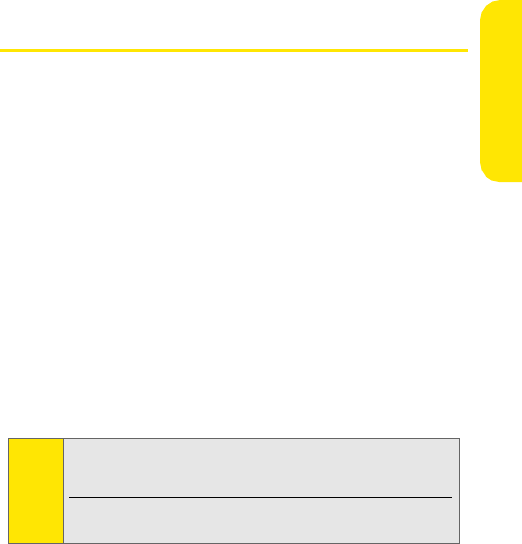
Section 2A: Making and Answering Calls 60
Making Calls
Making and Answering Direct Talk Calls
Direct Talk allows for two-way radio communication “off the
network” between two or more phones equipped with this
capability. This feature is very useful in areas without
network coverage.
You can make -
ⅷCode calls – two-way radio calls conducted off the network
and using open channels and codes.
ⅷPrivate calls – two-way radio calls conducted off the
network and using the wireless phone numbers of the
participants.
Code calls require that both parties be on the same channel
and code and have their phones set to Direct Talk. Phones
used in Direct Talk mode should be a minimum of 6 feet apart
to maximize performance and improve transmission range.
See “Code Direct Talk Calls” on page 62 for more information.
The following features are not be available while in Direct
Talk mode:
ⅷOn-network phone calls.
ⅷOn-network Walkie-Talkie, Group Walkie-Talkie, and
Talkgroup calls.
ⅷSprint Data Services.
ⅷSending and receiving messages.
ⅷCalendar.
Note: You can only make code calls to users located within your
range. This varies according to terrain, man-made structures,
and atmospheric conditions.
Direct Talk is not compatible with older Family Radio Services
products.

61 Section 2A: Making and Answering Calls
ⅷAlarms.
ⅷCall timer.
ⅷSending Call Alerts
ⅷCall forwarding.
Setting Your Phone To Direct Talk
To set your phone to Direct Talk:
1. Press O > Walkie-Talkie > Direct Talk.
2. Select Go To Direct Talk. (Switching to Direct Talk Please
Wait appears.)
After a few seconds, the Direct Talk standby screen appears.
Your channel appears on the first line of the display screen,
your code appears on the second line of the display screen
and DT Ready appears just above the softkeys.
When switching from the network to Direct Talk, the last
channel and code used appear on the standby screen. While
in Direct Talk, your display screen indicates there is no
network signal and Direct Talk is active.
To return to network mode when Direct Talk is active:
1. From the Direct Talk standby screen, press O.
2. Scroll to DT Options and press O.
3. Select Exit DirecTalk. (Switching to Network Please Wait
appears.)
After a few seconds, the network standby screen appears.
Code Direct Talk Calls
Note: Before you and another caller can use Direct Talk, both of your
phones must be set to Direct Talk mode.

Section 2A: Making and Answering Calls 62
Making Calls
Your phone has 10 channels and 15 codes. Channels are
divided into sets of frequencies that allow you to make and
receive Direct Talk calls. Codes help minimize interference
from unwanted messages and other disturbances when you
are on the same channel as others.
Other parties may also be talking on the same channel. When
making a code call, anyone within range and using the same
code and channel can hear your conversation.
To set a channel:
1. From the Direct Talk standby screen, press Edit (right
softkey).
2. Scroll to Channel.
3. Press Edit (right softkey).
4. Select a channel.
5. When you are finished, press Back (right softkey) to
return to the standby screen.
To set a code:
1. From the Direct Talk standby screen, press Edit (right
softkey).
2. Scroll to Code.
3. Press Edit (right softkey).
4. Select a code.
5. When you are finished, press Back (right softkey) to
return to the standby screen.
Note: Before you and another caller can make Code calls, both of
your phones must be set to Direct Talk and to the same code
and channel.

63 Section 2A: Making and Answering Calls
Making and Receiving Code Calls In Direct Talk
Mode
To make a code call using Direct Talk:
1. Press and hold the Walkie-Talkie button. DT Transmit
appears on the first line of the display screen. Begin
speaking after your phone emits the Direct Talk tone.
2. Release the Walkie-Talkie button to listen.
The tone emitted from your phone when making a Direct Talk
call is four beeps and sounds different from the standard tone
heard with Walkie-Talkie and Group Walkie-Talkie calls.
If you receive an error message, this means:
ⅷThere may be no parties on your channel or code.
ⅷYou are out of range.
When you receive a code call using Direct Talk, DT Receive
appears on the first line of the display screen.
Receiving Calls On All Channels
You can set your phone to receive Direct Talk transmissions
from any phone that is in range and set to the same channel,
regardless of the code (1-15), by setting the code to Receive
All. When you receive transmissions with the code set to
Receive All, the display screen changes from Receive All to the
code on which the transmission was received.
Note: Every other person tuned to same code and channel can hear
your call.
Note: You cannot initiate a call when the code is set to Receive All. If
you press the Walkie-Talkie button with the code set to
Receive All, you receive an error message.

Section 2A: Making and Answering Calls 64
Making Calls
To set the code to Receive All:
1. From the Direct Talk standby screen, press Edit (right
softkey).
2. Scroll to Code.
3. Press Edit (right softkey).
4. Select Receive All.
When you are finished, select Back to return to the standby
screen.
Private Direct Talk Calls
You can have a private conversation with another person
using Direct Talk. When on a private Direct Talk call, no other
party can hear your conversation. In order to make a private
Direct Talk call, you must use the valid 10-digit wireless
phone number of the person you are calling. The person you
are calling must be in Direct Talk mode and set to the same
channel to receive your call.
If you receive an error message, it means:
ⅷYou may not be using a valid wireless phone number.
ⅷThe person that you are trying to reach may not be in
Direct Talk mode.
ⅷThe person that you are trying to reach is set to a different
channel or is out of range.
Private Only
To limit Direct Talk to private conversation only, set your code
to Private Only. In this mode, code calls are ignored and only
private calls can be made or received.
You are required to enter a valid wireless phone number
before pressing the Walkie-Talkie button.
65 Section 2A: Making and Answering Calls
To set the code to Private Only:
1. From the Direct Talk standby screen, press Edit (right
softkey).
2. Scroll to Code.
3. Press Edit (right softkey).
4. Select Private Only.
Making a Private Direct Talk Call
To make a private Direct Talk Call:
1. Enter the 10-digit wireless phone number of the person
you want to call on your channel. (You can also scroll to
the number in Contacts or Call History.)
2. Press and hold the Walkie-Talkie button. Begin speaking
after your phone emits the Direct Talk tone.
3. Release the Walkie-Talkie button to listen. The number
or name of the person you are calling appears in the
first line of the display screen.
Receiving a Private Direct Talk Call
The number or name of the person who initiated the call
appears in the first line of the display screen. Answer the call
in the same way you answer a regular Walkie-Talkie call.
Ending a Private Direct Talk Call
A Private Direct Talk call ends a short time after the last party
releases the Walkie-Talkie button. The display screen returns
to Direct Talk standby mode.
Missed Direct Talk Calls
Because these calls occur off the network, your phone does
not notify you of incoming Direct Talk calls.

Section 2A: Making and Answering Calls 66
Making Calls
Making Emergency Calls While In Direct Talk Mode
If you attempt to make an emergency 911 call while in Direct
Talk mode, your phone automatically exits Direct Talk mode
and attempts to find a network signal.
If you are out of network coverage, your phone cannot make
an emergency 911 call until you return to the network
coverage area. You must wait until the phone reconnects to
the network before attempting to make an emergency 911
call.
Direct Talk Setup Options
Direct Talk setup options are available in the DT Options
screen in both network and Direct Talk modes.
You can set your phone to:
ⅷLaunch directly into Direct Talk when you select Direct
Talk from the Walkie-Talkie menu.
ⅷNotify you periodically with a tone that you are in Direct
Talk mode.
Using Direct Launch
To set your phone to launch into Direct Talk:
1. From the Direct Talk standby screen, select Select Setup.
2. Select Direct Launch and press O.
3. Select On.
If Direct Launch is set to On, you do not see DT Options when
you select Direct Talk from the menu. In order to have access
to your setup options, Direct Launch must be set to Off. Or,
you can access setup options while in Direct Talk mode by
pressing O and selecting DT Options.
67 Section 2A: Making and Answering Calls
To turn off Direct Launch:
1. From the Direct Talk standby screen, select Select Setup.
2. Select Direct Launch and press O.
3. Select Off.
Your phone now displays DT Options when you select Direct
Talk from the Walkie-Talkie menu.
Using State Tone
To set your phone to periodically notify you with a tone that you
are in Direct Talk:
1. From the Direct Talk standby screen, select Select Setup.
2. Select Direct Launch (State Tone) and press O.
3. Select the time frame during which you want to be
notified that you are in Direct Talk. For example, if you
select 1 hour, you are notified every hour that you are in
Direct Talk.
To turn off State Tone:
1. From the Direct Talk standby screen, select Select Setup.
2. Select Direct Launch and press O.
3. Select Off.

Section 2A: Making and Answering Calls 68
Making Calls
Using Call Alerts
Sending a Call Alert lets the recipient know you want to talk
to him or her on a Walkie-Talkie call. When you send a Call
Alert, the recipient’s phone emits a series of beeps or vibrates,
and displays your name or Walkie-Talkie number.
The recipient can:
ⅷAnswer — Call the sender via Walkie-Talkie.
ⅷView — View the time and date on which the Call Alert
was received.
ⅷDismiss — Delete the Call Alert.
Sending Call Alerts
To send a Call Alert:
1. Enter the Walkie-Talkie number you want to send the
alert to.
2. Press Alert (left softkey).
3. Press the Walkie-Talkie button until Alert Sent to appears
on the display screen.
If the alert is not successful, this may mean the person you
are trying to reach is on a call or has the phone turned off.
Responding to a Call Alert
Note: You can send a Call Alert from Call History. Press
O > Call History > All Calls or Walkie-Talkie Calls, highlight the
number you want to send a Call Alert to and press Alert (left
softkey).
Note: You can set a distinctive ringer for Call Alerts. See “Ringer
Types” on page 74.
69 Section 2A: Making and Answering Calls
To answer a Call Alert:
ᮣPress the Walkie-Talkie button to make a Walkie-Talkie
call to the sender.
To clear a Call Alert, do one of the following:
ᮣPress O.
ᮣPress Dismiss (right softkey).
ᮣIf the phone is closed, press ..
Viewing Call Alerts
In Call History, the All Calls and Walkie-Talkie Calls lists store
any Call Alerts you have received. Call Alerts are shown as
regular Walkie-Talkie calls. Call Alerts remain on the
appropriate Call History lists until you delete them or they
reach the end of list.
To view a Call Alert upon receiving it:
ᮣPress View (left softkey).
To view Call Alerts stored in Call History:
1. Press O > Call History > All Calls or Walkie-Talkie Calls.
2. Scroll through the list.
3. Select a Call Alert to view detailed information about it.
Missed Call Alerts
Missed Call Alerts may appear under Events, a list that
notifies you of missed alarms, calls, meetings on the calendar,
and more. The Events list must contain at least one item
before it displays on the phone.
See “Missed Calls” on page 70 for more information.

Section 2A: Making and Answering Calls 70
Making Calls
Missed Calls
Your ic502 by Motorola allows you to communicate with your
family, friends and business associates in many different
ways – phone calls, Walkie-Talkie, Group Walkie-Talkie and
Talkgroup calls, Direct Talk, and text messages. You can even
send Call Alerts via Walkie-Talkie.
Your phone tracks these communications through Call
History and your Messaging feature. See “Managing Call
History” on page 109 and “Using SMS Text Messaging” on
page 156 for more information.
You phone may also notify you incoming calls as they are
occurring. How it does so depends on the type of call,
whether the phone is powered on or off, and on what type
activity it is engaged in when the missed call occurs.
Incoming Phone Calls
If... Then...
Your phone is turned off. Missed phone calls are sent to voicemail
and are not listed in Call History.
Your phone is in standby
mode, on another phone
call, or a Walkie-Talkie
call.
Your phone displays an incoming call
message and lists the call in Call History. If
unanswered, the call is sent to voicemail.
Your phone is in a data
session, but you are not
transmitting data.
Your phone displays an incoming call
message. If you do not answer the call, it is
listed in Call History and sent to voicemail.
Your phone is in a data
session and you are
transmitting data.
Your phone does not display an incoming
call message while the call is occurring.
It only displays the message after the data
session ends. The missed call is listed in
Call History and sent to voicemail.

71 Section 2A: Making and Answering Calls
Missed Walkie-Talkie Calls, Talkgroup Calls, and Call
Alerts
Your phone does not forward missed Walkie-Talkie calls or Talkgroup calls
to voicemail.
Missed Group Walkie-Talkie Calls
If you are actively using your phone, you do not receive a
notification of missed Group Walkie-Talkie calls nor are they
forwarded to voicemail. You only receive notification of an
incoming Group Walkie-Talkie call when your phone is in
standby mode.
Missed Group Walkie-Talkie calls are listed in Call History.
If... Then...
Your phone is turned off. Your phone does not list Walkie-Talkie calls,
Talkgroup calls, or Call Alerts in Call History.
Your phone is in standby
mode or on a phone call.
Your phone displays an incoming call
message for Walkie-Talkie and Talkgroup
calls, or it displays the Call Alert. They are
also listed in Call History.
You are on a Walkie-
Talkie call.
Your phone does not display a notice for
incoming Walkie-Talkie or Talkgroup calls.
It does display the Call Alert.
Walkie-Talkie calls, Talkgroup calls, and Call
Alerts are listed in Call History.
Your phone is i n a data
session, but you are not
transmitting data.
Your phone interrupts the data session
with an incoming call message for
Walkie-Talkie and Talkgroup calls, or it
displays the Call Alert. They are listed in
Call History.
Your phone is i n a data
session and you are
transmitting data.
Your phone lists the call or Call Alert in Call
History and displays the notification (or
Call Alert) after you finish your data
session.

73 Section 2B: Controlling Your Phone’s Settings
Section 2B
Controlling Your Phone’s Settings
In This Section
ࡗSound Settings
ࡗDisplay Settings
ࡗLocation Settings
ࡗMessaging Settings
ࡗAirplane Mode
ࡗTTY Use With Sprint Service
ࡗPhone Setup Options
ࡗWalkie-Talkie Settings
Using the menu options available on your phone, you can
customize your phone to sound, look, and operate just the way
you want it. This section describes how you can change your
phone’s settings to best suit your needs. Take a few moments
to review these options and to adjust or add settings that are
right for you.

Section 2B: Controlling Your Phone’s Settings 74
Your Phone’s SettingsYour Phone’s Settings
Sound Settings
Ringer Types
Ringer types help you identify incoming calls and messages.
You can assign ringer types to individual Contacts entries,
types of calls, and types of messages.
ⅷPreprogrammed Ringers include a variety of standard
ringer types and familiar music included with your phone.
ⅷVibrating Ringer alerts you to calls or messages without
disturbing others.
ⅷDownloaded Ringers can be downloaded right to your
phone. (See “Downloading Premium Services Content” on
page 169.)
Selecting Ringer Types for Phone Calls
Your phone provides a variety of settings that allow you to
customize your ringer and volume settings. These options
allow you to identify incoming calls by ring.
To select a ringer type for voice calls:
1. Press O > Settings > Sounds > Ringer Type.
2. Select Call with ID or Call without ID and press O. The list
of preprogrammed ringers is displayed.
3. Use your navigation key to scroll through the available
ringers. To hear a ringer, press Listen (right softkey).
4. Press Assign (left softkey).
Tip: If you want to hear a unique ringer whenever you are
roaming, you can press O >Settings > Sounds > Ringer Type
>Roam Ringer and choose Distinct. For information about
roaming, see page 103.

75 Section 2B: Controlling Your Phone’s Settings
Selecting Ringer Types for Messages
To select a ringer type for messages:
1. Press O > Settings > Sounds > Ringer Type.
2. Select Text M essage or Voicemail and press O. The list of
preprogrammed ringers is displayed.
3. Use your navigation key to scroll through the available
ringers. To hear a ringer, press Listen (right softkey).
4. Press Assign (left softkey).
Adjusting the Phone’s Volume Settings
You can adjust your phone’s volume settings to suit your
needs and your environment.
To adjust your phone’s volume settings:
1. Press O > Settings > Sounds > Volume.
2. Select Ringer, Messaging, Calendar, Alarm, Applications,
Power On/Off, Key Beep, Voice Call, Speaker Phone, Call
Alert, or Incoming WLK-TLK, and press O.
3. Follow the prompts to choose a volume level and press
Done (left softkey).
Tip: You can also select unique ringers for Call Alerts, calendar
appointments, and alarms. Go to O >Settings >Sounds
>RingerType
and follow the prompts.
Tip: You can adjust the ringer volume in standby mode (or the
earpiece volume during a call) by using the volume key on the
left side of your phone.
To reset your volume setting to factory defaults,
press O > Settings > Sounds > Volume > Reset Volumes.

Section 2B: Controlling Your Phone’s Settings 76
Your Phone’s SettingsYour Phone’s Settings
Sound Indicators
Your phone can alert you with an audible tone when you
change service areas, once a minute during a voice call, or
when a call has been lost or connected.
To enable or disable alert sounds:
1. Press O > Settings > Sounds > Indicators.
2. Select Service (Service Change), Minute Beep, Call Lost, or
Connect (Call Connect) and press O.
3. Select On or Off and press O.
Silence All
There may be times when you need to silence your phone
entirely. The phone’s Silence All option allows you to mute all
sounds without turning your phone off.
To activate Silence All:
ᮣWith the phone open, press and hold the volume
key down in standby mode. (The display screen briefly
displays Silence All and at the top of the screen.)
To deactivate Silence All:
ᮣPress the volume key up repeatedly to select a desired
volume level.

77 Section 2B: Controlling Your Phone’s Settings
Display Settings
Changing the Text Greeting
The text greeting can be up to 12 characters and is displayed
on your phone’s screen in standby mode. You may choose to
keep the phone’s default greeting (“Sprint”), or you may enter
your own custom greeting.
To display or change your greeting:
1. Press O > Settings > Display > Greeting Banner.
2. To change the greeting text, scroll to the greeting and
enter text using your keypad. See “Entering Text” on
page 33 for information on how to enter text.
– or –
To turn off the banner, scroll to Greeting Banner and
press O to clear it.
3. Press Done (left softkey).
Setting Light Controls
You can determine whether, and for how long, to light the
display screen, keypad, Walkie-Talkie button, or status light.
To turn on or off the status light or the light behind the Walkie-
Talkie button:
1. Press O > Settings > Display > Light Control > Status Light
or Walkie-Talkie Button.
2. Select On or Off, as desired.
3. Press O.
The Backlight Control setting lets you select for how long the
display screen is backlit.

Section 2B: Controlling Your Phone’s Settings 78
Your Phone’s SettingsYour Phone’s Settings
1. Press O > Settings > Display > Light Control >
Backlight Control.
2. Select how long the backlight should stay on. (If you
choose Flip Open, the backlight stays on as long as the
phone is open.)
3. Press O.
Your phone’s photosensor measures available light and
determines if the keypad backlight needs to be turned on. If
you turn the photosensor on, the keypad is lit only when it is
needed. If you turn the photosensor off, the keypad stays lit
whenever you are using your phone.
To set the photosensor to measure ambient light:
1. Press O > Settings > Display > Light Control > Keypad.
2. Select Use Light Sensor.
3. Press O.
Note: Long light settings affect the battery’s talk times.
79 Section 2B: Controlling Your Phone’s Settings
Changing the Phone’s Menu Style
Your phone allows you to choose how the menu appears on
your display screen.
To select the display screen’s menu style:
1. Press O > Settings > Display > Menu Style.
2. Select Grid Menu, List Menu, Tab Menu, and then
press O.
ⅢGrid Menu shows the main menu as icons only.
ⅢList Menu shows the main menu as a list of icons
and names.
ⅢTab Menu shows just the selected menu, with the
remaining icons displayed as tabs. Use the left and
right navigations keys to find the menu you want.
Changing the Clock Display
Choose whether you want your phone’s clock to be displayed
in analog mode or digital mode.
To change the clock’s appearance on the standby screen:
1. Press O > Settings > Display > Standby Display
>Clock Type.
2. Select Analog or Digital, then press O.

Section 2B: Controlling Your Phone’s Settings 80
Your Phone’s SettingsYour Phone’s Settings
Changing Other Display Settings
Your ic502 by Motorola offers you many different ways to
customize your display screen.
To change additional display settings:
1. Press O > Settings > Display.
2. Select the display option you want to change. (See
below for a list of options.)
3. Follow the prompts to make your choice.
4. Press O to save your settings.
Screen Saver Scroll through the screen savers.
Set Time/Date Determines how the external and
internal display screens show the time
(12 or 24 hour) and the date formats.
Incoming Calls Allows you to assign different images to
calls with and without an ID.

81 Section 2B: Controlling Your Phone’s Settings
Location Settings
Your phone is equipped with a Location feature for use in
connection with location-based services.
The Location feature allows the network to detect your
position. Turning Location off hides your location from
everyone except 911.
To enable your phone’s Location feature:
1. Press O > Settings > Location. (The Location disclaimer is
displayed.)
2. Read the disclaimer and press O.
3. Select On or Off press O.
When the Location feature is on, your phone’s standby screen
displays the icon. When Location is turned off, the icon
is displayed.
Note: Turning Location on allows the network to detect your
position using GPS technology, making some Sprint
applications and services easier to use. Turning Location off
disables the GPS location function for all purposes except
911, but does not hide your general location based on the cell
site serving your call. No application or service may use your
location without your request or permission. GPS-enhanced
911 is not available in all areas.

Section 2B: Controlling Your Phone’s Settings 82
Your Phone’s SettingsYour Phone’s Settings
Messaging Settings
Staying connected to your friends and family has never been
easier. With your phone’s advanced messaging capabilities,
you can send and receive many different kinds of text
messages without placing a voice call. (For more information,
See “Using SMS Text Messaging” on page 156.)
Your phone’s messaging settings make text messaging even
faster and easier by letting you decide how you would like to
be notified of new messages, create a signature with each
sent message, and create your own preset messages, to name
just a few.
Displaying Pop-up Messages
When you receive a text message, your phone notifies you by
displaying an icon on your display screen. You can also choose
to be notified with a larger pop-up message on your display
screen.
To display pop-up messages:
1. Press O > Messaging > Settings >Notification.
2. Select Msg and Icon and press O.
Setting Message Alerts
When new messages arrive, you can choose to have your
phone notify you by playing an audible alert.
Managing Preset Messages
Your phone is programmed with 15 preset messages to help
make sending text messages faster and easier. These
messages, such as “Let’s get lunch” and “Meet me at,” can be
customized or deleted to suit your needs. You can even add
your own preset messages to the list.
83 Section 2B: Controlling Your Phone’s Settings
To edit or delete a preset message:
1. Press O > Messaging > Text Me ssaging > Preset Messages.
(The list of preset messages is displayed.)
2. To edit or delete a preset message, highlight it and press
Options (right softkey).
3. Select Edit, use your keypad to edit the selected
message, and press Save (left softkey).
– or –
Select Delete to delete the selected message.
To add a new preset message:
1. Press O > Messaging > Text Messaging > Preset Messages.
2. Scroll down and select New Preset Msg and press O.
3. User your keypad to enter your message and press Save
(left softkey).
Your new message is added to the beginning of the list.

Section 2B: Controlling Your Phone’s Settings 84
Your Phone’s SettingsYour Phone’s Settings
Airplane Mode
Airplane Mode allows you to use many of your phone’s
features, such as Games, Calendar, Voice Records, etc., when
you are in an airplane or in any other area where making or
receiving phone calls, Walkie-Talkie calls, or using data
services is prohibited. When your phone is in Airplane Mode,
it cannot send or receive any phone calls, Walkie-Talkie calls,
or access online information.
To set your phone to Airplane Mode:
1. Press O > Settings > Others > Airplane Mode.
2. Select On, Off, or On at Power Up and press O.
While in Airplane Mode, your phone’s standby screen displays
and No Service.

85 Section 2B: Controlling Your Phone’s Settings
TTY Use With Sprint Service
A TTY (also known as a TDD or Text Telephone) is a telecom-
munications device that allows people who are deaf, hard of
hearing, or who have speech or language disabilities, to
communicate by telephone.
Your phone is compatible with select TTY devices. Please
check with the manufacturer of your TTY device to ensure
that it supports digital wireless transmission. Your phone and
TTY device connects via a special cable that plugs into your
phone's headset jack. If this cable was not provided with your
TTY device, contact your TTY device manufacturer to purchase
the connector cable.
When establishing your Sprint service, please call Sprint
Customer Service via the state Telecommunications Relay
Service (TRS) by first dialing 711s. Then provide the
state TRS with this number: 866-727-4889.
To turn TTY Mode on or off:
1. Press ##889# from standby mode. (An
informational message is displayed.)
2. Read the disclaimer and press OK (left softkey).
3. Select Disable, TTY, VCO, or NCO and then press
OK (left softkey).
Note: In TTY Mode, your phone displays the TTY access icon.
If TTY mode is enabled, the audio quality of non-TTY devices
connected to the headset jack may be impaired.

Section 2B: Controlling Your Phone’s Settings 86
Your Phone’s SettingsYour Phone’s Settings
WARNING 911 Emergency Calling
Sprint recommends that TTY users make emergency
calls by other means, including Telecommunications
Relay Services (TRS) and landline communications.
Wireless TTY calls to 911 may be corrupted when
received by public safety answering points (PSAPs)
rendering some communications unintelligible. The
problem encountered appears related to TTY
equipment or software used by PSAPs. This matter
has been brought to the attention of the FCC, and the
wireless industry and PSAP community are currently
working to resolve this.

87 Section 2B: Controlling Your Phone’s Settings
Phone Setup Options
Shortcuts
Your phone offers you the option of assigning shortcuts to
your favorite or often-used functions. Pressing the navigation
key up, down, left, or right in standby mode launches your
personally designated shortcuts.
To assign your shortcuts:
1. Press O > Settings > Display > Assign Keys.
2. Select the navigation key direction and press O.
3. Select the desired shortcut and press O.
Call Answer Mode
You can determine how to answer incoming calls on your
phone, whether by pressing s, pressing any number key, or
simply by opening the phone.
To set call answer mode:
1. Press O > Settings > Others > Answer Options.
2. To select an option, highlight it and press O.
ⅢAny Key allows an incoming call to be answered by
pressing any key.
ⅢAuto automatically picks up incoming calls when
connected to an optional hands-free car kit.
Remember, your phone answers calls in
Auto-Answer mode even if you are not present.
ⅢOpen allows an incoming call to be answered by
opening the phone.
Tip: You can choose to show or hide the navigation keys on your
screen. Go to O > Settings > Display > Standby Display
>Navigation Key Display and select Hide or Show.

Section 2B: Controlling Your Phone’s Settings 88
Your Phone’s SettingsYour Phone’s Settings
Ⅲ[Talk] Key allows an incoming call to be answered
only by pressing s.
Calling Options
You can set up your phone to make dialing numbers even
quicker and easier.
To set special options to making dialing easier:
1. Press O > Settings > Others.
2. Select the display option you want to change. (See
below for a list of options.)
3. Follow the prompts to make your choice.
4. Press O to save your settings.
Display Language
You can choose to display your phone’s menus in English or in
Spanish.
To assign a language for the phone’s display:
1. Press O > Settings > Others > Language.
2. Select English or Español and press O.
Speed Dialing Allows you to dial entries using just one,
two, or three key presses.
Abbreviated Dialing Allows you to dial numbers sharing the
same beginning digits by dialing only the
last four. Enter the digits you want to
prepend when using Abbreviated Dialing.
Auto Redial Lets you redial the last number you dialed
by pressing s.

89 Section 2B: Controlling Your Phone’s Settings
Walkie-Talkie Settings
Your phone offers you ways to manage your Walkie-Talkie
calls. You may want to consider these options.
ⅷTalkgroup Silent controls whether you hear active
Talkgroup calls.
ⅷTalkgroup Area lets you define your Talkgroup area.
ⅷOne Touch Walkie-Talkie lets you quickly access frequently
used functions with a press of the Walkie-Talkie button.
Enabling One Touch Walkie-Talkie
To enable One Touch Walkie-Talkie:
1. Press O > Settings > Walkie-Talkie > One Touch WLK-TLK.
2. Select Enable.
3. Select Assigned To and select one of these options.
ⅢLast Call allows you redial your last Walkie-Talkie call.
ⅢWalkie-Talkie takes you to the Walkie-Talkie Contacts
menu.
ⅢCall History takes you to the Call History menu.
ⅢAssigned Number allows you dial a specific number.
(You are prompted to enter the number if you
choose this option.)
4. Press Done (left softkey).
Turning Talkgroup Calls On and Off
To set how your phone deals with Talkgroup calls:
ᮣPress O > Settings > Walkie-Talkie > Talkgroup Silent
> On or Off.

Section 2B: Controlling Your Phone’s Settings 90
Your Phone’s SettingsYour Phone’s Settings
Setting Your Talkgroup Area
To set your Talkgroup area:
1. Press O > Settings > Walkie-Talkie > Talkgroup Area.
2. Scroll and highlight one of the following options:
ⅢWide Area - to communicate with members outside
your local area.
ⅢLocal - to communicate only with members within
your predefined community.
ⅢNew Area - to communicate with a custom set of
members.
3. Follow the prompts to make your choice.
4. Press Save (left softkey).

91 Section 2C: Setting Your Phone’s Security
Section 2C
Setting Your Phone’s Security
In This Section
ࡗAccessing Your Security Menu
ࡗSIM Card Security
ࡗUsing Your Phone’s Lock Feature
ࡗLimiting Use of Your Phone
ࡗErasing Data
ࡗResetting Your Phone
ࡗSecurity Features for Sprint Data Services
By using the security settings on your phone, you receive peace of
mind without sacrificing flexibility. This section will familiarize
you with your phone’s security settings. With several options
available, you can customize your phone to meet your
personal needs.
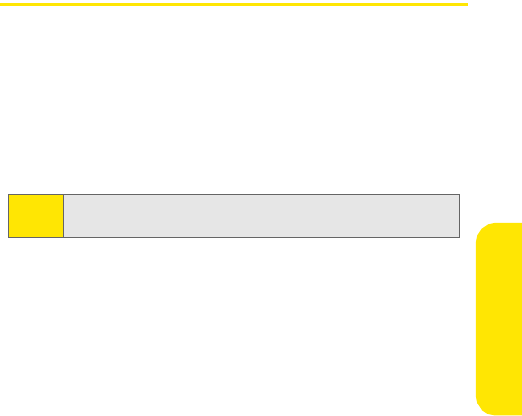
Section 2C: Setting Your Phone’s Security 92
Your Phone’s Security
Accessing Your Security Menu
All of your phone’s security settings are available through the
Security menu. You must enter your lock code to view the
Security menu.
To access the Security menu:
1. Press O > Settings > Security.
2. Enter your four-digit lock code.
Tip: If you can’t recall your lock code, call Sprint Customer Service
at 1-888-211-4PCS (4727).
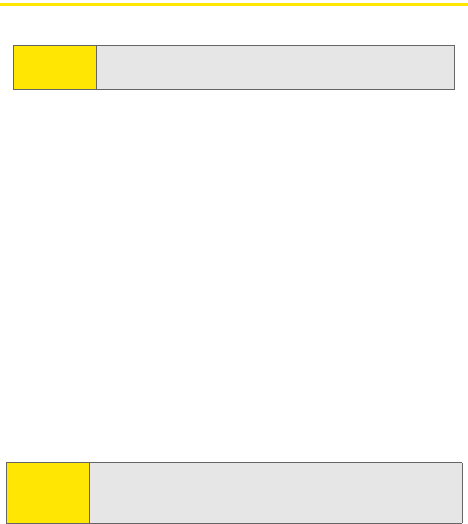
93 Section 2C: Setting Your Phone’s Security
SIM Card Security
You can use your SIM card to store personal information. The
SIM Manager allows you to copy information from Contacts
to your SIM card. You may then choose to transfer this
information to another Sprint SIM card compatible phone.
For Sprint SIM card compatibility information, call Sprint
Customer Service at 1-888-211-4PCS (4727).
Your SIM Card’s PIN Require ment
You can protect access to your phone by using the SIM card
PIN. When you enable the SIM PIN requirement, your phone
requires the PIN to be entered each time you power up the
phone. When the SIM PIN requirement is off, your phone can
be used without entering a PIN.
You can change the PIN or turn off the requirement that it be
entered.
Turning the PIN Requirement On and Off
To turn your PIN requirement on or off:
1. Press O > Settings > Security > SIM PIN.
2. Select On or Off.
3. Enter the current SIM PIN.
Important: Except for making emergency calls, your phone does
not function without the SIM card.
Important: When the SIM PIN requirement is off, information copied
to your SIM card is not protected. Anyone can use your
phone and access your personal data.
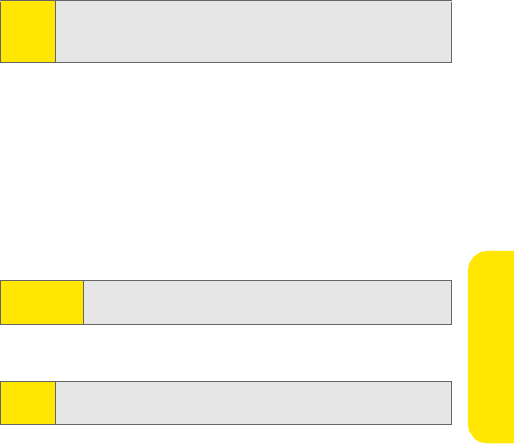
Section 2C: Setting Your Phone’s Security 94
Your Phone’s Security
4. Press OK (right softkey).
Entering the PIN
To enter your PIN:
1. Turn on your phone.
2. When the Enter SIM PIN Code screen appears, enter your
SIM PIN.
3. Press OK (right softkey). (SIM Unlocked is displayed.)
Changing the PIN
To change your PIN:
1. Press O > Settings > Security > Change Password > SIM PIN.
2. Enter the current SIM PIN.
3. Press OK (right softkey).
4. Enter the new 4- to 8-digit SIM PIN.
5. Press OK (right softkey).
6. Reenter the new SIM PIN to confirm.
7. Press OK (right softkey). (Changed: SIM PIN is displayed.)
Note: The default SIM PIN is 0000. Change your PIN to prevent
fraudulent use of the SIM card. (See“Changing the PIN” on
page 94.)
Important: If you enter your PIN incorrectly 3 times, your SIM card is
blocked. See “Unblocking the PIN” on page 95.
Note: The SIM PIN requirement must be turned on in order to
access this feature.

95 Section 2C: Setting Your Phone’s Security
Unblocking the PIN
If you enter your PIN incorrectly three times, your SIM card is
blocked. To unblock your SIM card, you must contact Sprint
Customer Service to get a PIN Unblock Code (PUK).
To unblock the PIN:
1. Press #O1.
2. At your Sprint Customer Service representative’s
request, provide the information needed to receive a
PUK code.
3. Select Unblock PIN.
4. Enter the PUK code.
5. Enter a new 4- to 8-digit SIM PIN.
6. Reenter your SIM PIN.
If you entered the codes properly, SIM Unlocked is displayed.
Note: These steps must be performed in quick succession.
Important: If you unsuccessfully enter the PUK code 10 times, your
SIM card is permanently blocked and must be replaced.
If this happens, all data is lost and you get a message to
contact Sprint Customer Service. Except for making
emergency calls, your phone does not function with a
blocked SIM card.

Section 2C: Setting Your Phone’s Security 96
Your Phone’s Security
Using Your Phone’s Lock Feature
Locking Your Phone
Locking your phone secures it from unauthorized access.
However, you can still receive incoming calls or make calls to
911, Sprint Customer Service, or special numbers.
To lock your phone:
1. Press O > Settings > Security.
2. Enter your lock code. (The Security menu is displayed.)
3. Select Lock Phone.
4. Highlight Lock Now and press O. (To set your phone to
lock the next time it is turned on, select Lock on
Power Up and press O.)
Unlocking Your Phone
To unlock your phone:
1. From standby mode, press any key.
2. Enter your lock code.
Changing the Lock Code
To change your lock code:
1. Press O > Settings > Security.
2. Enter your lock code. (The Security menu is displayed.)
3. Select Change Lock Code.
4. Enter your new lock code.
5. Re-enter your new lock code.

97 Section 2C: Setting Your Phone’s Security
Calling In Lock Mode
You can place calls to 911, Sprint Customer Service, and to
your special numbers when in lock mode.
To place an outgoing call in lock mode:
ᮣTo call an emergency number, special number, or Sprint
Customer Service, enter the phone number and press s.
Using Special Numbers
Special numbers are important numbers that you have
designated as being “always available.” You can call and
receive calls from special numbers even if your phone is
locked.
Your phone can store up to three special numbers. These
numbers are stored separately from your Contacts entries,
and the same numbers may appear in both your Contacts and
your Special Numbers.
To add or replace a special number:
1. Press O > Settings > Security > Special Numbers.
2. Select a location for your entry.
3. Enter the number and press O.
Note: You cannot assign speed dial numbers to special numbers.

Section 2C: Setting Your Phone’s Security 98
Your Phone’s Security
Limiting Use of Your Phone
Limiting use of your phone protects specific components and
functions of your phone from unauthorized use. You
determine what is off-limits to other users.
For example, you can set limitations before you loan your
phone to someone, then turn the limitations off when you
get your phone back.
You can limit access to Contacts and Sprint data services. You
can also restrict incoming and outgoing phone calls as well as
Walkie-Talkie calls.
Limiting Access to Contacts
To limit access to your Contacts:
1. Press O > Settings > Security.
2. Enter your lock code. (The Security menu is displayed.)
3. Select Limit Use > Lock Contacts.
4. Choose one of the following options and press O:
ⅢUnlock clears all limitations.
ⅢLock asks users to enter your lock code whenever
they select Contacts.
ⅢView Only lets users view your Contacts, but asks
them to enter your lock code before they edit them.
Limiting Sprint Data Services Access
To limit your Web access:
1. Press O > Settings > Security.
2. Enter your lock code. (The Security menu is displayed.)
3. Select Limit Use > Lock Vision.
4. Choose one of the following options and press O:
99 Section 2C: Setting Your Phone’s Security
ⅢUnlock clears all limitations.
ⅢLock asks users to enter your lock code whenever
they select Web or try to launch the browser.
Limiting Incoming Calls
To limit incoming calls:
1. Press O > Settings > Security.
2. Enter your lock code. (The Security menu is displayed.)
3. Select Limit Use > Restrict Incoming Calls.
4. Choose one of the following options and press O:
ⅢAll stops all incoming calls.
ⅢNone allows all calls.
ⅢExcept Contacts allows incoming calls only from
people in the Contacts list.
Limiting Outgoing Calls
To limit outgoing calls:
1. Press O > Settings > Security.
2. Enter your lock code. (The Security menu is displayed.)
3. Select Limit Use > Restrict Outgoing Calls.
4. Choose one of the following options and press O:
ⅢAll stops all outgoing calls.
ⅢNone allows all calls.
ⅢExcept Contacts allows outgoing calls only to people
in the Contacts list.
Limiting Walkie-Talkie Calls
To limit Walkie-Talkie calls:
1. Press O > Settings > Security.
2. Enter your lock code. (The Security menu is displayed.)

Section 2C: Setting Your Phone’s Security 100
Your Phone’s Security
3. Select Limit Use > Restrict Walkie-Talkie.
4. Choose one of the following options and press O:
ⅢAll stops all Walkie-Talkie calls.
ⅢNone allows all Walkie-Talkie calls.
ⅢExcept Contacts allows Walkie-Talkie calls from only
people in the Contacts list.

101 Section 2C: Setting Your Phone’s Security
Erasing Data
You can use your phone’s Security menu to erase all entries in
your Contacts or all items you have downloaded to your
phone.
To erase all downloads or Contacts entries:
1. Press O > Settings > Security > Erase My Content or
Erase Contacts.
2. If you are sure you wish to erase all your downloads or
Contacts entries, press Yes (left softkey).
Resetting Your Phone
Resetting the phone restores all the factory defaults,
including the ringers and display settings. This also erases
your Text Messages, restores the default Preset Messages,
erases your Calendar events, and resets any Alarms.
To reset your phone:
1. Press O > Settings > Security > Reset Phone.
2. If you are sure you wish to reset your phone to factory
settings, press Yes (left softkey).

Section 2C: Setting Your Phone’s Security 102
Your Phone’s Security
Security Features for Sprint Data Services
Net Guard
The Net Guard option prompts you each time you connect to
Sprint data services. When you access the browser, a screen is
displayed with two choices:
ⅷConnect to Sprint data services once. (You will be
prompted again the next time you sign in.)
ⅷAlways Auto-Connect to Sprint data services from now on
without being prompted.
You can change your Net Guard settings at any time.
To change your Net Guard settings:
ᮣPress O > Settings > PCS Vision > Netguard > On or Off.
Update Data Profile
Your data profile keeps maintains your user name and login
information and allows you to connect to Sprint data
services. It may become necessary to update the profile to
maintain peak efficiency.
To update your profile:
ᮣPress O > Settings > PCS Vision > Update Vision Profile.
Your phone will connect to the browser and update your
profile. When the update is finished, the phone returns to
standby mode.

103 Section 2D: Controlling Your Roaming Experience
Section 2D
Controlling Your Roaming Experience
In This Section
ࡗUnderstanding Roaming
ࡗSetting Your Phone’s Roam Mode
ࡗUsing Call Guard
ࡗUsing Data Roam Guard
Roaming is the ability to make or receive calls when you’re off
the Nationwide Sprint Network or the Nextel Walkie-Talkie
Network. Your new ic502 by Motorola works anywhere on
either network and allows you to roam on other networks
where we’ve implemented roaming agreements with other
carriers.
This section explains how roaming works as well as special
features that let you manage your roaming experience.
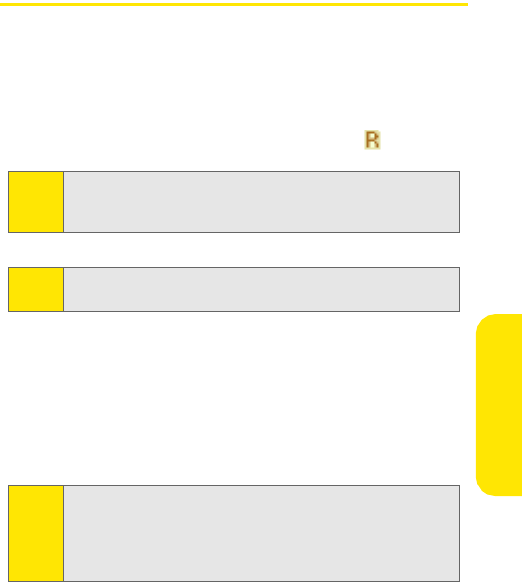
Section 2D: Controlling Your Roaming Experience 104
Roaming
Understanding Roaming
Recognizing the Roaming Icon on the Display
Screen
Your phone’s display screen always lets you know when
you’re off the Nationwide Sprint Network. Any time you are
roaming, the phone displays the roaming icon ( ).
Roaming on Other Digital Networks
When you’re roaming on digital networks, your call quality
and security will be similar to the quality you receive when
making calls on the Nationwide Sprint Network.
However, you may not be able to access certain features, such
as the browser or Messaging.
Checking for Voicemail Messages While Roaming
When you are roaming off the Nationwide Sprint Network,
you will not receive on-phone notification of new voicemail
messages. Callers can still leave messages, but you will need
Tip: Remember, when you are using your phone off the
Nationwide Sprint Network, always dial numbers using 11
digits (1 + area code + number).
Note: Unless your Sprint service plan includes roaming, you will pay
a higher per-minute rate for roaming calls.
Note: If you’re on a call when you leave the Nationwide Sprint
Network and enter an area where roaming is available, your
call is dropped. If your call is dropped in an area where you
think Sprint service is available, turn your phone off and on
again to reconnect to the Nationwide Sprint Network.
105 Section 2D: Controlling Your Roaming Experience
to periodically check your voicemail for new messages if you
are in a roaming service area for an extended period of time.
To check your voicemail while roaming:
1. Dial 1 + area code + your phone number.
2. When you hear your voicemail greeting, press *.
3. Enter your passcode at the prompt and follow the voice
prompts.
When you return to the Nationwide Sprint Network,
voicemail notification will resume as normal.

Section 2D: Controlling Your Roaming Experience 106
Roaming
Setting Your Phone’s Roam Mode
Your phone allows you to control your roaming capabilities.
By using the Roaming menu option, you can determine which
signals your phone accepts.
Set Mode
Choose from three different settings on your dual- band
phone to control your roaming experience.
To set your phone’s roam mode:
1. Press O > Settings > Roaming > Set Mode.
2. To select an option, highlight it and press O.
ⅢSprint Only allows you to access the Nationwide
Sprint Network only and prevents roaming on other
networks.
ⅢAutomatic seeks Sprint service. When Sprint service
is unavailable, the phone searches for an alternate
system.
ⅢRoaming Only forces the phone to seek a roaming
system. The previous setting (Sprint Only or
Automatic) is restored the next time the phone is
turned on.
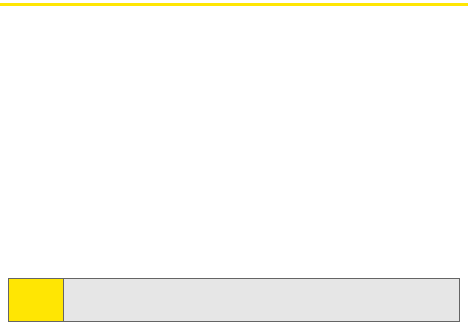
107 Section 2D: Controlling Your Roaming Experience
Using Call Guard
Your phone has two ways of alerting you when you are
roaming off the Nationwide Sprint Network: the on screen
roaming icon and Call Guard. Call Guard makes it easy to
manage your roaming charges by requiring an extra step
before you can place or answer a roaming call. (This
additional step is not required when you make or receive calls
while on the Nationwide Sprint Network.)
To turn Call Guard on or off:
1. Press O > Settings > Roaming > Call Guard.
2. Highlight On or Off and press O.
If the Call Guard feature is set to On, you need to take extra
steps to make and receive roaming calls.
To place roaming calls with Call Guard on:
1. From standby mode, dial 1 + area code + the seven-digit
number and press O.
2. Select Roam Call (1).
To answer incoming roaming calls with Call Guard on:
1. Press O. (A message is displayed, notifying you that
roaming charges apply.)
2. Select Answer (1).
Note: Speed dialing is not available when you are roaming with
Call Guard enabled.

Section 2D: Controlling Your Roaming Experience 108
Roaming
Using Data Roam Guard
Data Roam Guard makes it easy to manage roaming charges
incurred when accessing the Web through Sprint data
services. Whenever you are outside the Nationwide Sprint
Network, Data Roam Guard alerts you to this and asks you
whether you want to continue using the Web. (This
additional step is not required when you connect to the Web
while on the Nationwide Sprint Network.)
To turn Data Roam Guard on or off:
1. Press O > Settings > Roaming > Data Roam Guard.
2. Highlight Always Ask or Never Ask and press O.

109 Section 2E: Managing Call History
Section 2E
Managing Call History
In This Section
ࡗViewing Call History
ࡗPhone Call History Options
ࡗWalkie-Talkie Call History Options
ࡗErasing Call History
Call History keeps track of incoming and outgoing phone calls,
Walkie-Talkie calls, missed calls, and missed Call Alerts. This
section guides you through accessing and making the most
of your Call History.
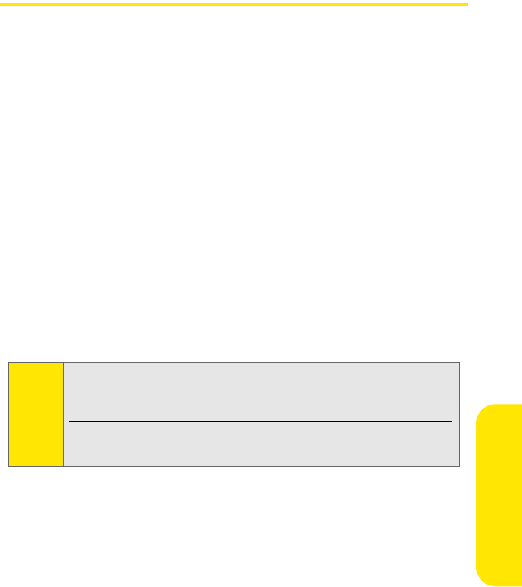
Section 2E: Managing Call History 110
Recent Calls
Viewing Call History
You’ll find the Call History feature very helpful. It is a list of
the last 20 numbers (or Contacts entries) for phone calls you
have made, received or missed.
Call History also tracks Walkie-Talkie, Group Walkie-Talkie,
Talkgroup, and Call Alerts.
Call History makes returning phone and Walkie-Talkie calls,
and responding to Call Alerts fast and easy. Call History lists
are continually updated as new numbers are added to the
beginning of the list and the oldest entries are removed from
the bottom of the list.
Your phone tracks and displays the call histories of phone
calls, Walkie-Talkie calls, and Call Alerts differently.
Viewing the Call History of Phone Calls
Each entry contains the phone number (if it is available) and
Contacts entry name (if the phone number is in your
Contacts). Duplicate calls (same number and type of call) may
only appear once on the list.
To view a Call History entry:
1. Press O > Call History.
2. Select All Calls, Missed Calls, Incoming Calls, Outgoing Calls,
or Walkie-Talkie.
Note: Call History only records calls that occur while the phone is
turned on. If a phone or Walkie-Talkie call is received while
your phone is turned off, it does not appear in Call History.
If you return a call from the voicemail menu, it does not
appear in your phone’s Outgoing Calls list.
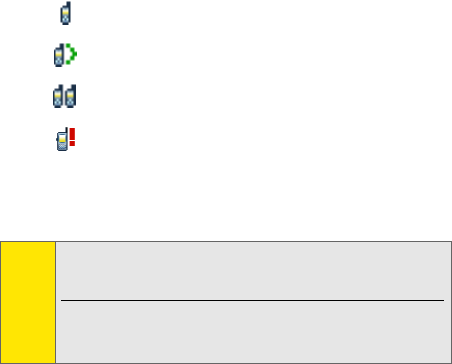
111 Section 2E: Managing Call History
Viewing Walkie-Talkie Call History
Your phone tracks Walkie-Talkie, Group Walkie-Talkie,
Talkgroup, and Call Alerts in the All Calls and Walkie-Talkie
lists. They are identified by the following icons.
Like all items in Call History lists, they remain listed until you
delete them or until they reach the end of the list.
To view Walkie-Talkie calls on the All Calls list:
ᮣPress O > Call History > All Calls. The calls are listed in
reverse chronological order, with Walkie-Talkie calls
mixed in with the phone calls.
To view Walkie-Talkie calls on the Walkie-Talkie list:
ᮣPress O > Call History > Walkie-Talkie. Your
Walkie-Talkie calls are displayed in reverse chronological
order.
Call Alerts appear with Walkie-Talkie calls. Only the most
recent missed call for a Walkie-Talkie number is shown.
Walkie-Talkie call.
Group Walkie-Talkie call.
Talkgroup call.
Call Alert.
Note: The Walkie-Talkie list contains outgoing, incoming and
missed Walkie-Talkie calls as well as sent and received Call
Alerts.
You cannot view Walkie-Talkie calls by using the Missed Calls,
Incoming Calls or Outgoing Calls options. These lists only
contain phone calls.

Section 2E: Managing Call History 112
Recent Calls
Contacts Information From Other Walkie-Talkie Users
Walkie-Talkie calls may contain contact information about
the other Walkie-Talkie users. This information can come
from Contacts, be sent to you by other Walkie-Talkie users, or
be captured by the network.
To view call details:
1. Press O > Call History > All Calls or Walkie-Talkie Calls.
2. Scroll through the calls listed and highlight the
Walkie-Talkie call you want contact information on.
3. Press O to view contact information.
Press Options (right softkey) to save the information to
Contacts or to send it to another person using Send via WLK-
TLK.

113 Section 2E: Managing Call History
Phone Call History Options
This feature displays the date and time of the call, the phone
number (if available), and the caller’s name (if the number is
already in your Contacts). By highlighting a Call History entry
and pressing Options (right softkey), you can select from the
following options:
ⅷSend Message to send a text message to the number.
ⅷSave to save the number if it is not already in your
Contacts. (See “Saving a Phone Number From Call
History” on page 114.).
ⅷDelete to delete the entry.
ⅷSelect Multiple to select multiple entries.
ⅷHide My Number to hide your Caller ID number for the
next call.
ⅷPrepend to add numbers to the beginning of the selected
number.
ⅷErase All to erase all the entries on the Call History list you
are viewing.
Making a Phone Call From Call History
To place a phone call from Call History:
1. Press O > Call History.
2. Select All Calls, Incoming Calls, Outgoing Calls, or
Missed Calls.
3. Use your navigation key to select a Call History entry
and press s.

Section 2E: Managing Call History 114
Recent Calls
Saving a Phone Number From Call History
Your phone can store up to 900 Contacts entries. Contacts
entries can store up to a total of eight numbers, and each
entry’s name can contain 24 characters. (For more
information, see “Using Contacts” on page 119.)
To save a phone number from Call History:
1. Use your navigation key to select a Call History entry
and press Options (right softkey).
2. Select Save and press O.
3. Select New Entry to create a new Contacts entry.
– or –
Select To Existing Entry and then scroll to the entry you
want to save the number to.
4. Press O.
5. Use the keypad to complete or edit the Contacts entry
and press O.
After you have saved the number, the new Contacts entry is
displayed.
115 Section 2E: Managing Call History
Prepending a Phone Number From Call History
If you need to make a call from Call History and you happen
to be outside your local area code, you can add the
appropriate prefix by prepending the number.
To prepend a phone number from Call History:
1. Select a Call History entry and press Options (right
softkey).
2. Select Prepend.
3. Enter the prefix and press s.
Press Options (right softkey) and then select Save to save the
amended number to your Contacts.

Section 2E: Managing Call History 116
Recent Calls
Walkie-Talkie Call History Options
After viewing a Walkie-Talkie call in the All Calls or Walkie-
Talkie lists, you can select from the following options:
ⅷSave to save information from a Walkie-Talkie call.
Depending on the type of Walkie-Talkie call, your phone
allows you to save the number to Contacts, as well as
other pertinent information. (See “Saving Walkie-Talkie
Information From Call History” on page 116.)
ⅷCall to place Walkie-Talkie calls from Call History lists.
ⅷDelete to delete the entry.
ⅷSelect Multiple to select multiple entries.
Making a Walkie-Talkie Call From Call History
To place a Walkie-Talkie call from Call History:
1. Press O > Call History > All Calls or Walkie-Talkie Calls.
2. Scroll through the calls listed and highlight the
Walkie-Talkie number you want to call and press O.
3. Press and hold the Walkie-Talkie button and speak.
Saving Walkie-Talkie Information From Call History
To save Walkie-Talkie information from Call History:
1. Press O > Call History > All Calls or Walkie-Talkie Calls.
2. Scroll through the calls listed and highlight the
Walkie-Talkie call you want to save to Contacts and
press O and then press Options (right softkey).
3. Select Save and press O.
Note: You cannot make Walkie-Talkie calls from Call History to
entries with insufficient information.

117 Section 2E: Managing Call History
4. Select New Entry to create a new Contacts entry
– or –
Select To Existing Entry and then scroll to the entry you
want to save the number to.
5. Use the keypad to complete or edit the Contacts entry
and press O.
After you have saved the number, the new Contacts entry is
displayed.
Tip: You can also access the Walkie-Calls from Call History by press
O > Walkie-Talkie > Walkie-Talkie Contacts > Call History.

Section 2E: Managing Call History 118
Recent Calls
Erasing Call History
You can erase individual Call History lists or all of them at one
time.
To erase Call History:
1. Press O > Call History.
2. Scroll right to select Erase Call History.
3. If you are certain you want to erase the list, press
Yes (left softkey).
– or –
Press No (right softkey) to return to the previous menu.

119 Section 2F: Using Contacts
Section 2F
Using Contacts
In This Section
ࡗAbout Contacts
ࡗFinding Contacts Entries
ࡗCreating a Contacts Entry
ࡗContacts Entries for Walkie-Talkie Groups and Talkgroups
ࡗManaging Your Contacts
ࡗDialing Sprint Services
ࡗManaging Your Contacts
Now that you know the basics that make it easier to stay in
touch with people and information, you’re ready to explore your
phone’s more advanced features. This section explains how to
use your phone’s Contacts and helps you make the most of
your time when you are trying to connect with the important
people in your life.

Section 2F: Using Contacts 120
Contacts
About Contacts
Your phone can store up to 900 phone numbers. Individual
Contacts entries can contain up to eight separate numbers,
allowing you to save someone's wireless, home, and work
phone numbers as well as their fax and Walkie-Talkie
numbers in one entry.
The total number capacity is 900, meaning that if each
Contacts entry has only one number, you have space for 900
Contacts entries.
Each number you add to an individual entry reduces the
number remaining for available entries. For example, if you
create 100 entries, each with three numbers for a total of 300
numbers, you only have space remaining for 600 entries with
one number each. You will have even fewer entries if you
assign more than one number to an entry.
Each Contacts entry may contain:
ⅷA name — A name is required if you are storing more than
one number or address to the entry; otherwise, it is
optional. Typically, this is the name of the person whose
contact information is stored in the entry.
ⅷA ringer — You can assign a ringer to each entry. This is
the sound your phone makes when you receive a call or
Call Alert from any of the numbers stored in the entry.
ⅷA number or address — Each Contacts entry must contain
a number or an address. This may be a phone number,
Walkie-Talkie number, Group Walkie-Talkie number,
Talkgroup number, or email address.
Note: You can store numbers up to 64 digits long, but every 20
digits must be separated by a pause. See “Dialing and Saving
Phone Numbers With Pauses” on page 45.

121 Section 2F: Using Contacts
ⅷA speed dial number — When you store a phone number,
it is assigned a speed dial number. You can accept the
default speed dial number or change it.
Important: Entries for Group Walkie-Talkie and Talkgroups contain
different information. See “Contacts Entries for Walkie-
Talkie Groups and Talkgroups” on page 127.

Section 2F: Using Contacts 122
Contacts
Finding Contacts Entries
There are several ways to display your Contacts entries: by
name, by speed dial number, by Category, and by Type. Follow
the steps outlined in the sections below to find entries in the
Contacts menu.
Finding Names
To find Contacts entries by name:
1. Press O > Contacts > Find All Names.
2. Scroll through the entries using your navigation key,
highlight the one you want, and press O.
3. To dial the entry’s default phone number, press s.
– or –
To display additional details about the entry, press the
navigation key left or right.
Finding Speed Dial Numbers
To find phone numbers you have assigned speed dial numbers
to:
1. Press O > Contacts > Speed Dial #s.
2. Scroll to an entry using your navigation key. Speed dial
numbers are displayed in numeric order.
3. To display the entry details, select Options
(right softkey) and then select View Contact.
– or –
To dial the entry’s default phone number, press s.
123 Section 2F: Using Contacts
Filtering Entries
To filter Contacts entries by Category or Type:
1. Press O > Contacts > Filter Names.
2. Scroll to the Category or Type you want to filter by and
press O.
3. Scroll to an entry using your navigation key.
4. To display the entry details, press O. To display
additional Contacts information, press the navigation
key left or right.
– or –
To dial the entry’s default phone number, press s.
– or –
To send a message to the entry, press Send Msg
(left softkey), and press O.
Finding Email Addresses
To find phone numbers you have stored with email addresses:
1. Press O > Contacts > Filter Names.
2. Scroll to Email and press O.
3. To display the entry details, select Options
(right softkey) and then select View Contact.
To dial the entry’s default phone number, press s.
– or –
To send a message to the entry, press Send Msg
(left softkey), and press O.
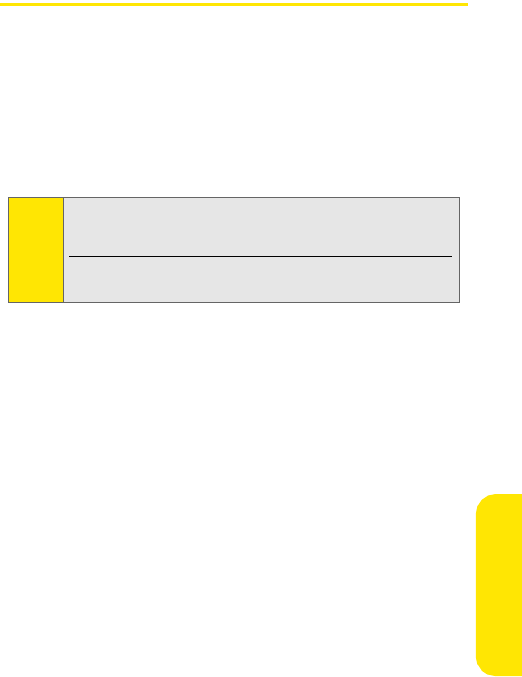
Section 2F: Using Contacts 124
Contacts
Creating a Contacts Entry
To add a new entry:
1. Press O > Contacts > Add New Entry.
2. Assign it a Contact Type – Contact, Distribution List,
Walkie-Talkie Group, or Talkgroup.
3. Follow the prompts to enter Contacts information.
4. Select Save (left softkey)
After you have saved the number, the new Contacts entry is
displayed.
Adding a Phone Number to a Contacts Entry
To add a phone number to an entry:
1. Press O > Contacts > Find All Names.
2. Scroll through the entries using your navigation key,
highlight the one you want, and press O.
3. Press Options (right softkey), select Edit, and press O.
4. Scroll to an empty Number using your navigation key.
5. Enter the new phone number.
6. Select a label for the number and press O.
Tip: You can scroll left or right to store and view other information
for the entry. You can add a picture, choose a special ringer,
store an email address, and more.
To change the speed dial number, highlight this option and
press O.

125 Section 2F: Using Contacts
Assigning Speed Dial Numbers
Your phone can store up to 900 phone numbers as speed dial
numbers. For details on how to make calls using speed dial
numbers, see “Using Speed Dialing” on page 47.
Speed dial numbers can be assigned when you add a new
Contacts entry, when you add a new phone number to an
existing entry, or when you edit an existing number.
To assign a speed dial number to an existing phone number:
1. Display a Contacts entry. (See “Finding Contacts Entries”
on page 122.)
2. Press Options (right softkey), select Edit, and press O.
3. Highlight Speed Dial below the phone number you want
to assign a speed dial number to, and press O.
4. Select an available speed dial number and press Assign
(left softkey).
Editing a Contacts Entry
To edit a Contacts entry:
1. Display a Contacts entry. (See “Finding Contacts Entries”
on page 122.)
2. Press Options (right softkey), select Edit, and press O.
3. Highlight the part of the entry you wish to edit (press
the navigation key left or right to change tabs, and up or
down to select details within each tab) and press O.
4. Add and/or edit the desired information and press O.
Note: If you attempt to assign an already in-use speed dial number
to a new phone number, a dialog appears asking if you wish
to replace the existing speed dial number. Select OK to assign
the location to the new phone number and move the old
number to the next available speed dial number.

Section 2F: Using Contacts 126
Contacts
Assigning a Ringer or Picture to an Entry
You can assign a ringer to a Contacts entry so you can identify
the caller by the ring. (See “Ringer Types” on page 74.) When
you assign a picture to entry, your phone displays it whenever
you receive calls from that person.
To assign a ringer or picture to an entry:
1. Display a Contacts entry. (See “Finding Contacts Entries”
on page 122.)
2. Press Options (right softkey), select Edit, and press O.
3. Use your navigation key to scroll right or left to the tab
with the Add Picture and Assign Ringer options.
4. Scroll down to Add Picture or Assign Ringer and press O.
5. Use your navigation key to scroll through available files.
To hear a ringer, press Listen (right softkey).
6. Highlight your desired picture or ringer and press O.
7. Press Save (left softkey) to save the entry.

127 Section 2F: Using Contacts
Contacts Entries for Walkie-Talkie Groups
and Talkgroups
Because Group Walkie-Talkie and Talkgroup calls contact
more than one person, you create their Contacts entries
differently.
Creating Group Walkie-Talkie Entries
To create a Contacts entry for a Walkie-Talkie Group:
1. Press O > Contacts > Add New Entry.
2. Highlight Walkie-Talkie Group, and then press Select
(left softkey).
3. Enter a name for the new Group. Each entry’s name can
contain 24 characters.
4. Choose a category for the entry.
5. Highlight Add Members and select the Walkie-Talkie
members of this Group. A checkmark appears next to
each selected member. (See “Adding Group Members”
below.)
6. Press O.
Creating Talkgroup Entries
To create a Contacts entry for a Talkgroup:
1. Press O > Contacts > Add New Entry.
2. Highlight Talkgroup, and then press Select
(left softkey).
3. Enter a name for the Talkgroup. Each entry’s name can
contain 24 characters.
4. Enter the Talkgroup number.
5. Choose a category for the entry.

Section 2F: Using Contacts 128
Contacts
6. Press O.
Adding Group Members
You can add Group members that have Group Walkie-Talkie
compatible phones to a Group by selecting them from
Contacts, Call History lists, or by manually entering the
Walkie-Talkie number with your keypad. You can also add all
members in an existing Group to another Group by selecting
the Group name from Contacts.
To add Group members from Contacts or Call History:
1. While creating a Group, select Add Members.
2. Use your left and right navigation keys to select Contacts
or Call History.
3. Scroll to the members you want to add and press O. A
check mark appears next to each selected member.
To add Group members using the keypad:
1. While creating a Group, select Add Members.
2. Enter the Walkie-Talkie number using the keypad. (See
“Dialing Walkie-Talkie Numbers” on page 49.)
3. Press O.
To remove a member from a Group:
1. Press O > Contacts > Filter Names > Walkie-Talkie Group.
2. Scroll to the Group you want to delete the member
from.
3. Press Options (right softkey), select Edit, and press O.
4. Select Edit Members and select the Walkie-Talkie
members you want to delete. The checkmark next to
each selected member clears.
5. Press Done (left softkey).
129 Section 2F: Using Contacts
To delete a Group from Contacts:
1. Press O > Contacts > Filter Names > Walkie-Talkie Group.
2. Scroll to the Group you want to delete.
3. Press Options (right softkey) and then select Delete.
Editing Walkie-Talkie Group Entries
You can edit Group entries by their name, category or
membership.
To edit Group entries:
1. Press O > Contacts > Filter Names > Walkie-Talkie Group.
2. Scroll to the Group you want to delete the member
from.
3. Press Options (right softkey), select Edit, and press O.
4. Highlight the part of the entry you wish to edit and
make your changes.
5. Press Done (left softkey).

Section 2F: Using Contacts 130
Contacts
Managing Your Contacts
Organize your Contacts entries by assigning them to
categories. Your phone has some categories already defined –
Family, Friends, and Business. You can also create your own
categories.
To view your categories:
1. Press O > Contacts > Manage Contacts > View Categories.
2. Scroll the list of categories.
To create your own custom category:
1. Press O > Contacts > Manage Contacts > Add Category.
2. Enter the name of the new category.
3. Highlight Add Members and scroll to the members you
want to add to this category. A checkmark appears next
to each selected member.
4. To assign a special ringer to this category, highlight
Assign, scroll to the ringer you want, and select Save
(left softkey).
5. Press O.
Erasing All Contacts
To erase all the Contacts entries stored in your phone:
1. Press O > Contacts > Manage Contacts > Delete All
Contacts.
2. Select Yes (left softkey).
Viewing Memory Status
To view how much memory you currently have available for new
entries:
ᮣPress O > Contacts > Manage Contacts > Memory Status.
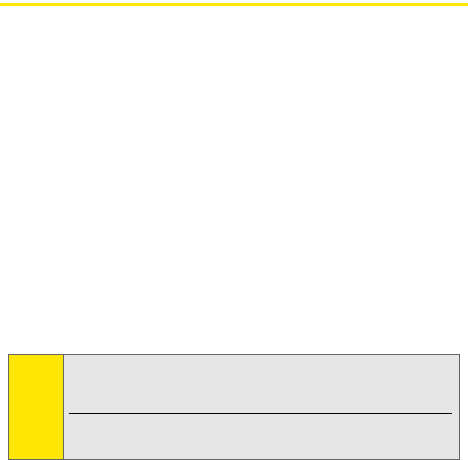
131 Section 2F: Using Contacts
Using Your SIM Manager
When you create a new entry in Contacts, that information is
stored on your phone, not on your SIM card. If you decide to
save it on your SIM card, you must use the SIM Manager to
copy it there.
The SIM Manager also allows you to copy from the SIM card
to your phone as well as manage your Contacts information.
The SIM Manager can store up to 600 Contacts entries.
Viewing SIM Manager Contacts
To view entries stored in the SIM Manager:
1. Press O > Contacts > SIM Manager. (Reading SIM Manager
is displayed.)
2. Scroll to view the list of entries.
Deleting Entries from SIM Manager
To delete entries stored in the SIM Manager:
1. Press O > Contacts > SIM Manager. (Reading SIM Manager
is displayed.)
2. Highlight the entries you want to delete.
3. Select Options (right softkey) and then select Delete.
4. On the Delete screen, select Ye s (left softkey). (Deleting,
followed by Delete Complete or Incomplete is displayed.)
Note: To view details, highlight the Contacts entry and press O. If
you select a Walkie-Talkie Group or Talkgroup, press O again
to view its members.
You cannot dial numbers directly from SIM Manager. You can
do so from Contacts or the Call History lists.

Section 2F: Using Contacts 132
Contacts
Copying Contacts Entries – Phone to SIM Card
To copy entries from your phone to your SIM card:
1. Press O > Contacts > SIM Manager > Copy to SIM. (Reading
SIM Manager is displayed.)
2. On the Select Contacts screen, select each entry you
want to copy.
3. Select Copy (left softkey). (Copying, followed by Copy
Complete or Incomplete is displayed.)
Copying Contacts Entries – SIM Card to Phone
To copy entries from a SIM card to your phone:
1. Press O > Contacts > SIM Manager > Copy to Phone.
(Reading SIM Manager is displayed.)
2. On the Select Contacts screen, select each contact you
want to copy.
3. Select Copy (left softkey). (Copying, followed by Copy
Complete or Incomplete is displayed.)
While Copying...
While attempting to copy information with your SIM
Manager, you may encounter circumstances that prevent
your from completing the task. Usually, your phone displays a
self-explanatory message that explains what happened and
displays screen prompts showing what to do next.
Note: Selecting a Group copies all its members. If you select an
entry that is already on your SIM card, it is not copied.
Note: Selecting a Group copies all its members. If you select a entry
that is already on your SIM card, it is not copied.
133 Section 2F: Using Contacts
When you copy a Contacts entry from your phone to your SIM
card, the entry may display differently. In addition, some
information may be omitted completely. Be sure to verify the
accuracy of any information you copy.
Managing Your Contacts With SIM Manager
Your SIM Manager offers many ways to find, view, and copy
information.
Copying All Entries
To copy all the entries on a SIM card or phone:
1. Press O > Contacts > SIM Manager > Copy to SIM or Copy
to Phone. (Reading SIM Manager is displayed.)
2. Select Options (right softkey) and then select Copy All.
(Copying, followed by Copy Complete or Incomplete is
displayed.)
Sorting the Contacts Entries
To sort your Contacts entries:
1. Press O > Contacts > SIM Manager > Copy to SIM or Copy
to Phone. (Reading SIM Manager is displayed.)
2. Do one of the following:
ⅢTo sort the list of entries alphabetically, select
Options > Sort > Alphabetically.
ⅢTo sort the list of entries by number, select
Options > Sort >Numerically.
Searching for Contacts
To search your Contacts entries:
1. Press O > Contacts > SIM Manager > Copy to SIM or Copy
to Phone. (Reading SIM Manager is displayed.)
2. Sort the list of entries alphabetically by selecting
Options > Sort > Alphabetically.

Section 2F: Using Contacts 134
Contacts
3. Enter the first letter of the contact you want to find.
Editing a SIM Contacts Entry
To edit a Contacts entry on your SIM Manager:
1. Press O > Contacts > SIM Manager. (Reading SIM Manager
is displayed.)
2. On the Select Contacts screen, select the entry you want
to edit.
3. Select Edit (right softkey).
4. Make the changes you want.
5. Select Done (left softkey).

135 Section 2F: Using Contacts
Dialing Sprint Services
Your Contacts contains entries for various Sprint services.
To dial a service from your Contacts:
1. Press O > Contacts > Services.
2. Select Customer Solutions, Dir. Assistance, Account Info., or
Sprint Operator.
To dial a service from standby mode using your keypad:
1. Dial the appropriate service number:
ⅢCustomer Solutions – *2.
ⅢSprint 411 – 411.
ⅢAccount Info. – *4.
ⅢSprint Operator – 0.
2. Press s to place the call.

Section 2G: Using the Phone’s Calendar and Tools 136
Calendar & Tools
Section 2G
Using the Phone’s Calendar and Tools
In This Section
ࡗUsing Your Phone’s Calendar
ࡗUsing Your Phone’s Tools
Your phone is equipped with several personal information
management features that help you manage your busy lifestyle.
This section shows you how to use these features to turn your
phone into a time management planner that helps you keep
up with your appointments, schedules, and commitments. It
takes productivity to a whole new level.
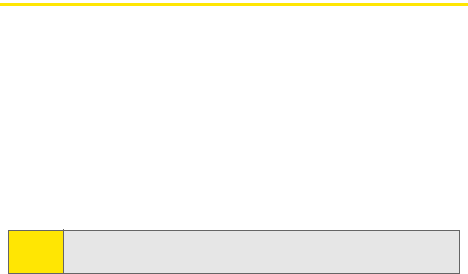
137 Section 2G: Using the Phone’s Calendar and Tools
Using Your Phone’s Calendar
Adding an Event to the Calendar
Your Calendar helps organize your time and reminds you of
important events.
To add an event:
1. Press O > Tools > Calendar.
2. Using your navigation key, highlight the day to which
you would like to add an event.
3. Press Options (right softkey), select Add, and then press
O.
4. Enter the event title and press O.
5. Select a time for the event by highlighting the time field
and pressing O.
ⅢUsing your keypad and/or navigation key, set the
start and end time for the event and press O.
6. Select a repeating status for the event by highlighting
the recurrence field and pressing O.
ⅢHighlight Once, Daily, Mon - Fri, Weekly, Monthly, or
Yea rl y and press O.
7. Select an alarm time for the event by highlighting the
reminder field and pressing O.
ⅢHighlight On Time, 5MinutesBefore, 10 Minutes
Before, 15 Minutes Before, 1 Hour Before, 1 Day Before,
or 2 Days Before and press O.
8. Select a ringer type for the alarm by highlighting the
alarm field and pressing O.
Tip: To quickly go to a date, press Options (right softkey) and select
Go To Date.

Section 2G: Using the Phone’s Calendar and Tools 138
Calendar & Tools
ⅢScroll to a ringer and press O.
9. Press Save (left softkey) to save the event.
Event Alerts
There are several ways your phone alerts you to scheduled
events:
ⅷBy playing the assigned ringer type.
ⅷBy illuminating the backlight.
ⅷBy flashing the external display.
Event Alert Menu
When your phone is turned on and you have an event alarm
scheduled, your phone alerts you and displays the event
summary. To silence the alarm and reset the schedule,
press O.
To view additional options, press the appropriate softkey.
ⅷDetails (left softkey) displays the event detail screen.
ⅷSnooze (right softkey) silences the alarm and schedules it
to replay again in 10 minutes.
Viewing Events
To view your scheduled events:
1. Press O > Tools > Calendar.
2. Using your navigation key, highlight the day for which
you would like to view events and press O. (If you have
events scheduled for the selected day, they are listed in
chronological order.)
Tip: To change your default event ringer type, from the standby
screen press O > Settings > Sounds > Ringer Type > Calendar
and select a ringer.

139 Section 2G: Using the Phone’s Calendar and Tools
3. To display the details of an event listed in the schedule,
highlight it and press O.
Changing to Weekly View
To go to the Weekly Calendar view:
1. Press O > Tools > Calendar.
2. Press Options (right softkey).
3. Select Weekly.
Going to Today’s Date
To go to today’s date:
1. Press O > Tools > Calendar.
2. Press Options (right softkey).
3. Select Go To Today.
Erasing an Event
To erase a day’s scheduled events:
1. Press O > Tools > Calendar.
2. Using your navigation key, highlight the day for the
event and press O.
3. Highlight the event, press Options (right softkey), and
select Erase.
4. Select Yes (left softkey) or No (right softkey).
Tip: In the calendar view, days with events scheduled are purple.

Section 2G: Using the Phone’s Calendar and Tools 140
Calendar & Tools
Erasing Old Events
To delete events scheduled before a specific time and date:
1. Press O > Tools > Calendar > Options > Erase Old.
2. Select the option to erase events older than Older than 1
day, Older than 1 Week, Older than 1 Month, or Older than
1 Year.
Erasing All Events
To delete all scheduled events:
ᮣPress O > Calendar > Options > Erase All. (A dialog is
displayed informing you how many events will be
erased.)

141 Section 2G: Using the Phone’s Calendar and Tools
Using Your Phone’s Tools
In addition to helping you be more efficient and organized,
your phone offers useful and entertaining tools.
Using the Alarm Clock
Your phone comes with a built-in alarm clock with multiple
alarm capabilities.
To use the alarm clock:
1. Press O > Tools > Alarm Clock.
2. Select Alarm 1, Alarm 2, Alarm 3, Alarm 4, or Alarm 5 and
press O.
3. Select a time for the alarm by highlighting the time field
and pressing O.
ⅢUsing your keypad and/or navigation key, set the
start and end time for the event and press O.
4. Select a repeating status for the event by highlighting
the recurrence field and pressing O.
ⅢHighlight Once, Daily, Mon - Fri, or Weekends, and
then press O.
5. Select a ringer type for the alarm by highlighting the
alarm field and pressing O.
ⅢScroll to a ringer and press O.
6. Press Save (left softkey) to save the event.
Tip: To change your default alarm ringer type from the standby
screen press O > Settings > Sounds > Ringer Type > Alarm and
select a ringer.

Section 2G: Using the Phone’s Calendar and Tools 142
Calendar & Tools
Using the Calculator
Your phone comes with a built-in calculator.
To use the calculator:
1. Press O > Tools > Calculator.
2. Enter numbers using your keypad.
ⅢPress the navigation key to enter operators (+ ÷ - ×)
as indicated in the display.
ⅢPress * to enter a decimal.
ⅢPress # to make the number to the left of the
cursor positive or negative.
ⅢPress Operator (right softkey) to enter parentheses
or exponents.
3. Press O to compute.

Section 2H: Managing Voice Records 144
Voice Services
Voice Records
You can record brief records to remind yourself of important
events, phone numbers, or grocery list items.
Recording Voice Records
To create a new Voice Record:
1. Press O > Voice Records.
2. Press Record (left softkey) and begin recording after the
prompt.
3. To end the recording, press Stop (left softkey).
If you want to review the recording, press Ye s (left softkey).
To record a conversation during a phone call:
1. Make or answer the call.
2. Press Options (right softkey), select Record Recipient, and
press O.
3. Press Record (left softkey).
ⅢA beep occurs every 10 seconds during the
recording. The maximum recording time is 30
seconds.
4. To end the recording, press Stop (left softkey).

145 Section 2H: Managing Voice Records
Playing Voice Records
To play the Voice Records you have recorded:
1. Press O > Voice Records.
2. Press Options (right softkey), select Voice Records List,
and press O.
3. Use the navigation key to scroll to a recording.
4. Press Listen (left softkey) to play the Voice Record.
Changing Voice Record Settings
To change your Voice Record maximum length and tone:
1. Press O > Voice Records.
2. Press Options (right softkey), select Record Settings, and
press O.
3. Scroll to Record Duration, and press O.
ⅢSelect a maximum length of 10 Seconds, 30 Seconds,
or 60 Seconds and press O.
4. Scroll to 10 Second Tone and press O. This tone beeps
every 10 seconds during your Voice Record.
ⅢSelect Enable or Disable and press O.
Tip: To make finding Voice Records easier, select
Sort By (Name, Date, Size, or Type).
You can choose Play All (to play all the Voice Records) or
Select Multiple (to play a several Voice Records
consecutively).

Section 2H: Managing Voice Records 146
Voice Services
Using Other Voice Record Options
You can also rename your Voice Records, use them as ringers,
or delete them.
To rename, set as ringer or delete a Voice Record:
1. Press O > Voice Records.
2. Press Options (right softkey), select Voice Records List,
and press O.
3. Use the navigation key to scroll to the recording you
want to work with.
4. Press Options (right softkey) and then choose Rename,
Delete, or Set As (ringer).
5. Follow the prompts to complete your task.

147
Section 3
Service Features

Section 3A: Service Features: The Basics 148
Service Features
Section 3A
Service Features: The Basics
In This Section
ࡗUsing Voicemail
ࡗUsing SMS Text Messaging
ࡗUsing Caller ID
ࡗResponding to Call Waiting
ࡗMaking a Three-Way Call
ࡗUsing Call Forwarding
Now that you’ve mastered your phone’s fundamentals,
it’s time to explore the calling features that enhance your
service. This section outlines your basic service features.
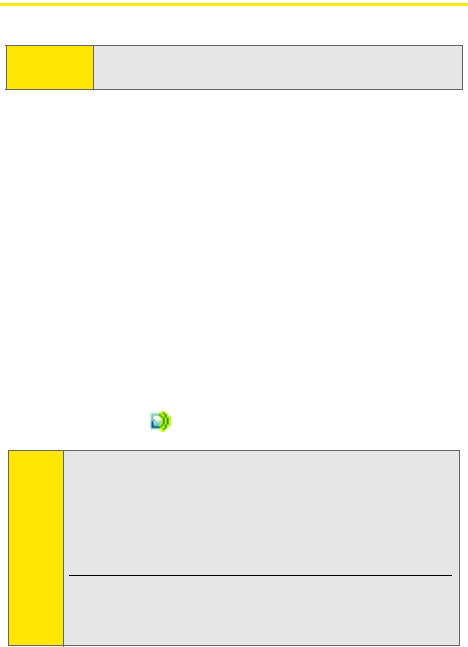
149 Section 3A: Service Features: The Basics
Using Voicemail
Setting Up Your Voicemail
All unanswered phone calls to your phone are automatically
transferred to your voicemail, even if your phone is in use or
turned off. Therefore, you want to set up your Sprint
Voicemail and personal greeting as soon as your phone is
activated. If you need to set up your voicemail, see “Setting
Up Your Voicemail” on page 5.
Voicemail Notification
There are several ways your phone alerts you to a new
message:
ⅷBy displaying a message on the screen.
ⅷBy sounding the assigned ringer type.
ⅷBy displaying at the top of your screen.
Important: Walkie-Talkie, Group Walkie-Talkie, Talkgroup, and Direct
Talk calls do not get forwarded to voicemail.
Note: When you are roaming off the Nationwide Sprint Network,
you may not receive notification of new voicemail messages.
It is recommended that you periodically check your voicemail
by dialing 1 + area code + your phone number. When your
voicemail answers, press (*) and enter your passcode. You will
be charged roaming rates when accessing voicemail while
roaming off the Nationwide Sprint Network.
Your phone accepts messages even when it is turned off.
However, you are only notified of new messages when your
phone is turned on and you are in a Sprint service area.

Section 3A: Service Features: The Basics 150
Service Features
Sending an Incoming Call to Voicemail
To send an incoming call directly to voicemail:
ᮣPress ..
Retrieving Your Voicemail Messages
You can review your messages directly from your phone or
from any other touch-tone phone. To dial from your phone,
you can either speed dial your voicemail or use the menu
keys.
Using One-Touch Message Access
ᮣPress and hold 1. (Your phone dials your voicemail
box.)
Using the Navigation Keys to Access Voicemail
ᮣPress O > Messaging > Voicemail > Call Voicemail.
Using a Phone Other Than Your Phone to Access Messages
1. Dial your phone number.
2. When your voicemail answers, press *.
3. Enter your passcode.
Note: You are charged for airtime minutes when you are accessing
your voicemail from your phone.
Tip: When you call into voicemail, you first hear the header
information (date, time, and sender information) for the
message. To skip directly to the message, press 4 during the
header.
151 Section 3A: Service Features: The Basics
Voicemail Button Guide
Here’s a quick guide to your keypad functions while listening
to voicemail messages. For further details and menu options,
see “Voicemail Menu Key” on page 154.
123
Date/Time Send Reply Advance
456
Replay Rewind Forward
789
Erase Call Back Save
*0#
Cancel Help Skip
Voicemail Options
Your phone offers several options for organizing and
accessing your voicemail.
Using Expert Mode
Using the Expert Mode setting for your personal voicemail
box helps you navigate through the voicemail system more
quickly by shortening the voice prompts you hear at each
level.
To turn Expert Mode on or off:
1. Press and hold 1 to access your voicemail. (If your
voicemail box contains any new or saved messages,
press * to access the main voicemail menu.)
2. Press 3 to change your Personal Options, following the
system prompts.
3. Press 4 for Expert Mode.
4. Press 1 to turn Expert Mode on or off.

Section 3A: Service Features: The Basics 152
Service Features
Setting Up Group Distribution Lists
Create up to 20 separate group lists, each with up to 20
customers.
1. Press and hold 1 to access your voicemail. (If your
voicemail box contains any new or saved messages,
press * to access the main voicemail menu.)
2. Press 3 to change your Personal Options, following the
system prompts.
3. Press 2 for Administrative Options.
4. Press 5 for Group Lists.
5. Follow the voice prompts to create, edit, rename, or
delete group lists.
Sprint Callback
Return a call after listening to a message without
disconnecting from voicemail.
ᮣPress 8 after listening to a message. (Once the call is
complete, you’re returned to the voicemail main menu.)
Voicemail-to-Voicemail Message
Record and send a voice message to other Sprint Voicemail
users.
1. From the main voicemail menu, press 2 to send a
message.
2. Follow the voice prompts to enter the phone number.
3. Follow the voice prompts to record and send your voice
message.
153 Section 3A: Service Features: The Basics
Voicemail-to-Voicemail Message Reply
Reply to a voice message received from any other Sprint
Voicemail user.
1. After listening to a voice message, press 2.
2. Follow the voice prompts to record and send your reply.
Voicemail-to-Voicemail Message Forwarding
Forward a voice message, except those marked “Private,” to
other Sprint Voicemail users.
1. After listening to a message, press 6.
2. Follow the voice prompts to enter the phone number.
3. Follow the voice prompts to record your introduction
and forward the voice message.
Voicemail-to-Voicemail Receipt Request
Receive confirmation that your voice message has been
listened to when you send, forward, or reply to other
Sprint users.
1. After you have recorded a message, press 1 to indicate
you are satisfied with the message you recorded.
2. Press 4 to mark receipt requested.
3. Press 1 to send your voicemail message.
Extended Absence Greeting
When your phone is turned off or you are off the Nationwide
Sprint Network for an extended period, this greeting can be
played instead of your normal personal greeting.
1. From the main voicemail menu, press 3 for Personal
Options.
2. Press 3 for Greetings.
3. Press 3 to record an Extended Absence Greeting.

Section 3A: Service Features: The Basics 154
Service Features
Clearing the Message Icon
Your phone may temporarily continue to display the message
icon after you have checked your voice and text messages.
To clear the icon from the display screen:
1. Press O > Messaging > Voicemail > Clear Icon.
Voicemail Menu Key
Following the prompts on the voicemail system, you can use
your keypad to navigate through the voicemail menu. The
following list outlines your phone’s voicemail menu structure.
1 Listen
1 Envelope Information
2 Reply
3 Advance 8 Seconds
4 Replay
5 Rewind
6 Forward Message
7 Erase
8 Callback
9 Save
0 Options
2 Send a Message
3 Personal Options
1 Notification Options
1 Phone Notification
2 Numeric Paging to a Sprint Phone
* Return to Personal Options Menu
2 Administrative Options
1 Skip passcode
2 Autoplay
155 Section 3A: Service Features: The Basics
3 Message Date & Time On/Off
4 Change Passcode
5 Group Distribution List
6 Return to Personal Options Menu
3 Greetings
1 Personal Greetings
2 Name Announcement
3 Extended Absence Greeting
4 Return to Personal Options Menu
4 Expert Mode (On/Off)
9 Place a Call
* Disconnect
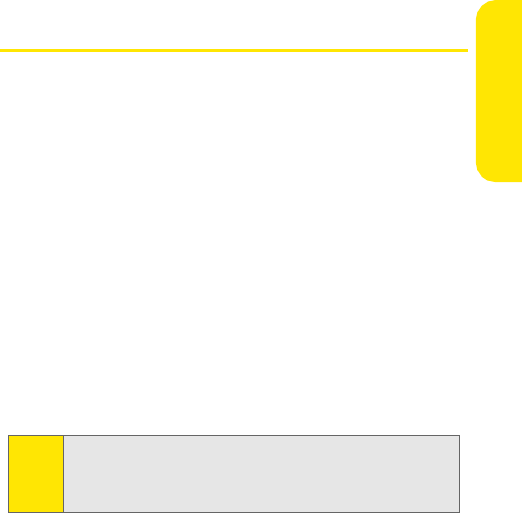
Section 3A: Service Features: The Basics 156
Service Features
Using SMS Text Messaging
With SMS Text Messaging, you can use other people’s
wireless phone numbers to send instant text messages from
your phone to their messaging-ready phones – and they can
send messages to you. When you receive a new message, it is
automatically displayed on your phone’s screen.
In addition, SMS Text Messaging includes a variety of preset
messages, such as “I’m running late, I’m on my way,” that
make composing messages fast and easy. You can also
customize your own preset messages (up to 160 characters)
from your phone.
Composing SMS Text Messages
To compose an SMS Text message:
1. Press O > Messaging > Send Message.
2. Enter the recipient’s phone number and press O.
3. Scroll to Message and compose your message text and
press O.
ⅢTo type a message, use your keypad to enter your
message. Use the right softkey to select a character
input mode.
ⅢTo use a preset message, press Options (right
softkey), select Insert Preset Msg, highlight your
desired message, and press O.
4. To ask the recipient to call you back, select the Callback
check box and enter the number you can be reached at.
Tip: To add another recipient, press Options (right softkey) and
select New Recipient. You can also press Options (right softkey)
and select Insert Contact to select a recipient from your
Contacts.
157 Section 3A: Service Features: The Basics
5. If your message is urgent, select the Urgent check box.
6. Review your message and press Send (left softkey).
Accessing SMS Text Messages
To read an SMS Text message:
ᮣWhen you receive a text message, it automatically
appears on your phone’s main display screen. Use your
navigation key to scroll down and view the entire
message. If the message is urgent, the message icon
blinks in your display.
To reply to an SMS Text message:
1. While the message is open, select Reply (left softkey).
2. Compose your reply or use the preset messages.
ⅢIf you want to include the original message in your
reply, select Yes (left softkey).
ⅢTo type a message, use your keypad to enter your
message. Use the right softkey to select a character
input mode.
ⅢTo use a preset message, press Options (right
softkey), select Insert Message (8), highlight your
desired message, and press O.
3. To ask the recipient to call you back, select the Callback
check box and enter the number you can be reached at.
4. If your message is urgent, select the Urgent check box.
5. Review your message and press Send (left softkey).

Section 3A: Service Features: The Basics 158
Service Features
Using Preset Messages
Preset messages make composing text messages even easier
by allowing you to enter preset messages, such as “Meet me
at,” “Lets get lunch,” or a customized preset message of your
own.
To add and/or edit preset messages:
1. Press O > Messaging > Text Messaging > Preset Messages.
2. Select New Preset Msg and press O.
– or –
Scroll to a message to edit, press Options (right softkey),
select Edit, and press O.
3. Enter your new message or changes, and press Save (left
softkey).

159 Section 3A: Service Features: The Basics
Using Caller ID
Caller ID allows people to identify a caller before answering
the phone by displaying the number of the incoming call. If
you do not want your number displayed when you make a
call, just follow these easy steps.
To block your phone number from being displayed for a specific
outgoing call:
1. Press *67
.
2. Enter the number you want to call.
3. Press s.
To permanently block your number, call Sprint Customer Service.
Responding to Call Waiting
When you’re on a call, Call Waiting alerts you to incoming
phone calls. Your display screen alerts you that another call is
coming in and shows the caller’s number (if it is available).
To respond to an incoming call while you’re on a call:
ᮣPress s. (This puts the first caller on hold and answers
the second call.)
To switch back to the first caller:
ᮣPress s again.
Tip: For those calls where you don’t want to be interrupted, you
can temporarily disable Call Waiting by pressing *70 before
placing your call. Call Waiting is automatically reactivated
once you end the call.
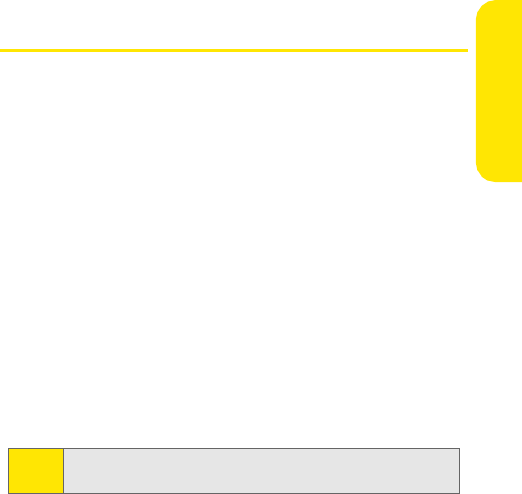
Section 3A: Service Features: The Basics 160
Service Features
Making a Three-Way Call
With Three-Way Calling, you can talk to two people at the
same time. When using this feature, the normal airtime rates
will be charged for each of the two calls.
To make a Three-Way Call:
1. Enter a number you wish to call and press s.
2. Once you have established the connection, press
Options (right softkey), select 3-Way Call, and press O.
3. When you hear a dial tone, enter the second number
you wish to call and press s.
4. When you’re connected to the second party, press s
again to begin your three-way call.
If one of the people you called hangs up during your call, you
and the remaining caller stay connected. If you initiated the
call and are the first to hang up, all other callers are
disconnected.
Note: Call Waiting and Three-Way Calling are not available while
roaming off the Sprint Nationwide Network.
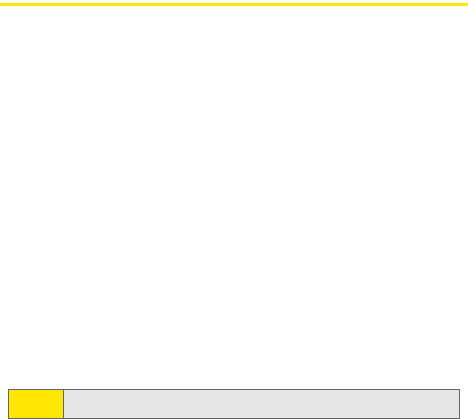
161 Section 3A: Service Features: The Basics
Using Call Forwarding
Call Forwarding lets you forward all your incoming calls to
another phone number – even when your phone is turned off.
You can continue to make calls from your phone when Call
Forwarding is activated.
To activate Call Forwarding:
1. Press *72.
2. Enter the area code and phone number to which your
future calls should be forwarded.
3. Press s. (You see a message and hear a tone to
confirm the activation of Call Forwarding.)
To deactivate Call Forwarding:
1. Press *720
.
2. Press s. (You see a message and hear a tone to
confirm the deactivation.)
Note: You are charged a higher rate for calls you have forwarded.

Section 3B: Sprint Data Services 162
Sprint Data Services
Section 3B
Sprint Data Services
In This Section
ࡗSprint Data Services Applications
ࡗGetting Started
ࡗDownloading Premium Services Content
ࡗExploring the Web
ࡗSprint Data Services FAQs
Sprint data services offers easy and amazing data services you will
really use. These features – messaging, games, downloadable
ringers and screen savers, and portable Web access – let you
have fun, stay in touch, and stay informed no matter where
you go on the Nationwide Sprint Network.
This section introduces these advanced services and walks
you through the necessary steps to start taking advantage of
Sprint data services. For complete details and instructions,
see the user guide online at www.sprint.com.
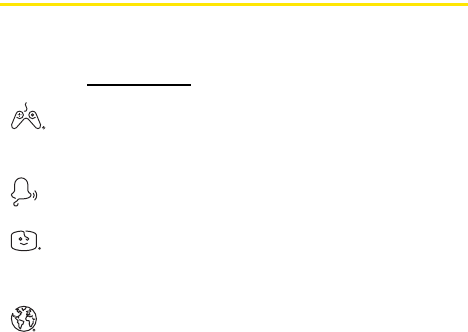
163 Section 3B: Sprint Data Services
Sprint Data Services Applications
Here is a brief list of the applications available through your
phone. For more information, please see the user guide
online at www.sprint.com.
Games – Play exciting games with full-color graphics,
sound, and vibration. Choose from over hundreds of
games to play anytime.
Ringers – Personalize your phone by downloading and
assigning different ringers to numbers in your Contacts.
Screen Savers – Download unique images to use as
screen savers, or make it easy to tell who’s calling by
assigning specific images to numbers in your Contacts.
Web – Experience full-color graphic versions of popular
Web sites from your phone.
You can download unique Java-based applications to your
ic502 by Motorola.

Section 3B: Sprint Data Services 164
Sprint Data Services
Getting Started
With your phone and Sprint service, you are ready to start
enjoying the advantages of Sprint data services. This section
helps you learn the basics of using your Sprint data services,
including managing your user name, launching a data
connection, and navigating the Web with your phone.
Your User Name
When you buy a phone and sign up for service, you're
automatically assigned a user name, which is typically based
on your name and a number, followed by “@Sprint.com.” (For
example, the third John Smith to sign up for Sprint data
services might have jsmith003@sprint.com as his user name.)
When you use Sprint data services, your user name is
submitted to identify you to the Nationwide Sprint Network.
The user name is also useful as an address, as a way to
personalize Web services, and as an online virtual identity.
Your user name is automatically programmed into your
phone. You don't have to enter it.
Finding Your User Name
If you aren't sure what your user name is, you can easily find
it online or on your phone.
To find your user name:
ⅷAt www.sprint.com. Sign on to your account using your
phone number and password. To display your user name,
click the My Personal Information menu, then click on user
name.
ⅷOn your phone. You can find your user name under the
Phone Info option in your phone's Settings menu
(O>Settings > Phone Info > My Phone #).

165 Section 3B: Sprint Data Services
Launching a Sprint Data Connection
To launch a Sprint data connection:
ᮣPress O > Web. (Your Sprint data connection starts and
the home page is displayed.)
While connecting, the following appears on the screen:
Preparing PCS Vision services.
If you had a previous Sprint data connection, the last page
you visited is displayed when you start your browser. When
this occurs, you may not see the “Connecting...” message
when you start the session. Though the browser is open, you
are not currently in an active data session—that is, no data is
being sent or received. As soon as you navigate to another
page, the active session starts and you see the “Connecting...”
message.
Net Guard
When you first connect to the Web, Net Guard confirms that
you want to connect. This feature helps you avoid accidental
connections. You can disable the Net Guard in the future by
selecting Always Auto-Connect when the Net Guard is
displayed.
To change your Net Guard settings:
ᮣPress O >Settings > PCS Vision > Net Guard.
ⅢOn to activate the Net Guard.
ⅢOff to deactivate the Net Guard.
Note: If Net Guard is enabled and displayed (see page 165), press
OK (right softkey) to continue and access the Web.
Note: When enabled, the Net Guard appears only once per session.
The Net Guard does not appear if the phone is merely re-
connecting due to a time-out.

Section 3B: Sprint Data Services 166
Sprint Data Services
Connection Status and Indicators
Your phone's display screen lets you know the current status
of your data connection through indicators which appear at
the top of the screen. The following symbols
are used:
Your data connection is active (data is being
transferred); the transmit/receive symbol blinks to
indicate data transmission. Incoming voice calls go
directly to voicemail; outgoing voice calls can be made,
but the data connection terminates.
Your data connection is dormant (no data is being sent
or received). Though not currently active, when
dormant the phone can restart an active connection
quickly; voice calls can be made and received.
Your phone is not currently able to access Sprint data
services.
If no indicator appears, your phone does not have a current
data connection. To launch a connection, see “Launching a
Sprint Data Connection” on page 165.
Navigating the Web
Navigating through menus and Web sites during a data
session is easy once you've learned a few basics. Here are
some tips for getting around:
Softkeys
During a data session, the bottom line of your phone's display
screen contains one or more softkeys. These keys are shortcut
controls for navigating around the Web, and they correspond
to the softkey buttons directly below the phone’s display
screen.

167 Section 3B: Sprint Data Services
To use softkeys:
ᮣPress the desired softkey button. (If an additional
pop-up menu appears when you press the softkey
button, select the menu items using your keypad [if
they’re numbered] or by highlighting the option and
pressing O.)
Scrolling
As with other parts of your phone's menu, you'll have to scroll
up and down to see everything on some Web sites.
To scroll line by line through Web sites:
ᮣPress the navigation key up and down.
To scroll page by page through Web sites:
ᮣPress the volume buttons on the side of the phone.
Selecting
Once you've learned how to use softkeys and scroll, you can
start navigating the Web.
To select onscreen items:
ᮣUse the navigation key to highlight the desired item,
then press the desired softkey button (or press O).
Links, which appear as underlined text, allow you to jump to
Web pages, select special functions, or even place phone calls.
Tip: Depending on which Web sites you visit, the labels on the
softkeys may change to indicate their function.
Tip: You’ll find that the left softkey is used primarily for selecting
items. This softkey is often labeled “OK.”
If the items on a page are numbered, you can use your keypad
(number keys) to select an item.
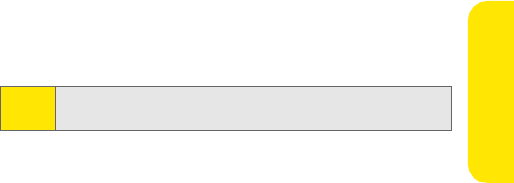
Section 3B: Sprint Data Services 168
Sprint Data Services
To select links:
ᮣHighlight the link and press the appropriate softkey.
Going Back
To go back one page:
ᮣPress c on your phone.
Going Home
To return to the home page from any other Web page:
ᮣPress and hold c.
– or –
Press the right softkey and select Home.
Note: The c is also used for deleting text (like a BACKSPACE key)
when you are entering text.

169 Section 3B: Sprint Data Services
Downloading Premium Services Content
With Sprint data services and your new phone, you have
access to a dynamic variety of Premium Service content, such
as downloadable Games, Ringers, Screen Savers, and other
applications. (Additional charges may apply.) The basic steps
required to access and download Premium Service content
are outlined below.
Accessing the Download Menus
To access the download menus:
1. Press O > My Content.
2. Select the type of file you wish to download (Games,
Ringers, Screen Savers, or Applications).
3. Press Options (right softkey).
4. Select Get New and press O.
To access the download menus from the Web browser:
1. From the home page, select Downloads.
2. Select Games, Ringers, Screen Savers, or Applications to
go to the corresponding download menu. (For more
information on navigating the Web, see “Navigating the
Web” on page 166.)

Section 3B: Sprint Data Services 170
Sprint Data Services
Selecting an Item to Download
You can search for available items to download in a number
of ways:
ⅷFeatured displays a rotating selection of featured items.
ⅷCategories allows you to narrow your search to a general
category, such as Movie/TV Themes for Ringers or College
Logos for Screen Savers. (There may be several pages of
available content in a list. Select Next 9 to view additional
items.)
ⅷSearch allows you to use your keypad to enter search
criteria to locate an item. You may enter an entire word or
title or perform a partial-word search. (For example,
entering “goo” returns “Good Ol’ Boy,” “The Good, the
Bad, and the Ugly,” and “Goofy - Club.”)
Downloading an Item
Once you’ve selected an item you wish to download,
highlight it and press O or press OK (left softkey). You sees a
summary page for the item including its title, the vendor, the
download detail, the file size, and the cost. Links allow you to
view the License Details page, which outlines the price, license
type, and length of license for the download, and the Terms of
Use page, which details the Premium Services Terms of Use
and your responsibility for payment.
To download a selected item:
1. From the information page, select Buy. (The item
downloads automatically. When the New Download
screen appears, the item has been successfully
downloaded to your phone.)
Note: If you have not previously purchased an item, you are
prompted to create your purchasing profile.

171 Section 3B: Sprint Data Services
2. Select an option to continue:
ⅢSelect Use/Run/View to assign the downloaded item
(or to start, in the case of a game or application).
Your Sprint data session ends and you are redirected
to the appropriate phone menu screen.
ⅢSelect Set as to assign a ringer or screen saver to a
phone function.
ⅢSelect Settings to configure downloaded games or
applications.
ⅢSelect Shop to browse for other items to download.
ⅢPress e to quit the browser and return to standby
mode.
Using My Content Manager
Whether you purchase your Premium Services content from
your phone or from your online account management page at
www.sprint.com, all of your purchases are stored in My Content
Manager and may be downloaded to your phone from there.
My Content Manager is a storage area on the Nationwide
Sprint Network that is assigned specifically to your account. It
allows you to store all of your Premium Service downloadable
files. The files remain in My Content Manager until their
license terms have expired – even after you have downloaded
the content to your phone. This provides you with a
convenient place to access information about your
downloaded files without having to store the information in
your phone’s memory.
To access My Content Manager:
ᮣFrom the home page, select My Content > My Content
Manager
. (A list of your purchased items is displayed.)
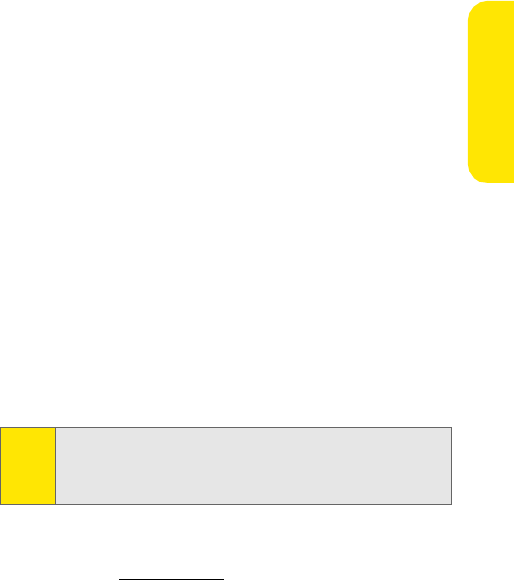
Section 3B: Sprint Data Services 172
Sprint Data Services
To download purchased content from My Content Manager:
1. From the My Content Manager display (see above),
highlight the item you wish to download and
press O. (The information page for the selected item is
displayed.)
2. Scroll to highlight Download and press O. (The item
downloads automatically. When the New Download
screen appears, the item has been successfully
downloaded to your phone.)
3. Select an option to continue:
ⅢSelect Use/Run/View to assign the downloaded item
(or to launch, in the case of a game or application).
Your Sprint data session ends and you are redirected
to the appropriate phone menu screen.
ⅢSelect Set as to assign a ringer or screen saver to a
phone function.
ⅢSelect Settings to configure downloaded games or
applications.
ⅢSelect Shop to browse for other items to download.
ⅢPress e to quit the browser and return to standby
mode.
For complete information and instructions on downloading
Games, Ringers, Screen Savers, and Applications, see the
user’s guide at www.sprint.com.
Tip: You can also access My Content Manager through the
phone’s main menu. Press O > My Content > [Games, Ringers,
Screen Savers, or Applications] > My Content Manager. The
browser starts and takes you to the corresponding content.

173 Section 3B: Sprint Data Services
Exploring the Web
With Web access on your phone, you can browse full-color
graphic versions of your favorite Web sites, making it easier
than ever to stay informed while on the go. Follow sports
scores and breaking news and weather and shop on your
phone anywhere on the Nationwide Sprint Network.
In addition to the features already covered in this section, the
Sprint home page offers access to these colorful, graphically
rich Web categories, including News, Weather, Entertainment,
Sports, Money, Travel, Shopping, and Tools, as well as useful
management options including My Account and Search. Many
sites are available under more than one menu – choose the
one that's most convenient for you.
Using the Browser Menu
Navigating the Web from your phone using the Sprint home
page is easy once you get the hang of it. For details on how to
navigate the Web, select menu items, and more, see
“Navigating the Web” on page 166
Although the Sprint home page offers a broad and
convenient array of sites and services for you to browse, not
all sites are represented, and certain functions, such as going
directly to specific Web sites, are not available. For these and
other functions, you need to use the browser menu. The
browser menu offers additional functionality to expand your
use of the Web on your phone.
Opening the Browser Menu
The browser menu may be opened anytime you have an
active data session, from any page you are viewing.

Section 3B: Sprint Data Services 174
Sprint Data Services
To open the browser menu:
ᮣPress the right softkey. (The browser menu is displayed
in a drop-down list.)
Options available under the browser menu include:
ⅷHome. Returns the browser to the home page.
ⅷForward. Returns you to a previously viewed page (after
having used c).
ⅷMark this Page. Allows you to bookmark the current site.
(See “Creating a Bookmark” on page 175.)
ⅷView Bookmarks. Allows you to access bookmarked sites
and manage your bookmarks.
ⅷSearch. Launches a search.
ⅷSend page to. Allows you to send the current URL as a text
message.
ⅷGo To URL. Allows you to navigate directly to a Web site by
entering its URL (Web site address).
ⅷView History. Keeps a list of links to your most recently
visited sites. To navigate to a site, highlight it, press O,
and then select Connect.
ⅷRefresh this page. Reloads the current Web page.
ⅷShow URL. Displays the URL of the site you're currently
viewing.
ⅷRestart Browser. Refreshes the current browser session.
ⅷAbout Browser. Displays technical information about the
browser, its version, and the encryption version, and
provides links to Certificate Information for the various
components.
ⅷPreferences. Displays additional options:
ⅢEdit Homepage URL. Allows you to select your
browser’s home page.
ⅢRevert to default homepage URL. Restores your
browser’s original home page URL setting.

175 Section 3B: Sprint Data Services
ⅢColor. Allows you to choose your browser’s
background, link, plain text, and visited link colors.
ⅢShow Image. Allows you to select whether your
browser shows images or not (images can slow
down response time).
ⅢCookies. Deletes the “cookies” that Web sites have
stored in browser memory.
ⅢTitle Tag. Allows you to display each site’s title
information (when this is turned On).
ⅢSend Referrer. Allows you to send referrer
information to sites you visit (when this is turned
On).
Creating a Bookmark
Bookmarks allow you to store the address of your favorite
Web sites for easy access at a later time.
To create a bookmark:
1. Go to the Web page you want to mark.
2. Press the right softkey to open the browser menu.
3. Select Mark this Page and press O twice to save the
bookmark.
Accessing a Bookmark
To access a bookmark:
1. Press the right softkey to open the browser menu.
2. Select View Bookmarks.
Note: Bookmarking a page does not store its contents, just the
address.
Some pages cannot be bookmarked. Whether a particular
Web page may be marked is controlled by its creator.

Section 3B: Sprint Data Services 176
Sprint Data Services
3. Scroll to highlight the bookmark you’d like to access and
press O to go to the Web site (or press the number
corresponding to the bookmark you wish to access).
Deleting a Bookmark
To delete a bookmark:
1. Press the right softkey to open the browser menu.
2. Select View Bookmarks.
3. Scroll to highlight the bookmark you’d like to delete and
press Options (right softkey).
4. Select Delete.
5. Select Yes (left softkey) to remove the bookmark.
Going to a Specific Web Site
To go to a particular Web site by entering a URL (Web site
address):
1. Press the right softkey to open the browser menu.
2. Select Go to URL.
3. Select the URL field and press O.
4. Use your keypad to enter the URL of the Web site you
wish to go to and press O.
Reloading a Web Page
To reload (refresh) a Web page:
1. Press the right softkey to open the browser menu.
2. Select Refresh this page. (The browser reloads the
current Web page.)
Note: Not all Web sites are viewable on your phone.
177 Section 3B: Sprint Data Services
Restarting the Web Browser
If the Web browser appears to be malfunctioning or stops
responding, you can usually fix the problem by simply
restarting the browser.
To restart the Web browser:
1. Press the right softkey to open the browser menu.
2. Select Restart Browser.

Section 3B: Sprint Data Services 178
Sprint Data Services
Sprint Data Services FAQs
How will I know when my phone is ready for Sprint data
services?
Your user name (for example, bsmith001@sprint.com) will be
displayed when you access O > Settings > Phone Info
>MyPhone#.
How do I sign in for the first time?
You are automatically signed in to access Sprint data services
when you turn on your phone.
How do I know when my phone is connected to Sprint data
services?
Your phone automatically connects when Sprint data service
is used or an incoming message arrives. Your phone will also
display the indicator.
Can I make calls and use data services at the same time?
You cannot use voice and data services simultaneously. If you
receive a call while Sprint data service is active, the call will be
forwarded to voicemail. You can place an outgoing call
anytime, but it will interrupt any in-progress data session.
When is my data connection active?
Your connection is active when data is being transferred.
Outgoing calls are allowed; incoming calls go directly to
voicemail. When active, the indicator flashes on your
phone’s display screen.
When is my data connection dormant?
If no data is received for 10 seconds, the connection goes
dormant. When the connection is dormant, voice calls are
allowed. (The connection may become active again quickly.) If
179 Section 3B: Sprint Data Services
no data is received for an extended period of time, the
connection will terminate.
Can I sign out of data services?
You can sign out without turning off your phone; however,
you will not be able to browse the Web or use other data
services. While signed out, you can still place or receive phone
calls, check voicemail, and use other voice services. You may
sign in again at any time. To sign out, go to
Settings > PCS Vision > Disable PCS Vision in your phone’s menu.

Section 4
Safety and Warranty
Information

181 Section 4A: Important Safety Information
Section 4A
Important Safety Information
In This Section
ࡗGeneral Precautions
ࡗSafety and General Information
ࡗHearing Aid Compatibility with Mobile Phones
ࡗBattery Tips
ࡗSpecific Absorption Rate Data
ࡗOwner’s Record
ࡗPhone Guide Proprietary Notice
ࡗInformation from the World Health Organization
ࡗProduct Registration
ࡗExport Law Assurances
ࡗWireless: The New Recyclable
ࡗSmart Practices While Driving
ࡗDeclaration of Conformity
This phone guide contains important operational and safety
information that will help you safely use your phone. Failure to
read and follow the information provided in this phone guide
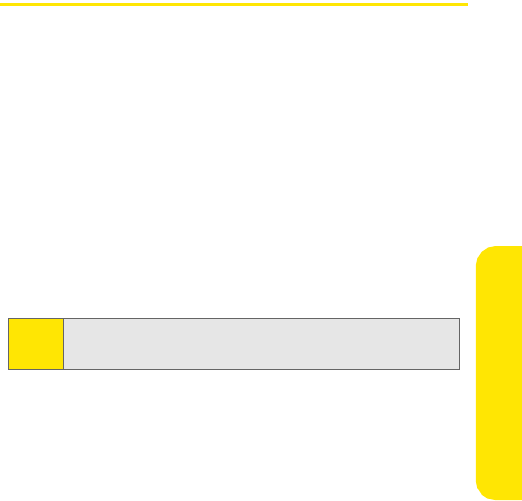
Section 4A: Important Safety Information 182
Important Safety Information
may result in serious bodily injury, death, or property
damage.
General Precautions
There are several simple guidelines to operating your phone properly and
maintaining safe, satisfactory service.
ⅷHold the phone with the antenna raised, fully-extended, and over your
shoulder.
ⅷTry not to hold, bend, or twist the phone’s antenna.
ⅷDon’t use the phone if the antenna is damaged.
ⅷSpeak directly into the mouthpiece.
ⅷAvoid exposing your phone and accessories to rain or liquid spills. If
your phone does get wet, immediately turn the power off and remove
the battery.
ⅷAlthough your phone is quite sturdy, it is a complex piece of
equipment and can be broken. Avoid dropping, hitting, bending, or
sitting on it.
ⅷAny changes or modifications to your phone not expressly approved in
this document could void your warranty for this equipment and void
your authority to operate this equipment.
Note: For the best care of your phone, only Sprint-authorized personnel
should service your phone and accessories. Failure to do so may be
dangerous and void your warranty.

183 Section 4A: Important Safety Information
Safety and General Information
This section contains important information on the safe and
efficient operation of your mobile device. Read this information
before using your mobile device.
Exposure To Radio Frequency (RF) Energy
Your mobile device contains a transmitter and receiver. When it is ON, it
receives and transmits RF energy. When you communicate with your
mobile device, the system handling your call controls the power level at
which your mobile device transmits.
Your Motorola mobile device is designed to comply with local regulatory
requirements in your country concerning exposure of human beings to RF
energy.
Operational Precautions
For optimal mobile device performance and to be sure that human
exposure to RF energy does not exceed the guidelines set forth in the
relevant standards, always follow these instructions and precautions.
External Antenna Care
If your mobile device has an external antenna, use only a Motorola-
supplied or approved replacement antenna. Use of unauthorized antennas,
modifications, or attachments could damage the mobile device and/or
may result in your device not complying with local regulatory requirements
in your country.
DO NOT hold the external antenna when the mobile device is IN USE.
Holding the external antenna affects call quality and may cause the mobile
device to operate at a higher power level than needed.
Product Operation
When placing or receiving a phone call, hold your mobile device just like
you would a landline phone.
If you wear the mobile device on your body, always place the mobile device
in a Motorola-supplied or approved clip, holder, holster, case, or body
harness. If you do not use a body-worn accessory supplied or approved by
Motorola, keep the mobile device and its antenna at least 2.5 centimeters
(1 inch) from your body when transmitting.

Section 4A: Important Safety Information 184
Important Safety Information
When using any data feature of the mobile device, with or without an
accessory cable, position the mobile device and its antenna at least 2.5
centimeters (1 inch) from your body.
Using accessories not supplied or approved by Motorola may cause your
mobile device to exceed RF energy exposure guidelines. For a list of
Motorola-supplied or approved accessories, visit our website at
www.motorola.com.
RF Energy Interference/Compatibility
Nearly every electronic device is subject to RF energy interference from
external sources if inadequately shielded, designed, or otherwise
configured for RF energy compatibility. In some circumstances your mobile
device may cause interference with other devices.
This device complies with Part 15 of the FCC Rules. Operation is subject to
the following two conditions: (1) this device may not cause harmful
interference, and (2) this device must accept any interference received,
including interference that may cause undesired operation.
Follow Instructions to Avoid Interference Problems
Turn off your mobile device in any location where posted notices instruct
you to do so. These locations include hospitals or health care facilities that
may be using equipment that is sensitive to external RF energy.
In an aircraft, turn off your mobile device whenever instructed to do so by
airline staff. If your mobile device offers an airplane mode or similar
feature, consult airline staff about using it in flight.
Pacemakers
If you have a pacemaker, consult your physician before using this device.
Persons with pacemakers should observe the following precautions:
ⅷALWAYS keep the mobile device more than 20 centimeters (8 inches)
from your pacemaker when the mobile device is turned ON.
ⅷDO NOT carry the mobile device in the breast pocket.
ⅷUse the ear opposite the pacemaker to minimize the potential for
interference.
ⅷTurn OFF the mobile device immediately if you have any reason to
suspect that interference is taking place.

185 Section 4A: Important Safety Information
Hearing Aids
Some digital mobile devices may interfere with some hearing aids. In the
event of such interference, you may want to consult your hearing aid
manufacturer or physician to discuss alternatives.
Other Medical Devices
If you use any other personal medical device, consult your physician or the
manufacturer of your device to determine if it is adequately shielded from
RF energy.
Driving Precautions
Check the laws and regulations on the use of mobile devices in the area
where you drive. Always obey them.
When using your mobile device while driving, please:
ⅷGive full attention to driving and to the road. Using a mobile device
may be distracting. Discontinue a call if you can’t concentrate on
driving.
ⅷUse handsfree operation, if available.
ⅷPull off the road and park before making or answering a call if driving
conditions so require.
Responsible driving practices can be found in the “Smart Practices While
Driving” section at the end of this guide and/or at the Motorola website:
www.motorola.com/callsmart.
Operational Warnings
Obey all posted signs when using mobile devices in public areas, such as
health care facilities or blasting areas.
Automobile Air Bags
Do not place a mobile device in the air bag deployment area.
Potentially Explosive Atmospheres
Areas with potentially explosive atmospheres are often but not always
posted, and can include fueling areas such as below decks on boats, fuel or
chemical transfer or storage facilities, or areas where the air contains
chemicals or particles, such as grain, dust, or metal powders.
When you are in such an area, turn off your mobile device, and do not
remove, install, or charge batteries. In such areas, sparks can occur and
cause an explosion or fire.

Section 4A: Important Safety Information 186
Important Safety Information
Damaged Products
If your mobile device or battery has been submerged in water, punctured,
or subjected to a severe fall, do not use it until you take it to a Motorola
Authorized Service Center. Do not attempt to dry it with an external heat
source, such as a microwave oven.
Batteries and Chargers
If jewelry, keys, beaded chains, or other conductive materials touch
exposed battery terminals, this could complete an electrical circuit (short
circuit), become very hot, and could cause damage or injury. Be careful
when handling a charged battery, particularly when placing it inside a
pocket, purse, or other container with metal objects. Use only Motorola
Original batteries and chargers.
Caution: To avoid risk of personal injury, do not dispose of your battery in
a fire.
Your battery, charger, or mobile device may contain symbols, defined as
follows:
Symbol Definition
Important safety information follows.
Do not dispose of your battery or mobile device in a
fire.
Your battery or mobile device may require recycling in
accordance with local laws. Contact your local
regulatory authorities for more information.
Do not throw your battery or mobile device in the
trash.
Your mobile device contains an internal lithium ion
battery.
Do not let your battery, charger, or mobile device get
wet.
Listening at full volume to music or voice through a
headset may damage your hearing.
032374o
032376o
032375o
032377o
032378o
Li Ion BATT
187 Section 4A: Important Safety Information
Choking Hazards
Your mobile device or its accessories may include detachable parts, which
may present a choking hazard to small children. Keep your mobile device
and its accessories away from small children.
Glass Parts
Some parts of your mobile device may be made of glass. This glass could
break if the product is dropped on a hard surface or receives a substantial
impact. If glass breaks, do not touch or attempt to remove. Stop using your
mobile device until the glass is replaced by a qualified service center.
Seizures/Blackouts
Some people may be susceptible to epileptic seizures or blackouts when
exposed to flashing lights, such as when playing video games. These may
occur even if a person has never had a previous seizure or blackout.
If you have experienced seizures or blackouts, or if you have a family
history of such occurrences, please consult with your physician before
playing video games or enabling a flashing-lights feature (if available) on
your mobile device.
Discontinue use and consult a physician if any of the following symptoms
occur: convulsion, eye or muscle twitching, loss of awareness, involuntary
movements, or disorientation. It is always a good idea to hold the screen
away from your eyes, leave the lights on in the room, take a 15-minute
break every hour, and stop use if you are very tired.
Caution About High Volume Usage
Listening at full volume to music or voice through a headset may damage
your hearing.
Repetitive Motion
When you repetitively perform actions such as pressing keys or entering
finger-written characters, you may experience occasional discomfort in
your hands, arms, shoulders, neck, or other parts of your body. If you
continue to have discomfort during or after such use, stop use and see a
physician.

Section 4A: Important Safety Information 188
Important Safety Information
Hearing Aid Compatibility with Mobile
Phones
Some Motorola phones are measured for compatibility with hearing aids. If
the box for your particular model has “Rated for Hearing Aids” printed on
it, the following explanation applies.
When some mobile phones are used near some hearing devices (hearing
aids and cochlear implants), users may detect a buzzing, humming, or
whining noise. Some hearing devices are more immune than others to this
interference noise, and phones also vary in the amount of interference
they generate.
The wireless telephone industry has developed ratings for some of their
mobile phones, to assist hearing device users in finding phones that may
be compatible with their hearing devices. Not all phones have been rated.
Phones that are rated have the rating on their box or a label on the box.
The ratings are not guarantees. Results will vary depending on the user’s
hearing device and hearing loss. If your hearing device happens to be
vulnerable to interference, you may not be able to use a rated phone
successfully. Trying out the phone with your hearing device is the best way
to evaluate it for your personal needs.
M-Ratings: Phones rated M3 or M4 meet FCC requirements and are likely
to generate less interference to hearing devices than phones that are not
labeled. M4 is the better/higher of the two ratings.
T-Ratings: Phones rated T3 or T4 meet FCC requirements and are likely to
be more usable with a hearing device’s telecoil (“T Switch” or “Telephone
Switch”) than unrated phones. T4 is the better/higher of the two ratings.
(Note that not all hearing devices have telecoils in them.)
Hearing devices may also be measured for immunity to this type of
interference. Your hearing device manufacturer or hearing health A-18
Hearing Aid Compatibility professional may help you find results for your
hearing device. The more immune your hearing aid is, the less likely you are
to experience interference noise from mobile phones.
Battery Tips
Battery life depends on the network, signal strength, temperature,
features, and accessories you use.

189 Section 4A: Important Safety Information
ⅷAlways use Motorola Original batteries and chargers. The
warranty does not cover damage caused by non-
Motorola batteries and/or chargers.
ⅷNew batteries or batteries stored for a long time may
take more time to charge.
ⅷWhen charging your battery, keep it near room temperature.
ⅷWhen storing your battery, keep it uncharged in a cool, dark, dry place.
ⅷNever expose batteries to temperatures below -10°C (14°F) or above
45°C (113°F). Always take your phone with you when you leave your
vehicle.
ⅷIt is normal for batteries to gradually wear down and require longer
charging times. If you notice a change in your battery life, it is probably
time to purchase a new battery.
Contact your local recycling center for proper battery disposal.
Warning: Never dispose of batteries in a fire because they may
explode.
Before using your phone, read the battery safety information in the “Safety
and General Information” section included in this guide.
Specific Absorption Rate Data
This model wireless phone meets the government’s requirements
for exposure to radio waves.
Your wireless phone is a radio transmitter and receiver. It is designed and
manufactured not to exceed limits for exposure to radio frequency (RF)
energy set by the Federal Communications Commission (FCC) of the U.S.
Government and by the Canadian regulatory authorities. These limits are
part of comprehensive guidelines and establish permitted levels of RF
energy for the general population. The guidelines are based on standards
that were developed by independent scientific organizations through
periodic and thorough evaluation of scientific studies. The standards
include a substantial safety margin designed to assure the safety of all
persons, regardless of age or health.
The exposure standard for wireless mobile phones employs a unit of
measurement known as the Specific Absorption Rate, or SAR. The SAR limit
set by the FCC and by the Canadian regulatory authorities is 1.6 W/kg.1
Tests for SAR are conducted using standard operating positions accepted
by the FCC and by Industry Canada with the phone transmitting at its
highest certified power level in all tested frequency bands. Although the
SAR is determined at the highest certified power level, the actual SAR level
032375o

Section 4A: Important Safety Information 190
Important Safety Information
of the phone while operating can be well below the maximum value. This
is because the phone is designed to operate at multiple power levels so as
to use only the power required to reach the network. In general, the closer
you are to a wireless base station, the lower the power output.
Before a phone model is available for sale to the public in the U.S. and
Canada, it must be tested and certified to the FCC and Industry Canada
that it does not exceed the limit established by each government for safe
exposure. The tests are performed in positions and locations (e.g., at the
ear and worn on the body) reported to the FCC and available for review by
Industry Canada. The highest SAR value for this model phone when tested
for use at the ear is 1.24 W/kg, and when worn on the body, as described in
this user guide, is 1.14 W/kg. (Body-worn measurements differ among
phone models, depending upon available accessories and regulatory
requirements).2
While there may be differences between the SAR levels of various phones
and at various positions, they all meet the governmental requirements for
safe exposure. Please note that improvements to this product model could
cause differences in the SAR value for later products; in all cases, products
are designed to be within the guidelines.
Additional information on Specific Absorption Rates (SAR) can be found on
the Cellular Telecommunications & Internet Association (CTIA) Web site:
http://www.phonefacts.net
or the Canadian Wireless Telecommunications Association (CWTA) Web
site:
http://www.cwta.ca
1. In the United States and Canada, the SAR limit for mobile phones
used by the public is 1.6 watts/kg (W/kg) averaged over one gram of
tissue. The standard incorporates a substantial margin of safety to
give additional protection for the public and to account for any
variations in measurements.
2. The SAR information includes the Motorola testing protocol,
assessment procedure, and measurement uncertainty range for this
product.

191 Section 4A: Important Safety Information
Information from the World Health
Organization
WHO Information Present scientific information does not indicate the
need for any special precautions for the use of mobile phones. If you are
concerned, you may want to limit your own or your children’s RF exposure
by limiting the length of calls or by using hands-free devices to keep
mobile phones away from your head and body.
Source: WHO Fact Sheet 193
Further information: http://www.who.int./peh-emf
Product Registration
Online Product Registration:
http://www.motorola.com/warranty
Product registration is an important step toward enjoying your new
Motorola product. Registering helps us facilitate warranty service, and
permits us to contact you should your product require an update or other
service. Registration is for U.S. residents only and is not required for
warranty coverage.
Please retain your original dated sales receipt for your records. For warranty
service of your Motorola Personal Communications Product you will need
to provide a copy of your dated sales receipt to confirm warranty status.
Thank you for choosing a Motorola product.

Section 4A: Important Safety Information 192
Important Safety Information
Owner’s Record
The model number, regulatory number and serial number are located on a
nameplate inside the battery compartment. Record the serial number in
the space provided below. This will be helpful if you need to contact us
about your phone in the future.
Model: ic502 by Motorola
Serial No.:
Phone Guide Proprietary Notice
CDMA Technology is licensed by QUALCOMM Incorporated under one or
more of the following patents:
4,901,307 5,109,390 5,267,262 5,416,797
5,506,865 5,544,196 5,657,420 5,101,501
5,267,261 5,414,796 5,504,773 5,535,239
5,600,754 5,778,338 5,228,054 5,337,338
5,710,784 5,056,109 5,568,483 5,659,569
5,490,165 5,511,073
Export Law Assurances
Export Law Assurances This product is controlled under the export
regulations of the United States of America and Canada. The Governments
of the United States of America and Canada may restrict the exportation or
re-exportation of this product to certain destinations. For further
information contact the U.S. Department of Commerce or the Canadian
Department of Foreign Affairs and International Trade.
Wireless: The New Recyclable
Your wireless phone can be recycled. Recycling your wireless phone reduces
the amount of waste disposed in landfills and allows recycled materials to
be incorporated into new products.

193 Section 4A: Important Safety Information
The Cellular Telecommunications Industry Association (CTIA) and its
members encourage consumers to recycle their phones and have taken
steps to promote the collection and environmentally sound recycling of
end-of-life wireless devices.
As a wireless phone user, you have an important role in ensuring that this
phone is recycled properly. When it comes time to give this phone up or
trade it in for a new one, please remember that the phone, the charger, and
many of its accessories can be recycled. It's easy. To learn more about CTIA's
Recycling Program for Used Wireless Devices, please visit us at
http://promo.motorola.com/recycle/phones/whyrecycle.html

Section 4A: Important Safety Information 194
Important Safety Information
Smart Practices While Driving
Drive Safe, Call SmartSM
Check the laws and regulations on the use of mobile devices and
their accessories in the areas where you drive. Always obey them.
The use of these devices may be prohibited or restricted in certain
areas. Contact www.motorola.com/callsmart for more information.
Your mobile device lets you communicate by voice and data—almost
anywhere, anytime, wherever wireless service is available and safe
conditions allow. When driving a car, driving is your first responsibility. If
you choose to use your mobile device while driving, remember the
following tips:
ⅷGet to know your Motorola mobile device and its features
such as speed dial and redial. If available, these features help you
to place your call without taking your attention off the road.
ⅷWhen available, use a handsfree device. If possible, add an
additional layer of convenience to your mobile device with one of the
many Motorola Original™ handsfree accessories available today.
ⅷPosition your mobile device within easy reach. Be able to access
your mobile device without removing your eyes from the road. If you
receive an incoming call at an inconvenient time, if possible, let your
voicemail answer it for you.
ⅷLet the person you are speaking with know you are driving; if
necessary, suspend the call in heavy traffic or hazardous
weather conditions. Rain, sleet, snow, ice, and even heavy traffic
can be hazardous.
ⅷDo not take notes or look up phone numbers while driving.
Jotting down a “to do” list or going through your address book takes
attention away from your primary responsibility—driving safely.
ⅷDial sensibly and assess the traffic; if possible, place calls
when your car is not moving or before pulling into traffic. If
you must make a call while moving, dial only a few numbers, check
the road and your mirrors, then continue.
ⅷDo not engage in stressful or emotional conversations that
may be distracting. Make people you are talking with aware you are
driving and suspend conversations that can divert your attention away
from the road.
ⅷUse your mobile device to call for help. Dial 911 or other local
emergency number in the case of fire, traffic accident, or medical
emergencies.*
195 Section 4A: Important Safety Information
ⅷUse your mobile device to help others in emergencies. If you
see an auto accident, crime in progress, or other serious emergency
where lives are in danger, call 911 or other local emergency number, as
you would want others to do for you.*
ⅷCall roadside assistance or a special non-emergency wireless
assistance number when necessary. If you see a broken-down
vehicle posing no serious hazard, a broken traffic signal, a minor traffic
accident where no one appears injured, or a vehicle you know to be
stolen, call roadside assistance or other special non-emergency
wireless number.*
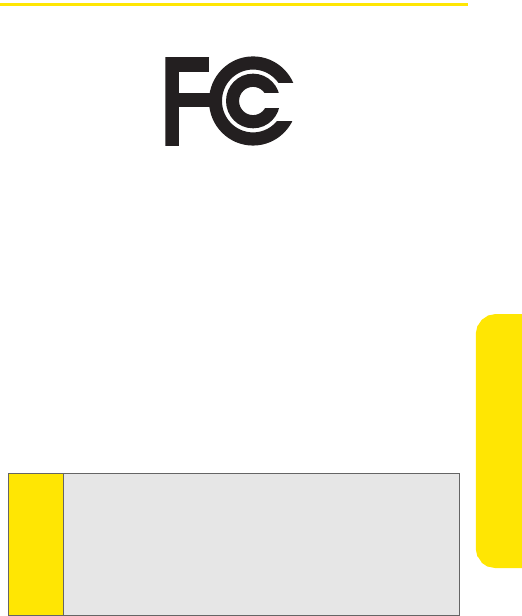
Section 4A: Important Safety Information 196
Important Safety Information
Declaration of Conformity
Per FCC CFR 47 Part 2 Section 2.1077(a)
Responsible Party Name: Motorola, Inc.
Address: 8000 West Sunrise Boulevard
Plantation, FL 33322 USA
Phone Number: 1 (800) 453-0920
Hereby declares that the product:
Product Name: ic502
Model Number: H90XAH9JR7AN
Conforms to the following regulations:
FCC Part 15, subpart B, section 15.107(a), 15.107(d) and section 15.109(a)
Class B Digital Device
As a personal computer peripheral, this device complies with Part 15 of the
FCC Rules. Operation is subject to the following two conditions: (1) this
device may not cause harmful interference, and (2) this device must accept
any interference received, including interference that may cause undesired
operation.
Per FCC Rule Part 15.21 , changes or modifications not expressly
approved by Motorola could void the user's authority to operate this
product..
Note: This equipment has been tested and found to comply with the
limits for a Class B digital device, pursuant to part 15 of the FCC
Rules. These limits are designed to provide reasonable
protection against harmful interference in a residential
installation. This equipment generates,uses and can radiate
radio frequency energy and, if not installed and used in
accordance with the instructions, may cause harmful
interference to radio communications. However, there is no
guarantee that interference will not occur in a particular
installation.
197 Section 4A: Important Safety Information
If this equipment does cause harmful interference to radio or
television reception, which can be determined by turning the
equipment off and on, the user is encouraged to try to correct the
interference by one or more of the following measures:
ⅷReorient or relocate the receiving antenna.
ⅷIncrease the separation between the equipment and receiver.
ⅷConnect the equipment into an outlet on a circuit different from that
to which the receiver is connected.
ⅷConsult the dealer or an experienced radio/TV technician for help.
